Fall 2018
Editor’s Note
On page 1, junior Anna Morrisey describes how Walt Whitman’s “Song of Myself” teaches the reader “to live as part and parcel of the world,” to find the sacred balance between self and other. Building on last issue’s introduction of the Center for Experiential Learning and Global Engagement, this issue of Potash Hill has many such lessons, many ways that Marlboro students have gone beyond their studies to find their “self” in the world.
For example, students traveling to Yellowstone National Park last March were given the opportunity to slow down and be a part of the Rocky Mountains landscape in winter, giving many of them new perspectives on ecology and community. “In a world where a thousand things are constantly demanded of us from technology and social media, that open and focused space is an invitation to connect to ecosystems much larger than us,” says Adam Katrick, Outdoor Program director, who led the trip.
Closer to home, other students are finding new ways to include community governance in their course of study, to balance their individual academic interests with the common good. From recent graduate Andrew Smith Domzal’s exploration of the existential black experience to alumna Jessica Flannery’s intrepid efforts to deliver public health programs in remote, war-torn areas of Africa, this issue brims with diverse lessons about how to be “of the world.”
Despite Adam’s understandable caution about social media mentioned above, I want to take this opportunity to personally invite every Marlboro community member to be part of the world of Branch Out, Marlboro’s very own virtual community. Get connected, find old friends and meet new ones, gain career advice and share memories. And if you have your own lessons about finding the sacred balance between self and other, or any other reactions to this issue of Potash Hill, I hope you’ll share them with me at pjohansson@marlboro.edu.
—Philip Johansson
Inside Front Cover
Potash Hill
Published twice every year, Potash Hill shares highlights of what Marlboro College community members, in both undergraduate and graduate programs, are doing, creating, and thinking. The publication is named after the hill in Marlboro, Vermont, where the college was founded in 1946. “Potash,” or potassium carbonate, was a locally important industry in the 18th and 19th centuries, obtained by leaching wood ash and evaporating the result in large iron pots. Students and faculty at Marlboro no longer make potash, but they are very industrious in their own way, as this publication amply demonstrates.
Alumni Director: Maia Segura ’91
Editor: Philip Johansson
Photo Editor: Richard Smith
Staff Photographers: Clayton Clemetson ’18, Sam Harrison ’20, and David Teter ’19
Design: New Ground Creative
Potash Hill welcomes letters to the editor. Mail them to: Editor, Potash Hill, Marlboro College, P.O. Box A, Marlboro, VT 05344, or send email to pjohansson@marlboro.edu. The editor reserves the right to edit for length letters that appear in Potash Hill.
Front Cover: Blue Clouds, by Cathy Osman. One of several works by retired visual arts faculty Cathy Osman and Tim Segar that were reproduced and inserted in each diploma handed out to graduates at commencement 2018. Learn more about commencement.
About Marlboro College
Marlboro College provides independent thinkers with exceptional opportunities to broaden their intellectual horizons, benefit from a small and close-knit learning community, establish a strong foundation for personal and career fulfillment, and make a positive difference in the world. At our campus in the town of Marlboro, Vermont, students engage in deep exploration of their interests— and discover new avenues for using their skills to improve their lives and benefit others—in an atmosphere that emphasizes critical and creative thinking, independence, an egalitarian spirit, and community.
“This formative experience of leaving family and coming into a new community is something that I think we miss a lot in our Western culture,” says former Outdoor Program director Randy Knaggs ’94. “I think it’s important to pause and ponder what those transitions mean, and be thoughtful about it.” Of course Randy’s referring to Marlboro’s stellar Bridges orientation program, which puts new students together with experienced student leaders to learn about community before they come to campus. We know it’s “so 2017,” but it’s worth sharing the video about last year’s Bridges trips filmed and edited by Patrick Kennedy ’09 (pictured, second from right).
Up Front
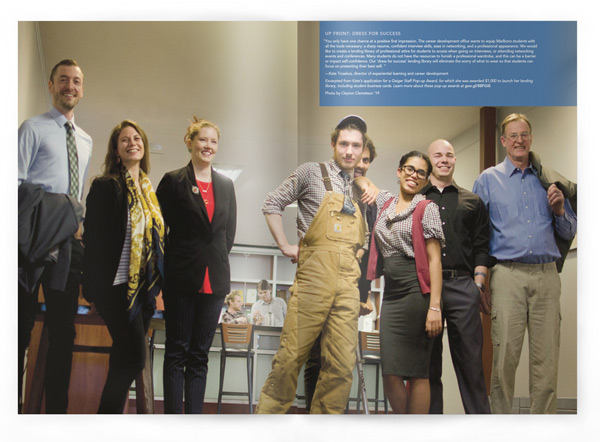
Dress for Success
“You only have one chance at a positive first impression. The career development office wants to equip Marlboro students with all the tools necessary: a sharp resume, confident interview skills, ease in networking, and a professional appearance. We would like to create a lending library of professional attire for students to access when going on interviews, or attending networking events and conferences. Many students do not have the resources to furnish a professional wardrobe, and this can be a barrier or impact self-confidence. Our ‘dress for success’ lending library will eliminate the worry of what to wear so that students can focus on presenting their best self. “
—Kate Trzaskos, director of experiential learning and career development
Excerpted from Kate’s application for a Geiger Staff Pop-up Award, for which she was awarded $1,000 to launch her lending library, including student business cards. Learn more about these pop-up awards.
Photo by Clayton Clemetson ’19
Clear Writing
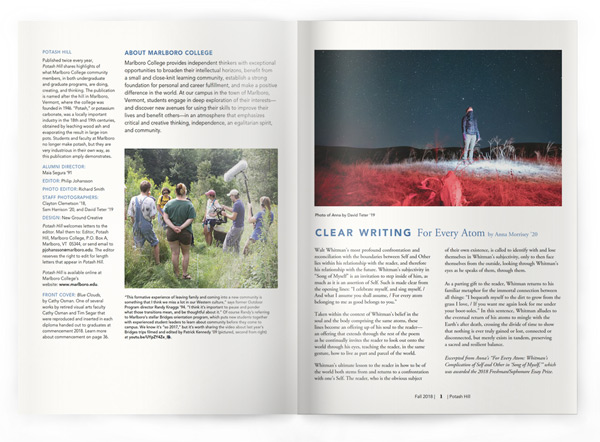
For Every Atom
by Anna Morrisey ’20
Walt Whitman’s most profound confrontation and reconciliation with the boundaries between Self and Other lies within his relationship with the reader, and therefore his relationship with the future. Whitman’s subjectivity in “Song of Myself” is an invitation to step inside of him, as much as it is an assertion of Self. Such is made clear from the opening lines: “I celebrate myself, and sing myself, / And what I assume you shall assume, / For every atom belonging to me as good belongs to you.”
Taken within the context of Whitman’s belief in the soul and the body comprising the same atoms, these lines become an offering up of his soul to the reader— an offering that extends through the rest of the poem as he continually invites the reader to look out onto the world through his eyes, teaching the reader, in the same gesture, how to live as part and parcel of the world.
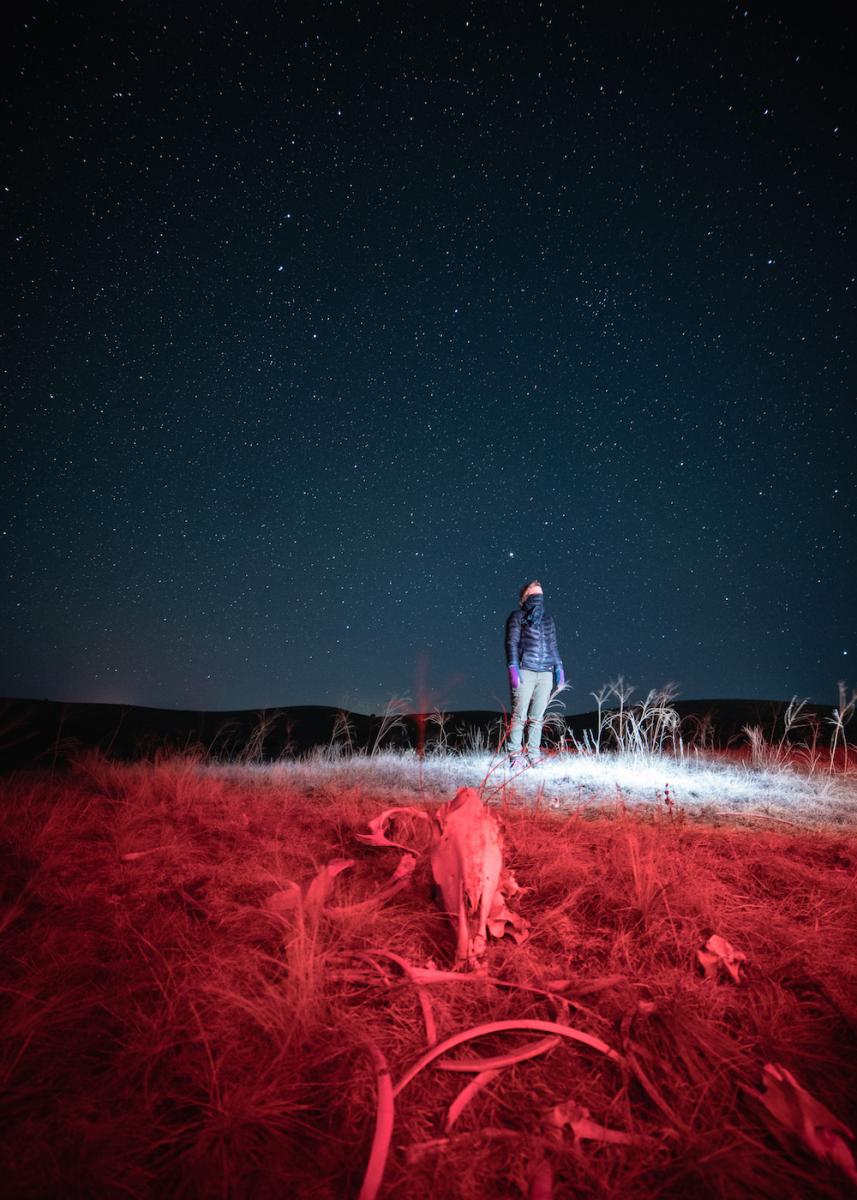 Whitman’s ultimate lesson to the reader in how to be of the world both stems from and returns to a confrontation with one’s Self. The reader, who is the obvious subject of their own existence, is called to identify with and lose themselves in Whitman’s subjectivity, only to then face themselves from the outside, looking through Whitman’s eyes as he speaks of them, through them.
Whitman’s ultimate lesson to the reader in how to be of the world both stems from and returns to a confrontation with one’s Self. The reader, who is the obvious subject of their own existence, is called to identify with and lose themselves in Whitman’s subjectivity, only to then face themselves from the outside, looking through Whitman’s eyes as he speaks of them, through them.
As a parting gift to the reader, Whitman returns to his familiar metaphor for the immortal connection between all things: “I bequeath myself to the dirt to grow from the grass I love, / If you want me again look for me under your boot-soles.” In this sentence, Whitman alludes to the eventual return of his atoms to mingle with the Earth’s after death, crossing the divide of time to show that nothing is ever truly gained or lost, connected or disconnected, but merely exists in tandem, preserving a sacred and resilient balance.
Excerpted from Anna’s “For Every Atom: Whitman’s Complication of Self and Other in ‘Song of Myself,’” which was awarded the 2018 Freshman/Sophomore Essay Prize.
Photo of Anna by David Teter ’19
Letters
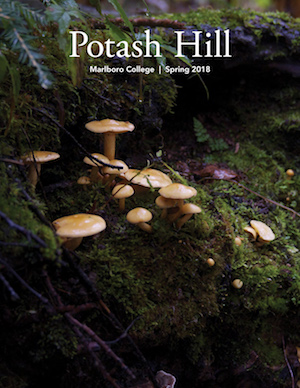 Potash Love
Potash Love
The Spring 2018 edition of Potash Hill is an extremely impressive effort. The photos, the layout, the choice of subjects, and the quality of writing combine to create a very engaging work. Well done!
—Peter Zamore ’74, trustee
Excellent edition, especially Jenny Ramstetter’s article on the successful inclusion of a “forever wild woods” in Marlboro’s reserved forest system. All spellings seem to be in order except for George Weir ’71, the forester who chaired the committee to explore consequences of withdrawal from Vermont’s Use Value Appraisal program. Even Pieter Van Loon ’88 is spelled correctly. Perhaps a safe ruling in George’s case might be “i before e, except after George W.” —John Spicer (dad of Beth Spicer ’80 and Meg Spicer ’86)
The current issue of Potash Hill arrived and has been devoured. As I hope I have told you before, it is probably the best alumni magazine out there—beautifully designed and a great read. Keep up the great work.
—Will Morgan, friend
Cultivating Connection
As we should, we make a great deal out of community at Marlboro College. Let’s continue doing so. But from our point of view what is the most essential, distinctive, and powerful thing about the work we do here is something different. Remarkably, the characteristic of which we speak is largely cultural, not structural. As such, it is fragile and needs constant cultivation. It is certainly supported by our community work, but it deserves a different kind of attention.
Here is what we think we will miss most about teaching. In classes, tutorials, and Plan work, faculty and students at Marlboro form bonds of connection, rigorous effort, and caring that are beyond anything that we have experienced working at seven other, otherwise prestigious colleges. It is that intimate connection built of daily contact and constant refiguring over four years that allows our students not only to complete, but to excel at the immense task of the Plan of Concentration. It is matched by skilled, dedicated staff members and enhanced by a student culture of collective effort. This has been transformative for us and many of our students. All of you know what can happen when the best parts of what we are describing come into alignment. Protect it, renew it, and improve it as Marboro’s most important, powerful, and moving characteristic.
—Tim Segar and Cathy Osman, retired visual arts faculty
Biology as Best Seller
Science dragged me in. I thought, I was a writer; I was a poet; I would have a creative career, goddammit. I brought that skepticism with me to Marlboro, and then I met Bob Engel. It was during one of the first lectures that Bob gave in General Biology.
It was about something really basic and normally quite boring—I want to say the Krebs cycle—but Bob was telling a story, and I could see characters in this Krebs cycle, or whatever it was. And his eyes were lighting up as he was telling us this amazing narrative about it.
And suddenly a light bulb went off in me, and I realized there are stories everywhere in science. I just went down this rabbit hole with it, and I’ve never gone back. I’m still telling stories about science, and I’d like to just say: Bob, it’s your fault, and thank you.
—Molly MacLeod ’08 (pictured, right)
See more memories about the late Bob Engel, beloved biology professor. Do you remember your light bulb moment? Share it with us at pjohansson@marlboro.edu.
View from the Hill
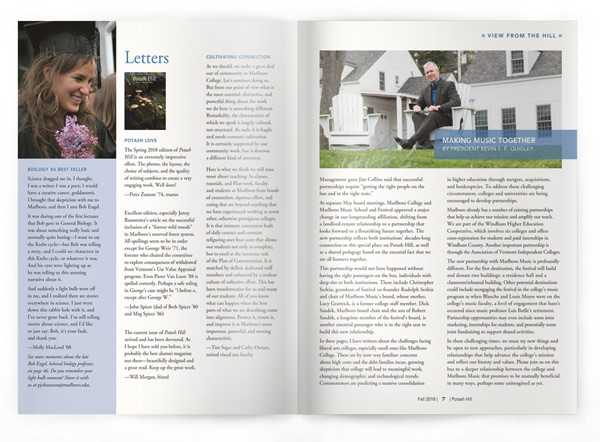
Making Music Together
By President Kevin F. F. Quigley
Management guru Jim Collins said that successful partnerships require “getting the right people on the bus and in the right seats.”
At separate May board meetings, Marlboro College and Marlboro Music School and Festival approved a major change in our longstanding affiliation, shifting from a landlord-tenant relationship to a partnership that looks forward to a flourishing future together. The new partnership reflects both institutions’ decades-long connection to this special place on Potash Hill, as well as a shared pedagogy based on the essential fact that we are all learners together.
This partnership would not have happened without having the right passengers on the bus, individuals with deep ties to both institutions. These include Christopher Serkin, grandson of festival co-founder Rudolph Serkin and chair of Marlboro Music’s board, whose mother, Lucy Gratwick, is a former college staff member. Dick Saudek, Marlboro board chair and the son of Robert Saudek, a longtime member of the festival’s board, is another essential passenger who is in the right seat to build this new relationship.
In these pages, I have written about the challenges facing liberal arts colleges, especially small ones like Marlboro College. These are by now very familiar: concerns about high costs and the debt families incur, growing skepticism that college will lead to meaningful work, changing demographic and technological trends. Commentators are predicting a massive consolidation in higher education through mergers, acquisitions, and bankruptcies. To address these challenging circumstances, colleges and universities are being encouraged to develop partnerships.
Marlboro already has a number of existing partnerships that help us achieve our mission and amplify our reach. We are part of the Windham Higher Education Cooperative, which involves six colleges and offers cross-registration for students and paid internships in Windham County. Another important partnership is through the Association of Vermont Independent Colleges.
The new partnership with Marlboro Music is profoundly different. For the first destination, the festival will build and donate two buildings: a residence hall and a classroom/rehearsal building. Other potential destinations could include reengaging the festival in the college’s music program as when Blanche and Louis Moyse were on the college’s music faculty, a level of engagement that hasn’t occurred since music professor Luis Batlle’s retirement. Partnership opportunities may even include some joint marketing, internships for students, and potentially some joint fundraising to support shared activities.
In these challenging times, we must try new things and be open to new approaches, particularly in developing relationships that help advance the college’s mission and reflect our history and values. Please join us on this bus to a deeper relationship between the college and Marlboro Music that promises to be mutually beneficial in many ways, perhaps some unimagined as yet.
Strengthening Health Systems in Fragile States
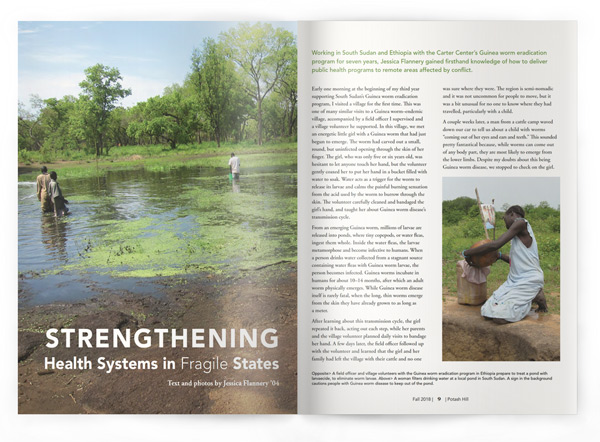
Text and photos by Jessica Flannery ’04
Working in South Sudan and Ethiopia with the Carter Center’s Guinea worm eradication program for seven years, Jessica Flannery gained firsthand knowledge of how to deliver public health programs to remote areas affected by conflict.
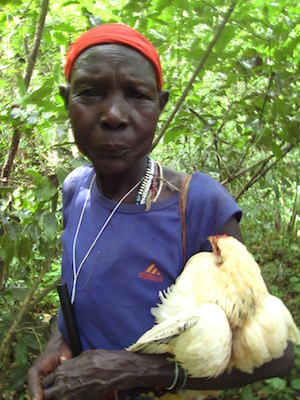 Early one morning at the beginning of my third year supporting South Sudan’s Guinea worm eradication program, I visited a village for the first time. This was one of many similar visits to a Guinea worm–endemic village, accompanied by a field officer I supervised and a village volunteer he supported. In this village, we met an energetic little girl with a Guinea worm that had just begun to emerge. The worm had carved out a small, round, but uninfected opening through the skin of her finger. The girl, who was only five or six years old, was hesitant to let anyone touch her hand, but the volunteer gently coaxed her to put her hand in a bucket filled with water to soak. Water acts as a trigger for the worm to release its larvae and calms the painful burning sensation from the acid used by the worm to burrow through the skin. The volunteer carefully cleaned and bandaged the girl’s hand, and taught her about Guinea worm disease’s transmission cycle.
Early one morning at the beginning of my third year supporting South Sudan’s Guinea worm eradication program, I visited a village for the first time. This was one of many similar visits to a Guinea worm–endemic village, accompanied by a field officer I supervised and a village volunteer he supported. In this village, we met an energetic little girl with a Guinea worm that had just begun to emerge. The worm had carved out a small, round, but uninfected opening through the skin of her finger. The girl, who was only five or six years old, was hesitant to let anyone touch her hand, but the volunteer gently coaxed her to put her hand in a bucket filled with water to soak. Water acts as a trigger for the worm to release its larvae and calms the painful burning sensation from the acid used by the worm to burrow through the skin. The volunteer carefully cleaned and bandaged the girl’s hand, and taught her about Guinea worm disease’s transmission cycle.
From an emerging Guinea worm, millions of larvae are released into ponds, where tiny copepods, or water fleas, ingest them whole. Inside the water fleas, the larvae metamorphose and become infective to humans. When a person drinks water collected from a stagnant source containing water fleas with Guinea worm larvae, the person becomes infected. Guinea worms incubate in humans for about 10– 14 months, after which an adult worm physically emerges. While Guinea worm disease itself is rarely fatal, when the long, thin worms emerge from the skin they have already grown to as long as a meter.
After learning about this transmission cycle, the girl repeated it back, acting out each step, while her parents and the village volunteer planned daily visits to bandage her hand. A few days later, the field officer followed up with the volunteer and learned that the girl and her family had left the village with their cattle and no one was sure where they were. The region is semi-nomadic and it was not uncommon for people to move, but it was a bit unusual for no one to know where they had travelled, particularly with a child.
A couple weeks later, a man from a cattle camp waved down our car to tell us about a child with worms “coming out of her eyes and ears and teeth.” This sounded pretty fantastical because, while worms can come out of any body part, they are most likely to emerge from the lower limbs. Despite my doubts about this being Guinea worm disease, we stopped to check on the girl.
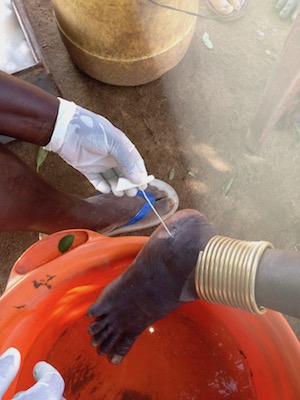 We were led to a little girl whose legs were covered in pustules, many with emerging worms. As the field officer slowly cleaned her legs, I realized that this little girl, who was in so much pain that she could barely walk, was the same girl who had been so lively just weeks before. She did not have worms coming out of eyes or ears or teeth, but she had worms coming from all over her body, nearly 25 altogether, most from her legs.
We were led to a little girl whose legs were covered in pustules, many with emerging worms. As the field officer slowly cleaned her legs, I realized that this little girl, who was in so much pain that she could barely walk, was the same girl who had been so lively just weeks before. She did not have worms coming out of eyes or ears or teeth, but she had worms coming from all over her body, nearly 25 altogether, most from her legs.
The field officer massaged out some of the worms, cleaned the sores with soap and water, used a topical antibiotic, made sure the girl was well bandaged, and taught her mother how to bandage her, as there was no volunteer in the camp. We made plans to return the next day with more supplies and to help residents select village volunteers. When we came back, less than 24 hours later, the girl was walking around outside her house, tentatively, but recovering.
Treating this little girl led to working with her family and community to put systems into place to keep people from becoming infected: preventing those with emerging worms from entering water, providing simple filters to remove the water fleas from drinking water, and teaching people how to use and care for the filters. We also located potentially infected water sources in the area and targeted them for treatment with a larvaecide. We were able to identify other people connected with the girl who had Guinea worm, leading us to other communities.
At the time of our visit, in 2009, transmission had been stopped in all but four countries: Mali, Ethiopia, Chad, and South Sudan. The program’s focus on a single result—stopping Guinea worm transmission—led us to implement a clear set of interventions in a responsive and flexible manner, based on the conditions on the ground. This was supported by strong national leadership, sufficient resources, and close connections with communities.
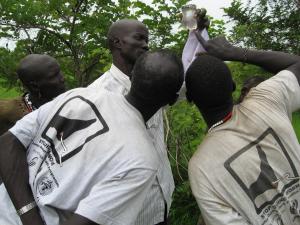 At the same time, this girl, who was treated largely by having her legs cleaned with soap and water, had no access to a health facility, clean water, or other basic infrastructure that supports health. As we worked in communities, people with many other illnesses—women with obstetric emergencies, children with malaria, adults with tuberculosis—were brought to me for treatment because they had no access to health services. I am not a medical doctor and there was little I could do.
At the same time, this girl, who was treated largely by having her legs cleaned with soap and water, had no access to a health facility, clean water, or other basic infrastructure that supports health. As we worked in communities, people with many other illnesses—women with obstetric emergencies, children with malaria, adults with tuberculosis—were brought to me for treatment because they had no access to health services. I am not a medical doctor and there was little I could do.
In Guinea worm eradication, I saw clearly just how possible it is to achieve health results when those results are focused and interventions are responsive, even in a complex, war-torn country with minimal infrastructure. It was just as clear that a health sector response to really improving health outcomes for all the people and communities we worked with would require the development of a sustainable health system.
For example, in the Guinea worm eradication program I worked with many staff who started out as field officers or village volunteers. One new field officer had trouble using a calculator and filling out, much less overseeing, reporting forms. Other staff teased him because he was slow in answering questions.
We worked together patiently, visiting volunteers and supervising villages. Other supervisors also supported him at times, offering different perspectives. He developed relationships with communities and leaders, and he worked diligently and constantly. After a while, when I visited his area, his volunteers were among the strongest and most motivated. In the communities he covered, effective filter use was high and community leaders were engaged. Eventually, he became a supervisor. Like many others I encountered, he was a living example of how capacity can be developed in an individual, and over time within a program and the system as a whole.
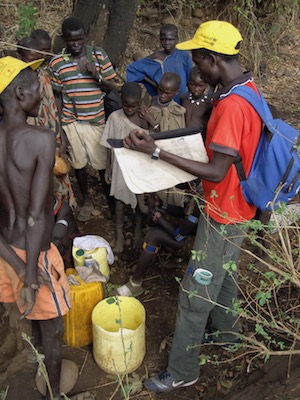 Working in this very successful program, I became interested in how whole health systems can be built within complex, conflict-impacted environments, often termed “fragile states.” In the final year of my doctoral program in public health, I worked as a consultant with the Global Financing Facility, a global partnership aiming to improve reproductive, maternal, newborn, child, and adolescent health and nutrition (RMNCAHN).
Working in this very successful program, I became interested in how whole health systems can be built within complex, conflict-impacted environments, often termed “fragile states.” In the final year of my doctoral program in public health, I worked as a consultant with the Global Financing Facility, a global partnership aiming to improve reproductive, maternal, newborn, child, and adolescent health and nutrition (RMNCAHN).
At the time, Liberia had just completed their national plan to improve RMNCAHN. One key question was how to build sustainable capacity for health systems management at the county level. Having experienced warand the Ebola epidemic, Liberia’s many years of technical assistance had often replaced capacity with foreign expertise, instead of developing local capacity. This happens largely because the success of a technical assistance agency is frequently equated with the quality of outputs, such as the number of reports submitted, often leading these agencies to do the local health management team’s work. In addition, “capacity development” is often used almost synonymously with training, or developing skills, while there are many other aspects to capacity such as the ability to draw on other people and to adapt to changing circumstances.
Working with Liberia’s Ministry of Health, we visited county health teams and helped to identify the challenges with health system management at the county level. We found that while staff had plenty of trainings, challenges persisted in structures, communication, adapting to difficult circumstances, and other aspects of capacity. These challenges called for a broader view of capacity development, drawing on a “complex adaptive systems” approach. This approach studies how different parts of a system impact each other in multiple different ways. A complex adaptive systems approach to capacity development looks at a range of aspects including relationships, integration of different parts of the system, and adaptability. This broader view aims to develop the capacity of the whole organization to sustain itself through staffing changes, conflict, and other shocks.
With the Ministry of Health, we developed a way to assess capacity using simulations and other practical tests, with the goal of allowing a technical assistance agency to be paid based on the county health team’s actual capacity instead of outputs. This way, the technical assistance agency can be flexible in figuring out ways to develop capacity more effectively and achieve results while developing actual capacity. We hope that this approach, which will be tested in the coming year, will help develop capacity that stays in place after technical assistance leaves.
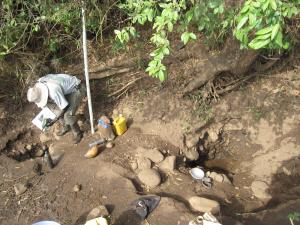 This broader approach to health services helps fill in some of the gaps I saw while working in South Sudan: how can we move from supporting a single disease to supporting the whole system in a way that facilitates long-term change? It’s also an approach that is very much adapted to local context, allows for flexibility in implementation, and can be tested and adapted to solve ongoing challenges.
This broader approach to health services helps fill in some of the gaps I saw while working in South Sudan: how can we move from supporting a single disease to supporting the whole system in a way that facilitates long-term change? It’s also an approach that is very much adapted to local context, allows for flexibility in implementation, and can be tested and adapted to solve ongoing challenges.
In my work in fragile states like South Sudan and Liberia, I have found that clarity of goal, along with space to try out different approaches, is critical. It’s also important to account for interactions between different, but interconnected, pieces: different types of knowledge, systems for learning, and systems for adaptation. It’s about using an approach that isn’t prescriptive, that lets people at all levels try things out and learn from them. Ultimately, a sustainable health system is more about engaging in a process than finding a single approach.
Jessica Flannery worked for the Carter Center in South Sudan for over five years. In March of 2018, she received her doctor of public health degree from the Harvard TH Chan School of Public Health. She is currently a consultant with the Global Financing Facility and World Bank.
 From Child Soldier to Graduate Student
From Child Soldier to Graduate Student
Garang Buk Buk, a former child soldier in South Sudan’s brutal civil war, is a shining example of Jessica’s argument for the power of effective capacity development. Defying the odds, Garang worked with the Guinea worm eradication program, saving up enough money to pay for his undergraduate education in Nairobi, Kenya. Now he has been accepted to Emory University for a master’s in development practice, with the goal of returning to South Sudan to better his community. Learn more about the New Jersey high school class that is supporting Garang’s graduate school efforts, and contribute at: gofundme.com/get-garang-to-emory.
Law and Order in North Africa 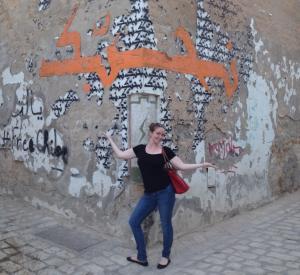 “My greatest hope is to see the establishment of stable political systems that exist to serve the needs of the citizens, rather than to perpetuate themselves and protect their own interests,” says Amelia Fanelli ’18 who focused her Plan on the politics of North African regimes. “In my opinion, any movement in this direction would be a positive development.” Although she had been drawn to politics and law since childhood, as a World Studies Program student Amelia did her internship in Tunisia, and became interested in the constitutions of North African nations. “After returning from Tunisia, I was unsure how I would shape my experiences into a piece of written work, and I found the answer through combining my interest in politics and North Africa with my interest in written law,” she says.
“My greatest hope is to see the establishment of stable political systems that exist to serve the needs of the citizens, rather than to perpetuate themselves and protect their own interests,” says Amelia Fanelli ’18 who focused her Plan on the politics of North African regimes. “In my opinion, any movement in this direction would be a positive development.” Although she had been drawn to politics and law since childhood, as a World Studies Program student Amelia did her internship in Tunisia, and became interested in the constitutions of North African nations. “After returning from Tunisia, I was unsure how I would shape my experiences into a piece of written work, and I found the answer through combining my interest in politics and North Africa with my interest in written law,” she says.
“A Thing of Beauty…”
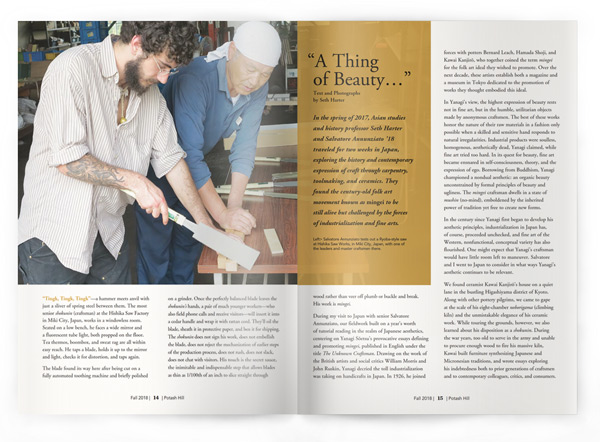
Text and Photographs by Seth Harter
In the spring of 2017, Asian studies and history professor Seth Harter and Salvatore Annunziato ’18 traveled for two weeks in Japan, exploring the history and contemporary expression of craft through carpentry, toolmaking, and ceramics. They found the century-old folk art movement known as mingei to be still alive but challenged by the forces of industrialization and fine arts.
“Tingk, Tingk, Tingk”—a hammer meets anvil with just a sliver of spring steel between them. The most senior shokunin (craftsman) at the Hishika Saw Factory in Miki City, Japan, works in a windowless room. Seated on a low bench, he faces a wide mirror and a fluorescent tube light, both propped on the floor. Tea thermos, boombox, and sweat rag are all within easy reach.
He taps a blade, holds it up to the mirror and light, checks it for distortion, and taps again. The blade found its way here after being cut on a fully automated toothing machine and briefly polished on a grinder. Once the perfectly balanced blade leaves the shokunin’s hands, a pair of much younger workers—who also field phone calls and receive visitors—will insert it into a cedar handle and wrap it with rattan cord. They’ll oil the blade, sheath it in protective paper, and box it for shipping. The shokunin does not sign his work, does not embellish the blade, does not reject the mechanization of earlier steps of the production process, does not rush, does not slack, does not chat with visitors. His touch is the secret sauce, the inimitable and indispensable step that allows blades as thin as 1/100th of an inch to slice straight through wood rather than veer off plumb or buckle and break. His work is mingei.
During my visit to Japan with senior Salvatore Annunziato, our fieldwork built on a year’s worth of tutorial reading in the realm of Japanese aesthetics, centering on Yanagi Sōetsu’s provocative essays defining and promoting mingei, published in English under the title The Unknown Craftsman. Drawing on the work of the British artists and social critics William Morris and John Ruskin, Yanagi decried the toll industrialization was taking on handicrafts in Japan. In 1926, he joined forces with potters Bernard Leach, Hamada Shoji, and Kawai Kanjirō, who together coined the term mingei for the folk art ideal they wished to promote. Over the next decade, these artists establish both a magazine and a museum in Tokyo dedicated to the promotion of works they thought embodied this ideal.
In Yanagi’s view, the highest expression of beauty rests not in fine art, but in the humble, utilitarian objects made by anonymous craftsmen. The best of these works honor the nature of their raw materials in a fashion only possible when a skilled and sensitive hand responds to natural irregularities. Industrial products were soulless, homogenous, aesthetically dead, Yanagi claimed, while fine art tried too hard. In its quest for beauty, fine art became ensnared in self-consciousness, theory, and the expression of ego. Borrowing from Buddhism, Yanagi championed a nondual aesthetic: an organic beauty unconstrained by formal principles of beauty and ugliness. The mingei craftsman dwells in a state of mushin (no-mind), emboldened by the inherited power of tradition yet free to create new forms.
In the century since Yanagi first began to develop his aesthetic principles, industrialization in Japan has, of course, proceeded unchecked, and fine art of the Western, nonfunctional, conceptual variety has also flourished. One might expect that Yanagi’s craftsman would have little room left to maneuver. Salvatore and I went to Japan to consider in what ways Yanagi’s aesthetic continues to be relevant.
We found ceramist Kawai Kanjirō’s house on a quiet lane in the bustling Higashiyama district of Kyoto. Along with other pottery pilgrims, we came to gape at the scale of his eight-chamber noborigama (climbing kiln) and the unmistakable elegance of his ceramic work. While touring the grounds, however, we also learned about his disposition as a shokunin. During the war years, too old to serve in the army and unable to procure enough wood to fire his massive kiln, Kawai built furniture synthesizing Japanese and Micronesian traditions, and wrote essays exploring his indebtedness both to prior generations of craftsmen and to contemporary colleagues, critics, and consumers. His writings were later published under the title We Do Not Work Alone. Following Yanagi’s principles, Kawai refused to sign his work and initially declined his designation by the Japanese government as a Living National Treasure, a post-war system of recognition and support meant to enhance the status of crafts in the country. Rejecting this security, he drove himself to ever-greater levels of production and to an ever-expanding aesthetic vocabulary.
While Kawai’s legacy is borne mostly in the clay, fellow ceramist and Yanagi associate Hamada Shoji’s impact has been much broader. In 1925, when Hamada moved to the town of Mashiko, a few hours north of Tokyo, its small scale ceramics production was overshadowed by the older kiln sites in central Japan. Today the town is home to more than 300 ceramic artists, and smoke from the wood-fired kilns wreaths the surrounding hills. Hamada’s influence is everywhere: in his Reference Collection housed on the site of his former studio; in the provincial ceramics museum; in the larger galleries that feature, usually alone in Lucite cases, original Hamada pots; and in the ubiquitous glazing patterns he made famous—sugarcane stalks, abstract swirls, combed lines—decorating the work of his successors.
Craft is unquestionably alive and well in Mashiko. While there, Salvatore and I stayed at Furuki, home to the Mashiko Ceramics Arts Club. Three generations of the proprietor’s family spilled in and out of the compound, overseeing the firing of a collection of work made by a group of local retirees, training two American apprentices, providing studio space to neighboring amateurs, and teaching classes to student groups from Tokyo. But when I imagine Yanagi walking through Mashiko today, I picture him scowling. Mashiko is, from a mingei perspective, a victim of Hamada’s success.
The best contemporary potters in Mashiko, like Ken Matsuzaki, regularly exhibit their works in the top galleries of London and New York. Hamada originals are more likely to be found under the watchful eye of a museum guard or shop proprietor than filled with tea, perched on the edge of a workbench. Japan’s prosperity and love of ceramic arts have meant that Mashiko potters can make a good living, but they do so as individuals, as artists who sign their work, who promote distinct aesthetic brands. They’re a far cry from Yanagi’s innocent 16th-century farmer whose rice bowls were perfect for being untainted by too much aesthetic theory.
That pottery should have become more art than craft is perhaps, to a Western audience, no surprise. When we ventured to the Takenaka Carpentry Tools Museum in Kobe, however, we discovered that wood plane making, too, had undergone this dubious elevation. On approaching the serene villa housing the museum, perfectly adzed cypress doors parted noiselessly before us. An exhibit dedicated to the development of woodworking tools in Japan pays homage to the skills and travails of unknown craftsmen, but the culmination of the exhibit is a section called “Exquisite Works of Master Craftsmen,” where individual blades with poetic names bathe in spotlit glory. These tools may once have been used to build temple roofs and kitchen hearths, but now the grime of the whetstone and the oil of the shokunin’s fingers have been wiped from them and they have become fetishized examples of abstract beauty. The names of the foremost blade forgers are not only known and displayed, but are used almost like imperial reign titles to orient the viewer chronologically: such-and-such a blade is from the Chiyozuru Korehide era. In the next room, a model teahouse and a shoji (sliding lattice door) likewise showed us how utilitarian objects can, with sufficient skill, patience, and money, transcend the everyday and provoke in the viewer a distancing awe.
Back in neighboring Miki City, where we first met the saw factory shokunin, the president of the Tsunesaburo Plane Blade Company had other things to worry about. Uozumi Akio’s three sons had all rejected the chance to follow in their father’s footsteps. The market in Japan for traditional hand tools was contracting, and tool makers of Miki City were concerned that their best days might be behind them. Retooling, so to speak, would not be easy. The city’s fortunes were established in the 16th century when the ruler of the region, Nagaharu Bessho, surrendered to the unifier Hideyoshi Toyotomi. In exchange for Bessho’s head, Hideyoshi relocated to Miki a group of talented blacksmiths (prisoners of war from his campaigns in Korea) and granted tax remissions for local industry. Miki’s fame and fortune as Hardware City was insured for 400 years, but what lies ahead for this craft-driven industry?
Seated in an office stacked with whetstones, blades, orders, and invoices, Uozumi told us that future prosperity depended on extending the market for his wares overseas. He and his workers would have to be sensitive both to the characteristics of their metal—a mix of Hitachi blue paper steel and iron salvaged from 19th-century railroads and shipping enterprises—but also to the changing demands of their customers. In this disposition, the president of a major tool manufacturer showed how few steps removed he was from the thinking of a shokunin. Tsuensaburo Plane Blade Company would survive by producing planes that were beautiful, not to look at in a gallery but to pull across a plank of cedar. I could see Yanagi smiling.
Seth Harter is professor of Asian studies and history. He recently studied temple architecture and joinery in Kyoto and Nara, and apprenticed with renowned chair-maker Tak Yoshino in Kawaguchiko, Japan, during his spring 2018 sabbatical. His visit to Japan with Salvatore was made possible by support from an Aron Grant and the Endeavor Foundation.
Counter-Industrial Ceramics 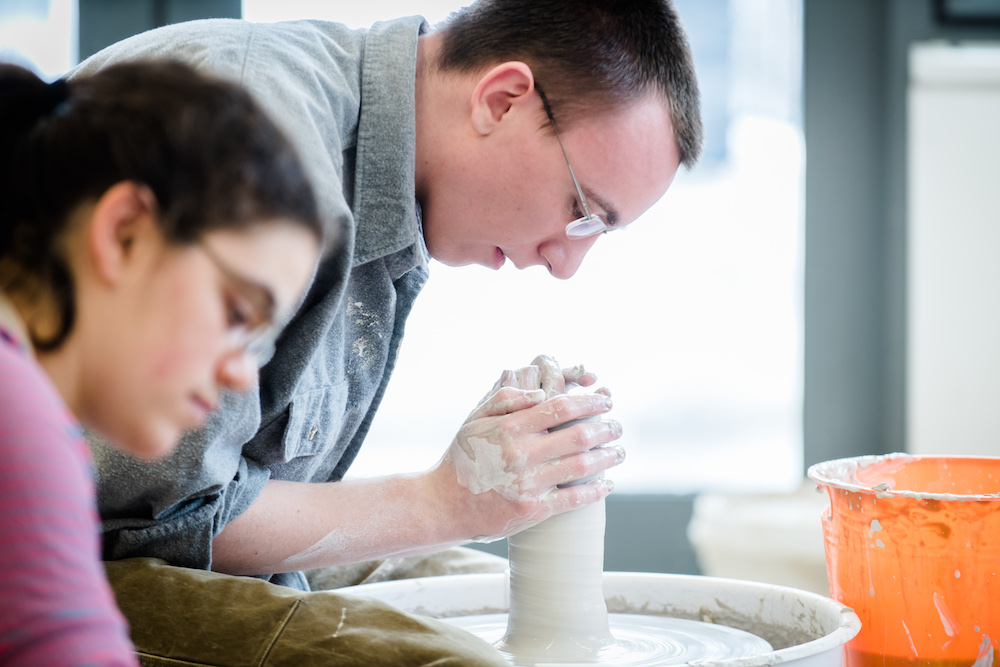 Seth’s deep exploration of Asian craft traditions have inspired more than one visual arts student. “The mingei movement, a counter-industrial craft movement in the 1920s and ’30s, is interesting to me,” says senior Henry Robinson, who studies ceramics and drawing at Marlboro. “It’s about bringing ceramics and art to a wider audience through skills and traditions.” The utilitarian approach to craft appeals to Henry, who can usually be found in the ceramics studio perfecting his skills. “I don’t want to just emulate this movement but instead make something that’s a little more personal to me that can also be useful—not these high-art objects. It would be one thing to bring art to a lot of people, but it’s another to create things that are really interesting.” Learn more about Henry.
Seth’s deep exploration of Asian craft traditions have inspired more than one visual arts student. “The mingei movement, a counter-industrial craft movement in the 1920s and ’30s, is interesting to me,” says senior Henry Robinson, who studies ceramics and drawing at Marlboro. “It’s about bringing ceramics and art to a wider audience through skills and traditions.” The utilitarian approach to craft appeals to Henry, who can usually be found in the ceramics studio perfecting his skills. “I don’t want to just emulate this movement but instead make something that’s a little more personal to me that can also be useful—not these high-art objects. It would be one thing to bring art to a lot of people, but it’s another to create things that are really interesting.” Learn more about Henry.
Anti-Essentialism in Black Thought
By Andrew Smith Domzal ’18
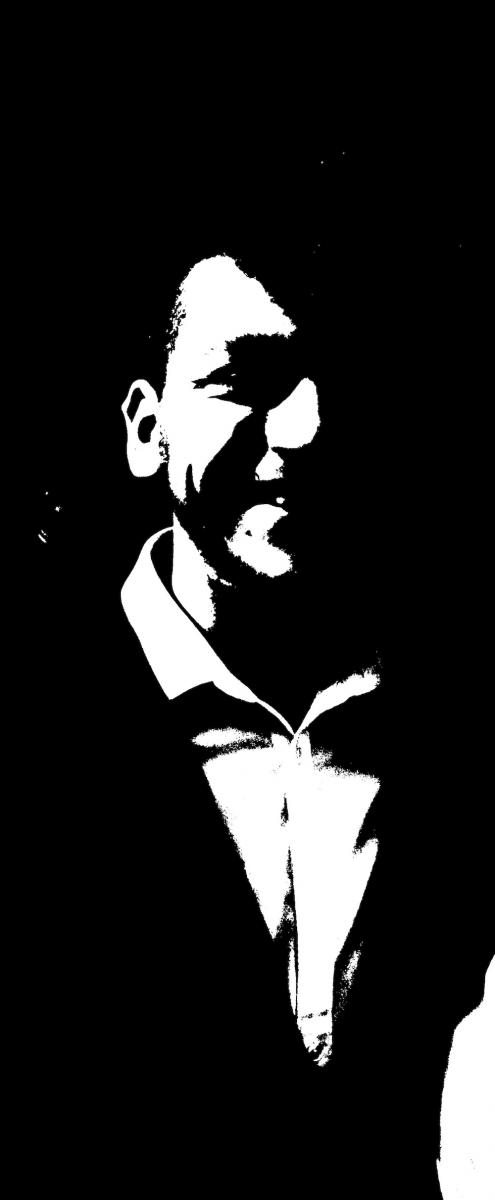 Existentialist thought is useful when discussing race, because it discards any essential qualities that a person might have and focuses on lived experience. There is nothing essential about being a black person: black people are all unique and distinct. That being said, because of the historical conditions that we are born into and that shape us—because there have been social structures that judge black people in certain ways and the dominant culture holds essentialized views of black people—there is a shared experience of being black in the world.
Existentialist thought is useful when discussing race, because it discards any essential qualities that a person might have and focuses on lived experience. There is nothing essential about being a black person: black people are all unique and distinct. That being said, because of the historical conditions that we are born into and that shape us—because there have been social structures that judge black people in certain ways and the dominant culture holds essentialized views of black people—there is a shared experience of being black in the world.
In Color Conscious: The Political Morality of Race, Kwame Anthony Appiah writes, “We make up selves from a tool kit of options made available by our culture and society…. We do make choices, but we don’t determine the options among which we choose.”
We exist in a society that has a specific history, which determines our options. Black people are born into a world where being black has certain connotations affecting their being-in-the-world. They are seen as, and given an essence as, other. This is existentially insulting, and breeds resentment by subsuming any freedom to choose the self. Recently—among biologists, social activists, and progressives—many have accepted that race is a social construct rather than a fact of biology. However, realizing that race is a social construct does not remove any of its power in the world, nor does it lessen its effect on the black person’s life.
Even positive scripts about black essentialism and normativity have the potential to be problematic. In the case of the Black Power movement—turning the old script of self-hatred into a new script in which one asks to be respected as a black—Appiah writes, “Someone who takes autonomy seriously will want to ask whether we have not replaced one kind of tyranny with another. If I had to choose between Uncle Tom and Black Power, I would, of course, choose the latter. But I would like not to have to choose. I would like other options.”
In order to truly liberate black existence we must understand blackness as a shared way of existing and not as a requirement of specific action. Blackness should be as diverse as the human spectrum in terms of actions, interests, dress, and so forth. In the existentialist perspective, discarding essences while still understanding the power of social constructs to determine life can tell one much about the black experience.
This essay is excerpted and adapted from one section of Andrew’s Plan, which is titled “‘I am fully what I am’: Philosophy, literature, and the lived experience of race.” Andrew is now living in Leuven, Belgium, and is enrolled in a master’s program in philosophy at the Catholic University of Leuven.
On and Off the Hill
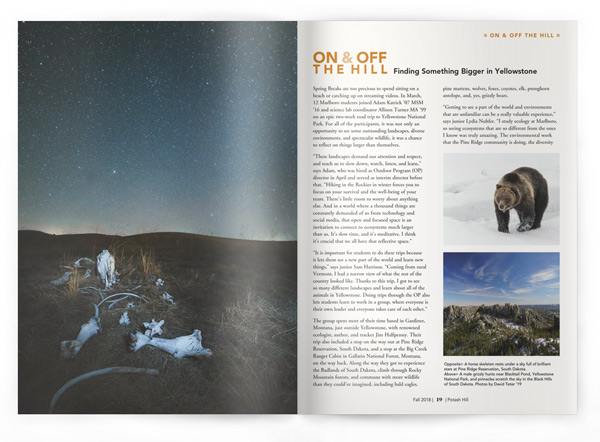
Finding Something Bigger in Yellowstone
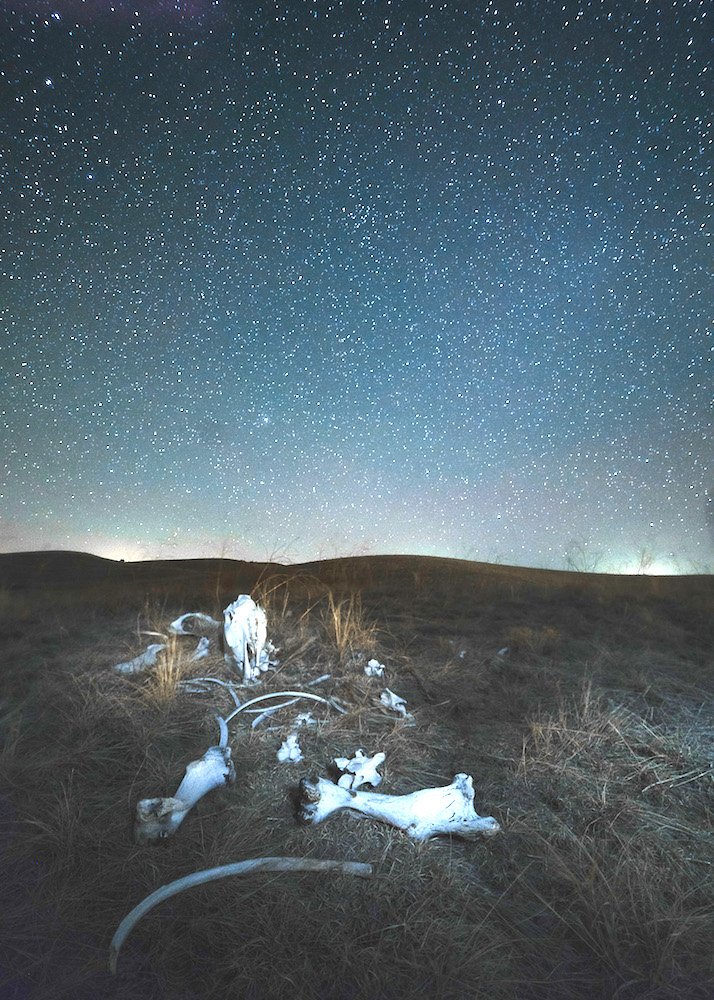 Spring Breaks are too precious to spend sitting on a beach or catching up on streaming videos. In March, 12 Marlboro students joined Adam Katrick ’07 MSM ’16 and science lab coordinator Allison Turner MA ’99 on an epic two-week road trip to Yellowstone National Park. For all of the participants, it was not only an opportunity to see some outstanding landscapes, diverse environments, and spectacular wildlife, it was a chance to reflect on things larger than themselves.
Spring Breaks are too precious to spend sitting on a beach or catching up on streaming videos. In March, 12 Marlboro students joined Adam Katrick ’07 MSM ’16 and science lab coordinator Allison Turner MA ’99 on an epic two-week road trip to Yellowstone National Park. For all of the participants, it was not only an opportunity to see some outstanding landscapes, diverse environments, and spectacular wildlife, it was a chance to reflect on things larger than themselves.
“These landscapes demand our attention and respect, and teach us to slow down, watch, listen, and learn,” says Adam, who was hired as Outdoor Program (OP) director in April and served as interim director before that. “Hiking in the Rockies in winter forces you to focus on your survival and the well-being of your team. There’s little room to worry about anything else. And in a world where a thousand things are constantly demanded of us from technology and social media, that open and focused space is an invitation to connect to ecosystems much larger than us. It’s slow time, and it’s meditative. I think it’s crucial that we all have that reflective space.”
“It is important for students to do these trips because it lets them see a new part of the world and learn new things,” says junior Sam Harrison. “Coming from rural Vermont, I had a narrow view of what the rest of the country looked like. Thanks to this trip, I got to see so many different landscapes and learn about all of the animals in Yellowstone. Doing trips through the OP also lets students learn to work in a group, where everyone is their own leader and everyone takes care of each other.”
The group spent most of their time based in Gardiner, Montana, just outside Yellowstone, with renowned ecologist, author, and tracker Jim Halfpenny. Their trip also included a stop on the way out at Pine Ridge Reservation, South Dakota, and a stop at the Big Creek Ranger Cabin in Gallatin National Forest, Montana, on the way back. Along the way they got to experience the Badlands of South Dakota, climb through Rocky Mountain forests, and commune with more wildlife than they could’ve imagined, including bald eagles, pine martens, wolves, foxes, coyotes, elk, pronghorn antelope, and, yes, grizzly bears.
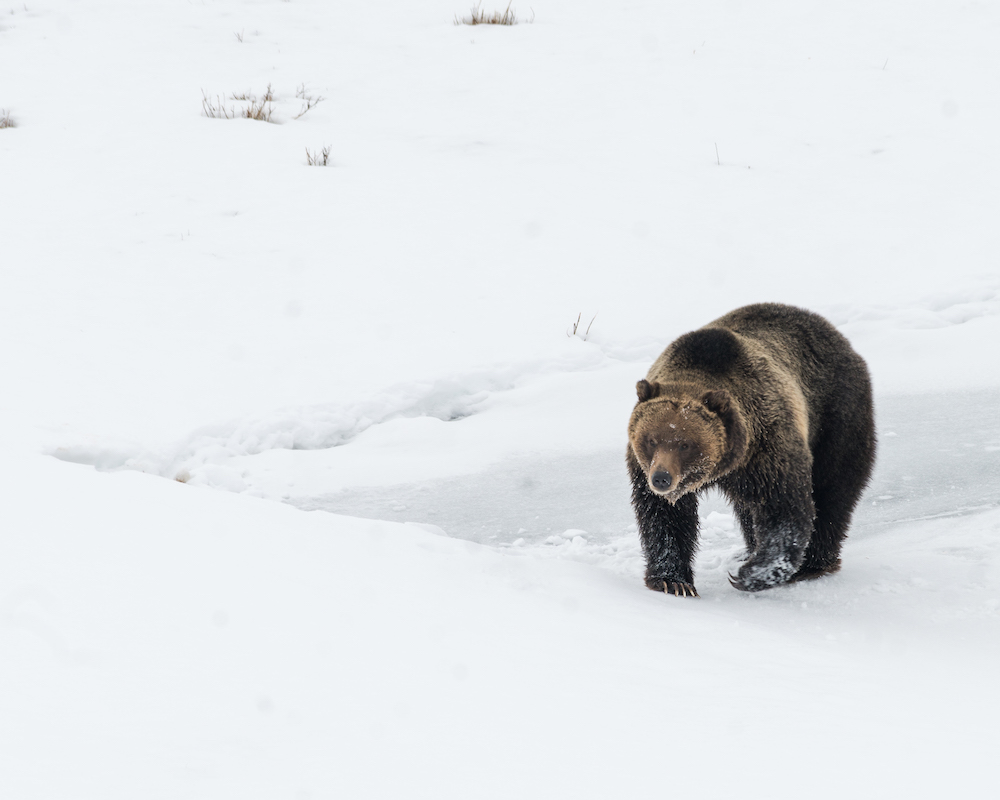 “Getting to see a part of the world and environments that are unfamiliar can be a really valuable experience,” says junior Lydia Nuhfer. “I study ecology at Marlboro, so seeing ecosystems that are so different from the ones I know was truly amazing. The environmental work that the Pine Ridge community is doing, the diversity of species and landscapes along the way, and the interactions with wildlife ecologists that I was able to experience absolutely tie into my studies.”
“Getting to see a part of the world and environments that are unfamiliar can be a really valuable experience,” says junior Lydia Nuhfer. “I study ecology at Marlboro, so seeing ecosystems that are so different from the ones I know was truly amazing. The environmental work that the Pine Ridge community is doing, the diversity of species and landscapes along the way, and the interactions with wildlife ecologists that I was able to experience absolutely tie into my studies.”
Like other OP expeditions through the years, the Yellowstone trip gave students the opportunity to engage with people they might not otherwise, like the Oglala Sioux community of the Pine Ridge Reservation or wildlife photographer Dan Hartman. It also provided many opportunities for leadership development—from planning menus to leading hikes or other activities— building skills and confidence that that will help students be more effective leaders for Bridges orientation trips, or in their future workplaces.
“The highlight of my trip was definitely staying in a Forest Service cabin in Gallatin National Forest on our way home,” says junior Claire O’Pray. “One of the days we were there four of us bush-whacked up the mountain that was behind the cabin. Mountains are my favorite thing in the world, and being confident enough to hike a mountain without a trail was really amazing. We also made split pea soup from scratch on a wood cookstove.”
“These expedition trips have so many experiences rolled into two intense weeks, that we rely on the participants’ individual skills, talents, and unique leadership styles to make it through each day,” says Adam. “We learn a lot about each other, have plentiful opportunities to share our skills with one another, and concurrently, grow and learn.” But for many of the participants, the highlight of the trip was seeing a male grizzly bear lumbering toward Blacktail Pond, at the northern end of the park. It was their last full day in the park, and they had not seen one yet—in fact they had been told it was extremely unlikely, even in Yellowstone—and there they were, 200 feet away and watching this huge bear break through the ice to find his next meal.
“That was pretty breathtaking, and so was simultaneously watching the look on Della’s face,” says Adam, referring to sophomore Della Dolcino. “She really wanted to see a bear, and was just in awe with tears of joy. To watch someone connect so profoundly to that bear, and that landscape…it was an amazing moment. We saw so much wildlife, but seeing that bear really just made us drop everything we were doing so we could set up our scopes and watch. All we could do was stand there and smile and shake our heads. It was spectacular.”
Adam asserts, and the students who joined him and Allison would surely concur, that the hands-on, experiential learning that takes place on OP trips like this one to Yellowstone is an essential counterpart to classroom work. He says, “When these trips are in their element, whether the Rocky Mountains or the Green Mountains, they provide the perfect environment for ‘aha’ moments and fuel for better learning.”
Creative Collaboration in Oaxaca
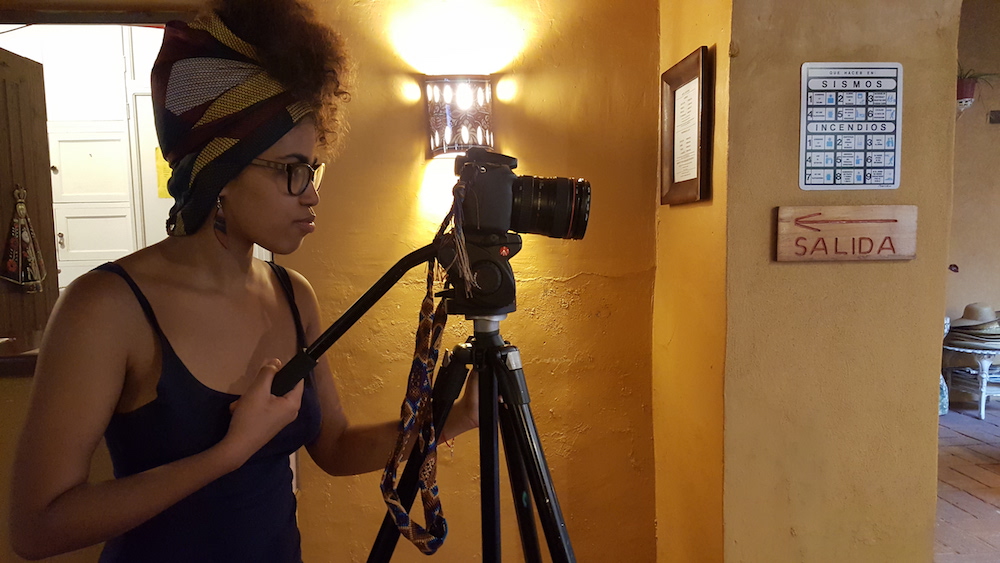 One of the most diverse states in Mexico, Oaxaca has a vibrant mix of indigenous cultures, cuisine, art, and folkloric traditions, with 17 distinct ethnic groups and more than 50 spoken dialects. For the spring semester, professors Rosario de Swanson (Spanish language and literature) and Brad Heck (video and film studies) co-taught a course titled Oaxaca: Cultural Exchange and Creative Collaboration, which culminated with a visit to the region in May.
One of the most diverse states in Mexico, Oaxaca has a vibrant mix of indigenous cultures, cuisine, art, and folkloric traditions, with 17 distinct ethnic groups and more than 50 spoken dialects. For the spring semester, professors Rosario de Swanson (Spanish language and literature) and Brad Heck (video and film studies) co-taught a course titled Oaxaca: Cultural Exchange and Creative Collaboration, which culminated with a visit to the region in May.
“Besides learning about the cultural diversity and history of Oaxaca, during the course of the semester our students communicated with students from the Oaxacan Learning Center,” says Rosario. This grassroots center provides academic tutoring and social-service support to low-income students from underserved urban neighborhoods and indigenous rural villages throughout the state of Oaxaca. “Through regular Skype sessions with their Oaxacan counterparts, they created a film script that was then shot during our two-week stay.”
Prior to their trip, the students organized a raffle as a fundraiser for the Oaxacan Learning Center, raising nearly $500, which they presented to the center on behalf of Marlboro College. “We hope to continue collaborating with this institution, which helps students serve as role models for their communities— their mission matches Marlboro’s spirit,” says Rosario.
Branch Out Makes Vital Connections
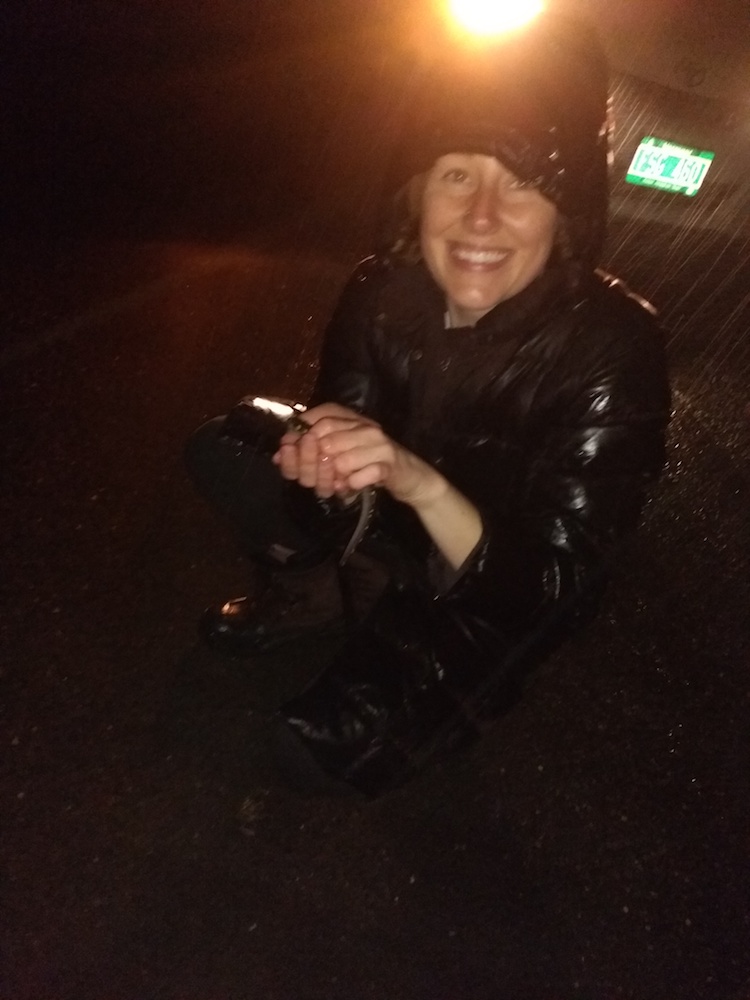 When admissions counselor Krystal Graybeal ’17 returned to Marlboro from a college fair last April, during the first warm, spring evening rain, she was too late to join biology professor Jaime Tanner and students who had been helping spotted salamanders cross South Road to their breeding sites. “I decided to do a late-night stroll with a friend, and ran into President KQ and his wife,” she wrote in the Branch Out “Marlboro Moments” group. “We all crept along South Road in a misty rain, ferrying the occasional critter to safety and out of the path of oncoming cars. It was my friend’s first time, though I’m pretty sure it will become a tradition!”
When admissions counselor Krystal Graybeal ’17 returned to Marlboro from a college fair last April, during the first warm, spring evening rain, she was too late to join biology professor Jaime Tanner and students who had been helping spotted salamanders cross South Road to their breeding sites. “I decided to do a late-night stroll with a friend, and ran into President KQ and his wife,” she wrote in the Branch Out “Marlboro Moments” group. “We all crept along South Road in a misty rain, ferrying the occasional critter to safety and out of the path of oncoming cars. It was my friend’s first time, though I’m pretty sure it will become a tradition!”
If you have not heard of Marlboro College Branch Out by now, you either have your head in the sand or you are rendered senseless by the phrases “online platform” or “virtual community.” Branch Out is the quintessential site for students, alumni, faculty, and friends to connect, engage, and support other members of the community. Since it was officially launched on May 1, with a festive presentation during the annual party for graduating students and alumni at the Marina Restaurant, there have been more than 400 new users and countless posts, groups started, and professional relationships kindled.
“If members use Branch Out to its potential, we get to find what others can offer to us in our personal or career pursuits; we could even get a lead on a sweet new job,” says Maia Segura ’91, director of alumni engagement, who helped Marlboro choose and implement the platform. “Ultimately, we get a better picture of what our community looks like, and we can build this rare community through stories about the truly life-changing nature of Marlboro College.”
Dubbed “Branch Out” by student focus group member Amelia Fanelli ’18, the new platform provides real-time opportunities for alumni to both benefit and give back through engagement opportunities, mentoring, events, and fundraising efforts. Similar platforms have been adopted at many colleges and universities worldwide over the last few years, and have been highly successful at increasing alumni engagement during particularly challenging times for institutions of higher education.
“I am particularly excited about the real potential for current students to be able to find mentors, internships, even jobs through this exclusive Marlboro online community,” says Kate Trzaskos, director of experiential learning and career development. “Branch Out provides a medium for us to connect with the rich, unique resources that we all bring to the table, to strengthen the community and help it to grow.” Learn more and log in at marlboro.edu/branch-out.
Who’s Who on Branch Out: Wouldn’t one of these make a nice connection?
- Corrin Meise-Munns ’09, land use planner at Pioneer Valley Planning Commission
- Alexander Hunter ’10, producer at CNN
- Nicole Hammond ’11, attorney advisor at the U.S. Department of Justice, Executive Office for Immigration Review
- Will Timpson ’09, front-end software engineer at Google
- Laura Frank ’92, producer and multiscreen technology specialist at Luminous FX n Dustin Pawlow ’15, field epidemiologist at Connecticut Department of Public Health
- Tom Good ’86, research biologist at NOAA Fisheries
New Course Supports Community Governance
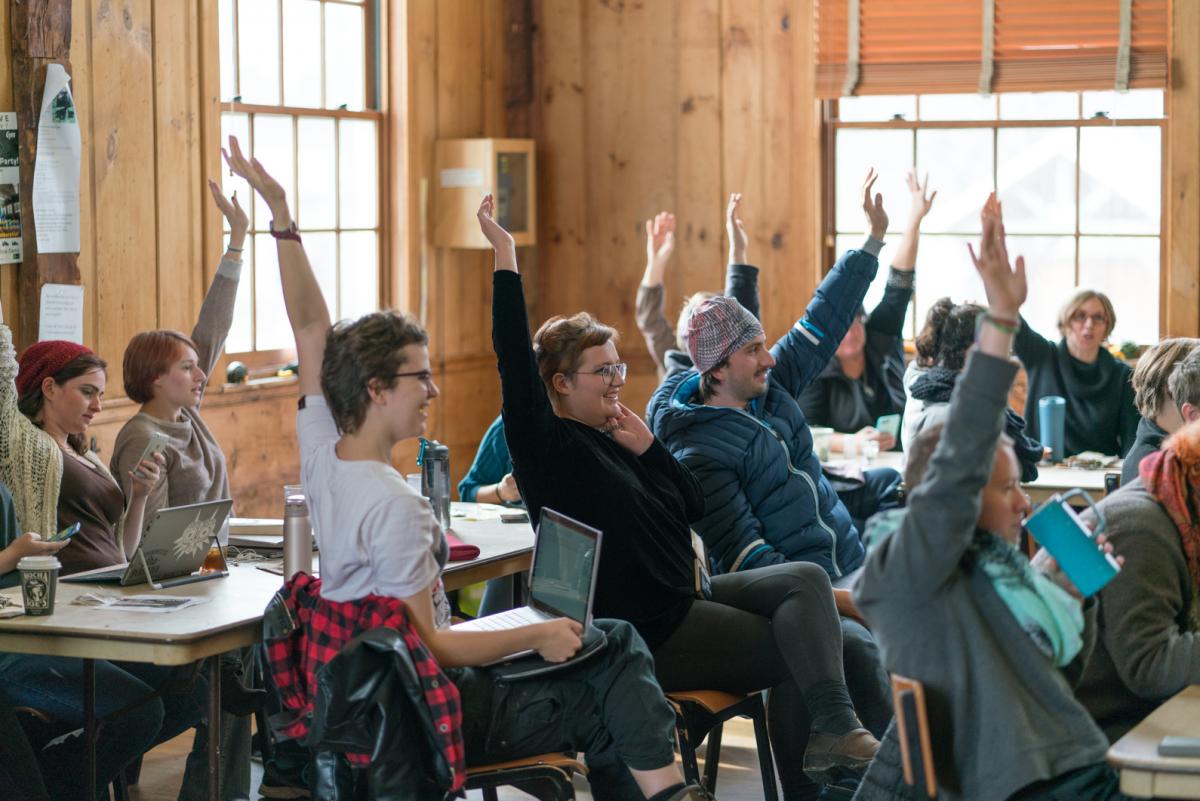 Although many students are drawn to Marlboro’s focus on community engagement and shared governance, some have found it difficult to integrate their community work with their course of study—until now. A new course called Community and Governance Colloquium, proposed by the Curriculum Committee last fall and piloted last spring semester, stands to make Marlboro’s shared governance model a more deeply integrated part of a Marlboro education.
Although many students are drawn to Marlboro’s focus on community engagement and shared governance, some have found it difficult to integrate their community work with their course of study—until now. A new course called Community and Governance Colloquium, proposed by the Curriculum Committee last fall and piloted last spring semester, stands to make Marlboro’s shared governance model a more deeply integrated part of a Marlboro education.
“There are so many shared skills gained by designing your own education and by having a voice in governing the campus,” says dance professor Kristin Horrigan, a member of the Curriculum Committee who is co-teaching the course this fall. “But students who come in excited about Town Meeting, committees, and community leadership roles were telling us that they had a hard time seeing and feeling the connection between community work and their academic work, especially in their first few years. This course is a way to build a clearer bridge.”
The new course grew out of the Curricular Innovations Action Planning Group, which Kristin was also a part of, who recommended that the faculty work to create a link between the governance model and the curriculum. It also builds on a group tutorial taught by math professor Matt Ollis and Helen Pinch ’18, who were part of the same action planning group during the fall of 2017 when Helen was serving as head selectperson.
“In the curricular innovation group, Matt and I had been talking about marrying academics with community governance, and trying to find a common thread that defines a Marlboro experience,” says Helen. “Instead of Plan being just an individualized, isolating experience, we wanted to include within the Marlboro experience this element that is much more expansive— of being an autonomous individual, but in a self-governing community.”
Matt and Helen’s tutorial supported students to go beyond their roles in community governance and do larger projects that were linked to their studies. For example, junior Eric Wefald created a handbook for the position of public advocate, a key community leadership position tied to Community Court. “At Marlboro, I believe we aim to put our democratic values into action,” says Eric.
The first Community and Governance Colloquium was taught by Matt and chemistry professor Todd Smith last spring, and included research and writing projects relating to Title IX, the Real Food Challenge, Town Meeting, and the role of the Town Meeting moderator. Part of the rationale for offering it as a course is that it is more visible to prospective students as well as more accessible to new students who are not yet doing tutorial work.
“I loved having conversations with the others in the class about what we like and what frustrates us regarding Town Meeting and the way Marlboro’s governance works,” says sophomore Phoenix Bieneman, who served as Town Meeting moderator last year. “I learned a lot, and I also found that we were able to talk about possible solutions.”
“I enjoyed the students’ dedication to the spirit of community engagement and self-governance, and it was exciting to see the commitment they had to their projects,” says Todd. “They were all quite committed, both to contributing their voices in campus governance, and to advocating for real change on campus.”
Students in the course apply academic skills to deepen their work on committees and in community roles. Each student crafts their own “work contract” with the faculty running the course so their assignments are shaped around the work they’re doing in the community. The course also includes some communal skill-building, in the form of workshops with guest speakers, shared readings, group projects, or discussions, to address gaps students may experience when diving into community work.
“I am looking forward to the chance to formalize the bridge between my teaching and the things I’ve learned from 12 years of participation in community governance at Marlboro,” says Kristin, who is co-teaching the course this fall with American studies professor Kate Ratcliff. “Working with Kate and a group of students whom I don’t usually see in my classes will be a treat, and it will offer us all a chance to deepen our understanding of our community while helping to strengthen it at the same time.”
Marlboro Partners with Nigerian University
Last spring, four years after they were abducted from a school in Nigeria, more than 100 girls released by Boko Haram were attending the American University of Nigeria (AUN). This is the same university, located in Adamawa State and known for its focus on sustainable development in Africa, that launched a new partnership with Marlboro College in March.
“Marlboro is committed to offering students international experiences that expand their horizons and launch them into a life of meaningful work,” says President Kevin, who serves on the board of directors at AUN and visited Nigeria in March to sign a memorandum of understanding with the university. “We already have partnerships in China, Mexico, Germany, Slovakia, and Czech Republic, as well as with domestic programs, and we are thrilled that our first collaboration in Africa is at AUN.”
President Kevin was introduced to AUN through his longtime colleague Bob Pastor, a fellow Peace Corps Volunteer and a writer and member of the National Security Council. Pastor helped establish AUN, working closely with its founder, Atiku Abubakar, former vice president of Nigeria.
“I worked with Atiku and Bob, in my role as president of the National Peace Corps Association, to launch the Harris Wofford Global Citizen Award,” says Kevin, who returned to Nigeria in May to speak at the installation of AUN’s new president, Dawn Dekle, and to meet with Abubakar. “This award recognizes individuals like Atiku, whose lives were influenced by their interactions with Peace Corps Volunteers, leading to a life of service to community and country.”
The specific goals of the cooperative relationship with AUN are to cultivate engaged learning between students and faculty from both institutions through student exchanges. The partnership will also provide for other joint academic endeavors, such as summer programs or faculty exchanges of mutual benefit.
“AUN is an ideal partner for Marlboro, with its focus on arts and sciences, but also technology and entrepreneurship, in the interest of future sustainable development,” says Maggie Patari, Marlboro’s director of global learning and international services. “We are fortunate to have this new partner providing the skills and leadership to help students address the social and economic challenges in the region and the world.”
See the New York Times article about the abducted girls, now young women, attending AUN, including powerful and moving portraits.
Also of Note
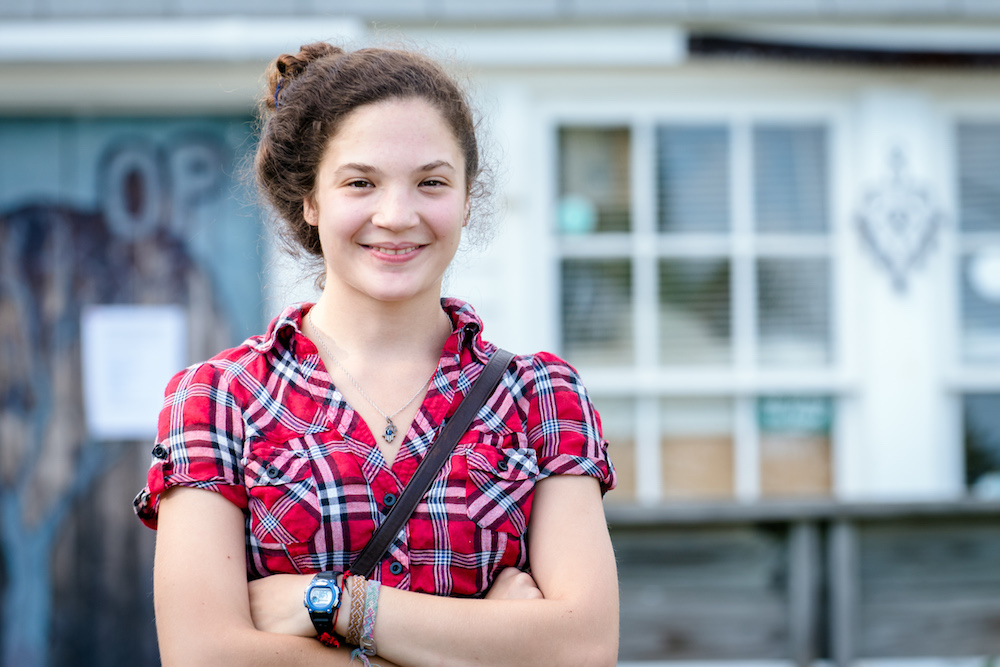 “In creating my Plan in religious studies and psychology, I felt it was integral that I grow my understanding of life and the world beyond the classroom and outside of the bubble and great privilege of being a US citizen,” says junior Janelle Kesner (pictured, right). She spent the 2017–18 academic year at the Rothberg International School at the Hebrew University of Jerusalem, taking classes in psychology, religion, language, and cross-cultural and political relations. “My studies abroad were broadened by observing, learning, and immersing myself in the many cultures of Israel. Conversing day and night with people helped me to grow a personal understanding, rather than relying on the consensus of the media.”
“In creating my Plan in religious studies and psychology, I felt it was integral that I grow my understanding of life and the world beyond the classroom and outside of the bubble and great privilege of being a US citizen,” says junior Janelle Kesner (pictured, right). She spent the 2017–18 academic year at the Rothberg International School at the Hebrew University of Jerusalem, taking classes in psychology, religion, language, and cross-cultural and political relations. “My studies abroad were broadened by observing, learning, and immersing myself in the many cultures of Israel. Conversing day and night with people helped me to grow a personal understanding, rather than relying on the consensus of the media.”
Despite sticky competition from rice noodles, rice-stuffed peppers, rice paper–wrapped spring rolls, and Nigerian jollof rice as mentioned in Chimamanda Ngozi Adichie’s Americanah, COO Becky Catarelli ’04 won the first annual Rice-Aron Library Cook-Off in May. Rice-inspired dishes prepared by staff were judged based on their use of rice, connection to any book theme, and other criteria such as appearance (from “beautiful food” to “are you sure that’s food?”). Becky gained high marks from the judges for a book-shaped cake decorated to look like Memnoch the Devil, by Anne Rice, and was awarded the coveted golden-rice-encrusted trophy.
In June, sophomore and dancer/choreographer Ricarrdo Valentine performed a new work-in-progress titled Hawa (The Ride) at Abrons Arts Center in New York City, as part of his duo with his partner, Orlando Zane Hunter Jr. “Brother(hood) Dance! is an interdisciplinary duo that seeks to inform its audiences on sociopolitical and environmental injustices from a global perspective, bringing clarity to the same-gender-loving African- American experience in the 21st century.” The culmination of their AIRspace residency, Hawa (The Ride) is a contemporary myth that “takes up black masculinity and the politics of adornment as source material for a creative fashioning of the future self.”
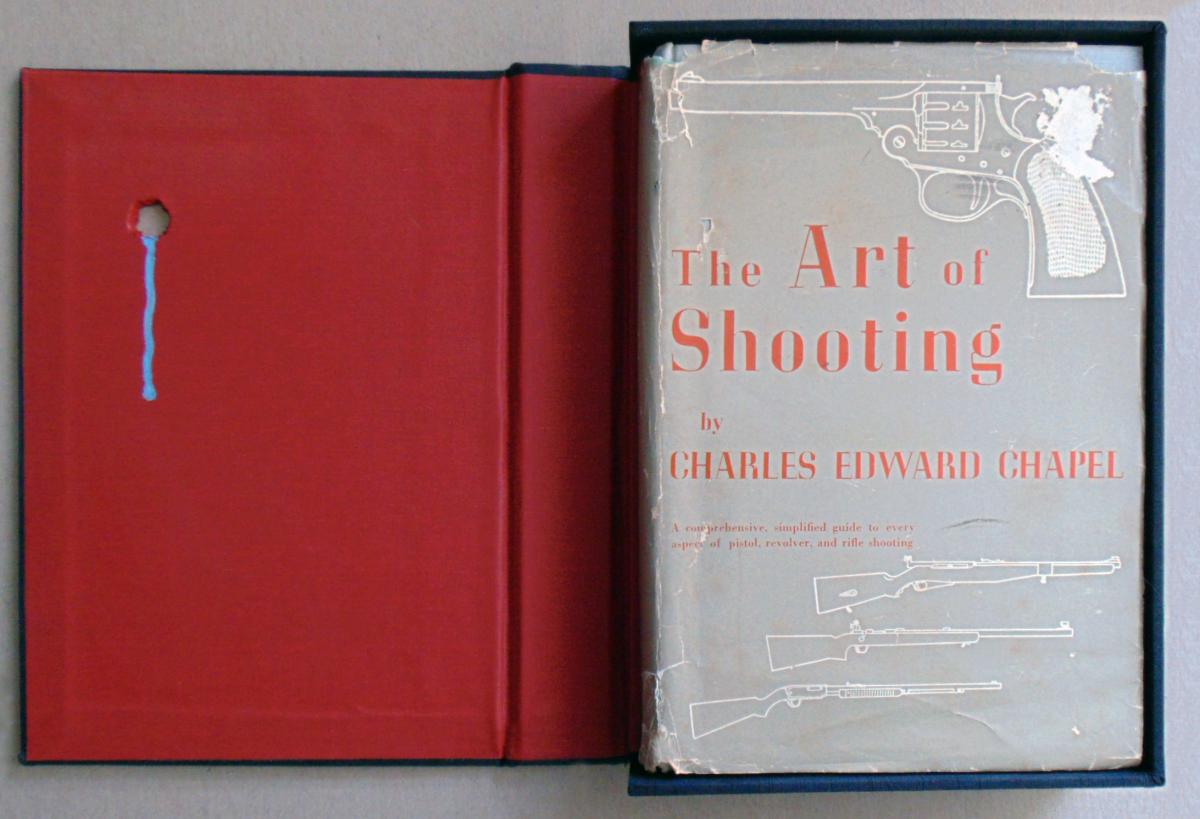 The Art of Shooting: Us & Them, a work by Richard Reitz Smith, communication and design manager, was featured in an exhibition titled “Opulence: Not Everything That Glitters Is Gold,” from July through September at New York’s Center for Book Arts. The work (pictured, right) evolves from a 1950 primer on good sportsmanship to what is now a loaded topic on so many levels. “I believe in beauty, its power, and its poetry,” says Richard. “I see them, even if they are ugly and painful, because I know that there is a story waiting to evolve and we must see and hear that tale.”
The Art of Shooting: Us & Them, a work by Richard Reitz Smith, communication and design manager, was featured in an exhibition titled “Opulence: Not Everything That Glitters Is Gold,” from July through September at New York’s Center for Book Arts. The work (pictured, right) evolves from a 1950 primer on good sportsmanship to what is now a loaded topic on so many levels. “I believe in beauty, its power, and its poetry,” says Richard. “I see them, even if they are ugly and painful, because I know that there is a story waiting to evolve and we must see and hear that tale.”
Through Marlboro’s partnership with the College for Social Innovation, junior Sage Kampitsis spent last spring semester as a Social Innovation Fellow in Boston, working with the Steppingstone Foundation, a nonprofit organization bridging the opportunity gap in education. She tutored middle school students, and conducted a research study on the effectiveness of the program’s admission process. “My ‘Semester in the City’ not only tied into my coursework at Marlboro, but shaped it as well,” says Sage. “It was through this program that I discovered my passion for empowerment education and decided to focus my Plan work around that passion.” See Sage share her own empowerment journey.
“I see Marlboro as a place of tremendous opportunity, both for our students who want to engage in the serious pursuit of a unique education, and for our supporters who can help to make that happen,” says Rennie Washburn, director of advancement, who joined the college in January. Rennie comes to Marlboro with 17 years of experience in many different facets of development work, most recently at Northfield Mount Hermon, where she was the director of alumni and parent giving programs. She recently guided Annual Fund giving to a record $2.2 million last fiscal year, which ended June 30.
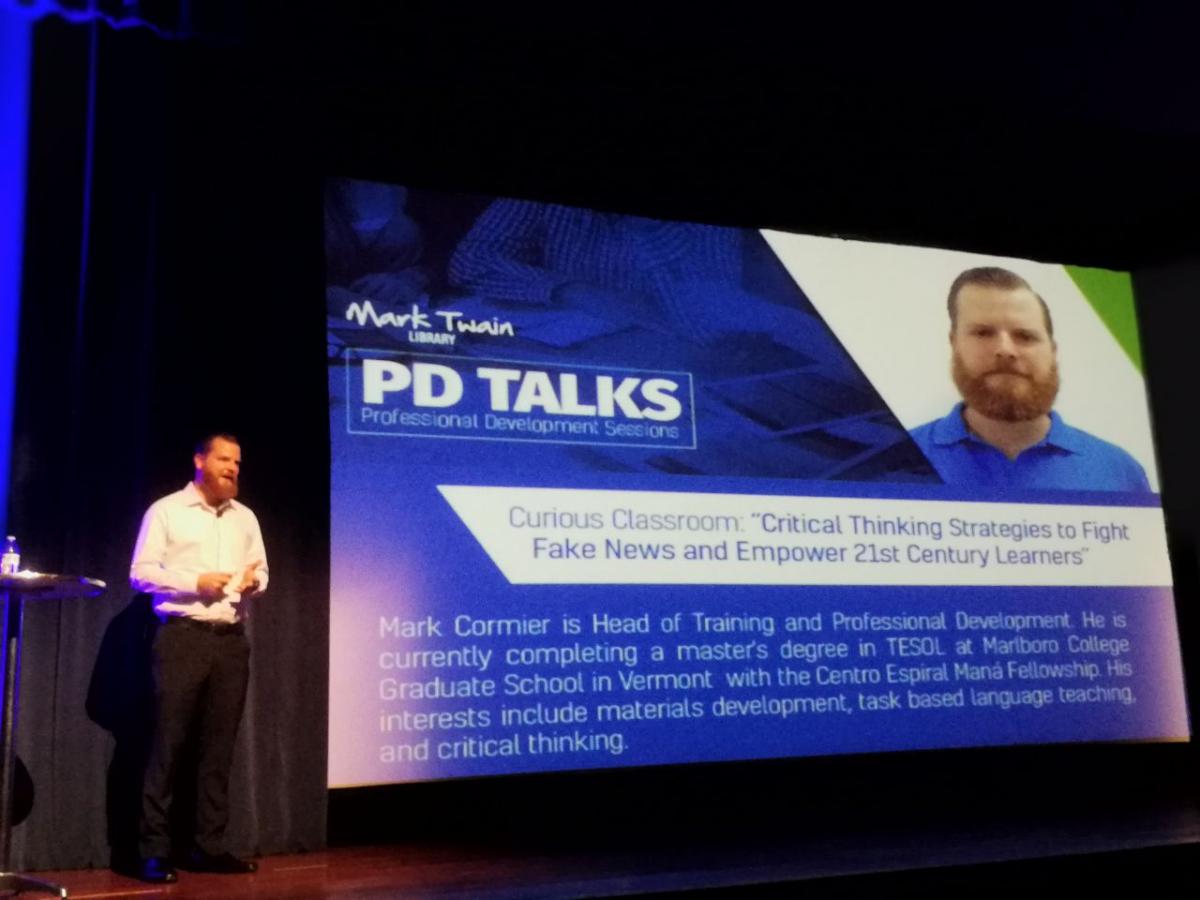 In April, MATESOL student Mark Cormier (pictured, right) gave a presentation for PD Talks, a public speaker series open to teachers and education students, hosted by the Mark Twain Library in San Jose, Costa Rica. “I talked about fake news and common cognitive biases and logical fallacies that contribute to its prevalence and impact, as well as the importance of harnessing our students’ natural curiosity as a tool for developing a more critical eye,” says Mark. He is head of training and professional development at the Centro Cultural Costarricense Norteamericano, a nonprofit English school and cultural center in San Jose promoting exchange between Costa Rica and the U.S.
In April, MATESOL student Mark Cormier (pictured, right) gave a presentation for PD Talks, a public speaker series open to teachers and education students, hosted by the Mark Twain Library in San Jose, Costa Rica. “I talked about fake news and common cognitive biases and logical fallacies that contribute to its prevalence and impact, as well as the importance of harnessing our students’ natural curiosity as a tool for developing a more critical eye,” says Mark. He is head of training and professional development at the Centro Cultural Costarricense Norteamericano, a nonprofit English school and cultural center in San Jose promoting exchange between Costa Rica and the U.S.
Junior Karla Julia Ramos and sophomore Annalise Guidry travelled with theater professor Jean O’Hara to Scotland in August for the Edinburgh Festival Fringe, the largest arts festival in the world. They were there to represent Marlboro College and to share their original performance, 3 Women, 3 Myths, a journey of exploration into how each of us is informed by our ancestors: their music, their languages, their spiritual practices, and their stories. With roots in Dominican Republic, Puerto Rico, and Ireland, respectively, each of the performers explored how their ancestors were brought across the ocean, and worked with the theme of water to tie in ancient myths from their families.
Marlboro was pleased to welcome Fumio Sugihara as the new director of admissions in August. Fumio comes to Marlboro from Bennington College, where he was director of admissions, but he has also worked in admissions at University of Puget Sound and Juniata College. He started his career in higher education at Bowdoin College, where he was director for multicultural recruitment and associate director of admissions. Fumio earned a bachelor’s degree at Bowdoin in women’s studies and environmental studies, and went on to earn a master’s degree in higher education from Harvard University’s Graduate School of Education.
Minds on Main Street 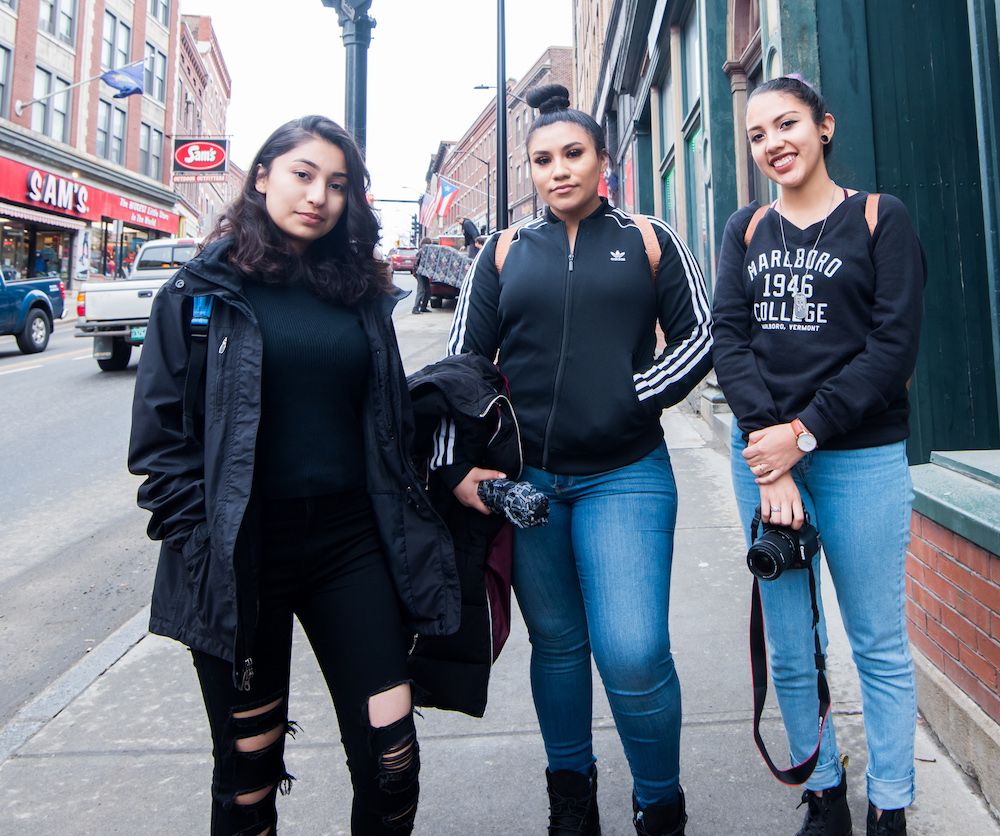 Three finalists in the Beautiful Minds Challenge explore Brattleboro, part of the symposium in April that welcomed more than 20 innovative high school students from all over the US as well as Kazakhstan, Jordan, and Ecuador. Learn about this year’s contest at minds.marlboro.edu. Photo by Kelly Fletcher
Three finalists in the Beautiful Minds Challenge explore Brattleboro, part of the symposium in April that welcomed more than 20 innovative high school students from all over the US as well as Kazakhstan, Jordan, and Ecuador. Learn about this year’s contest at minds.marlboro.edu. Photo by Kelly Fletcher
Spring Bounty Freshman Faza “Jimmy” Hikmatullah discovers a wealth of wood frog eggs in a vernal pool, part of biology professor Jaime Tanner’s Life in the Cold class. An international student from Indonesia, Jimmy embraced his first real winter with gusto. Photo by Cedar van Tassel ’21
Parlez Vous 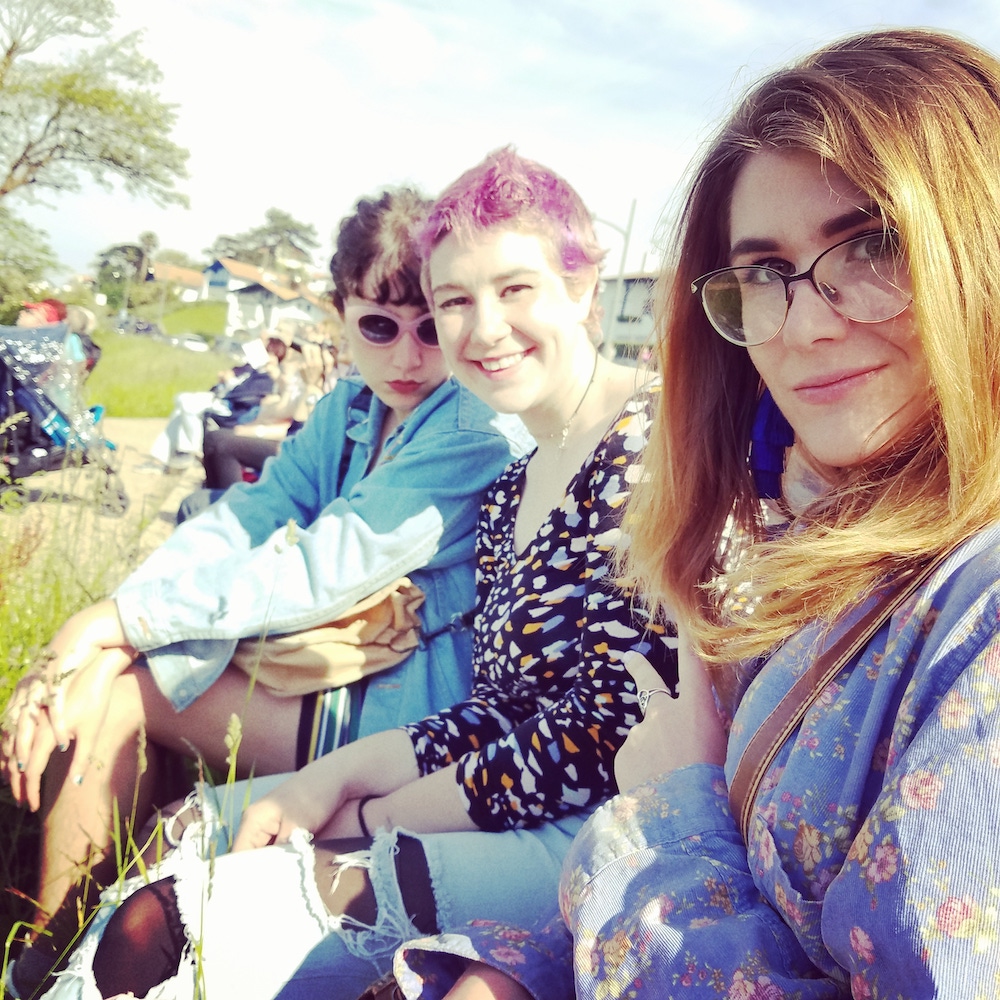 Lucy Johnston ’21, Margaret Brooks ’21, and Brooke Evans ’19 were among a group of six students who traveled to France in May with French language and literature fellow Frédérique Marty. They hiked in the Pyrenees, met with students in Bayonne, and learned about the history of chocolate in Basque country. Photo by Charlotte Nicholson ’18
Lucy Johnston ’21, Margaret Brooks ’21, and Brooke Evans ’19 were among a group of six students who traveled to France in May with French language and literature fellow Frédérique Marty. They hiked in the Pyrenees, met with students in Bayonne, and learned about the history of chocolate in Basque country. Photo by Charlotte Nicholson ’18
Making Change In February, Director of Experiential Learning and Career Development Kate Trzaskos (left) and others on campus welcomed representatives from Ashoka U, part of the process of becoming an Ashoka Changemaker Campus. Photo by Travis Hellstrom
Student Art
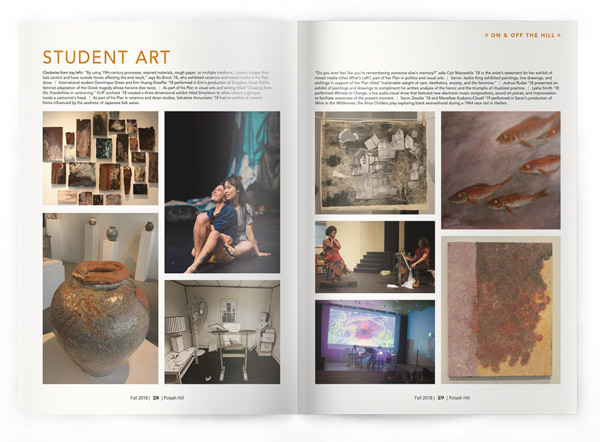
First page, clockwise from top left> “By using 19th-century processes, expired materials, rough paper, or multiple mediums, I create images that lack control and have outside forces affecting the end result,” says Bo Brout ’18, who exhibited ceramics and mixed media in his Plan show. | International student Dominique Drees and Erin Huang-Shaeffer ’18 performed in Erin’s production of Eurydice, Sarah Ruhl’s feminist adaptation of the Greek tragedy whose heroine dies twice. | As part of his Plan in visual arts and writing titled “Drawing from life: Possibilities in cartooning,” Griff Jurchack ’18 created a three-dimensional exhibit titled Simpleton to allow visitors a glimpse inside a cartoonist’s head. | As part of his Plan in ceramics and Asian studies, Salvatore Annunziato ’18 had an exhibit of ceramic forms influenced by the aesthetic of Japanese folk wares.
Second page, clockwise from top left> “Do you ever feel like you’re remembering someone else’s memory?” asks Cait Mazzarella ’18 in the artist’s statement for her exhibit of mixed media titled What’s Left?, part of her Plan in politics and visual arts. | Senior Jackie King exhibited paintings, line drawings, and etchings in support of her Plan titled “Inalienable weight of care: Aesthetics, anxiety, and the feminine.” | Joshua Rudas ’18 presented an exhibit of paintings and drawings to compliment his written analysis of the heroic and the triumphs of ritualized practice. | Lysha Smith ’18 performed Witness to Change, a live audio-visual show that featured new electronic music compositions, sound art pieces, and improvisation to facilitate awareness of the present moment. | Saron Zewdie ’18 and Menefese Kudumu-Clavell ’19 performed in Saron’s production of Wine in the Wilderness, the Alice Childers play exploring black womanhood during a 1964 race riot in Harlem.
Events
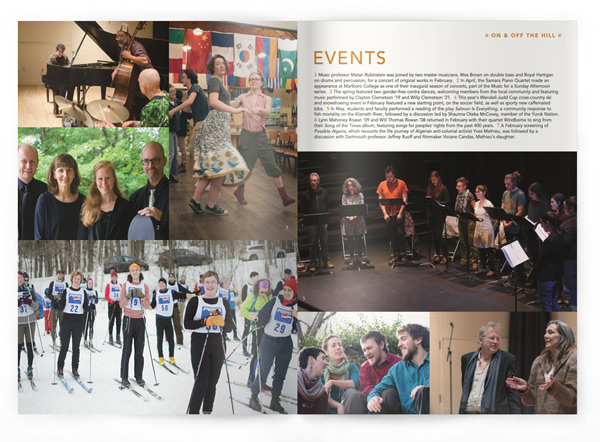
1 Music professor Matan Rubinstein was joined by two master musicians, Wes Brown on double bass and Royal Hartigan on drums and percussion, for a concert of original works in February. 2 In April, the Samara Piano Quartet made an appearance at Marlboro College as one of their inaugural season of concerts, part of the Music for a Sunday Afternoon series. 3 The spring featured two gender-free contra dances, welcoming members from the local community and featuring music performed by Clayton Clemetson ’19 and Willy Clemetson ’21. 4 This year’s Wendell-Judd Cup cross-country ski and snowshoeing event in February featured a new starting point, on the soccer field, as well as sporty new caffeinated bibs. 5 In May, students and faculty performed a reading of the play Salmon Is Everything, a community response to fish mortality on the Klamath River, followed by a discussion led by Shaunna Oteka McCovey, member of the Yurok Nation. 6 Lynn Mahoney Rowan ’09 and Will Thomas Rowan ’08 returned in February with their quartet Windborne to sing from their Song of the Times album, featuring songs for peoples’ rights from the past 400 years. 7 A February screening of Possible Algeria, which recounts the life journey of Algerian anti-colonial activist Yves Mathieu, was followed by a discussion with Dartmouth professor Jeffrey Ruoff and filmmaker Viviane Candas, Mathieu’s daughter.
Focus on Faculty
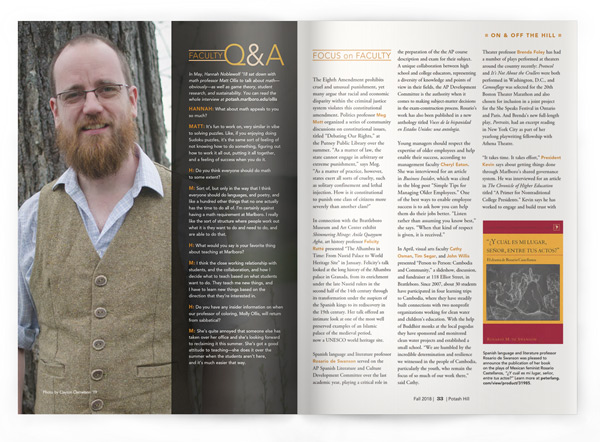
Faculty Q&A
In May, Hannah Noblewolf ’18 sat down with math professor Matt Ollis to talk about math— obviously—as well as game theory, student research, and sustainability. You can read the whole interview.
HANNAH: What about math appeals to you so much?
MATT: It’s fun to work on, very similar in vibe to solving puzzles. Like, if you enjoying doing Sudoku puzzles, it’s the same sort of feeling of not knowing how to do something, figuring out how to work it all out, putting it all together, and a feeling of success when you do it.
H: Do you think everyone should do math to some extent?
M: Sort of, but only in the way that I think everyone should do languages, and poetry, and like a hundred other things that no one actually has the time to do all of. I’m certainly against having a math requirement at Marlboro. I really like the sort of structure where people work out what it is they want to do and need to do, and are able to do that.
H: What would you say is your favorite thing about teaching at Marlboro?
M: I think the close working relationship with students, and the collaboration, and how I decide what to teach based on what students want to do. They teach me new things, and I have to learn new things based on the direction that they’re interested in.
H: Do you have any insider information on when our professor of coloring, Molly Ollis, will return from sabbatical?
M: She’s quite annoyed that someone else has taken over her office and she’s looking forward to reclaiming it this summer. She’s got a good attitude to teaching—she does it over the summer when the students aren’t here, and it’s much easier that way.
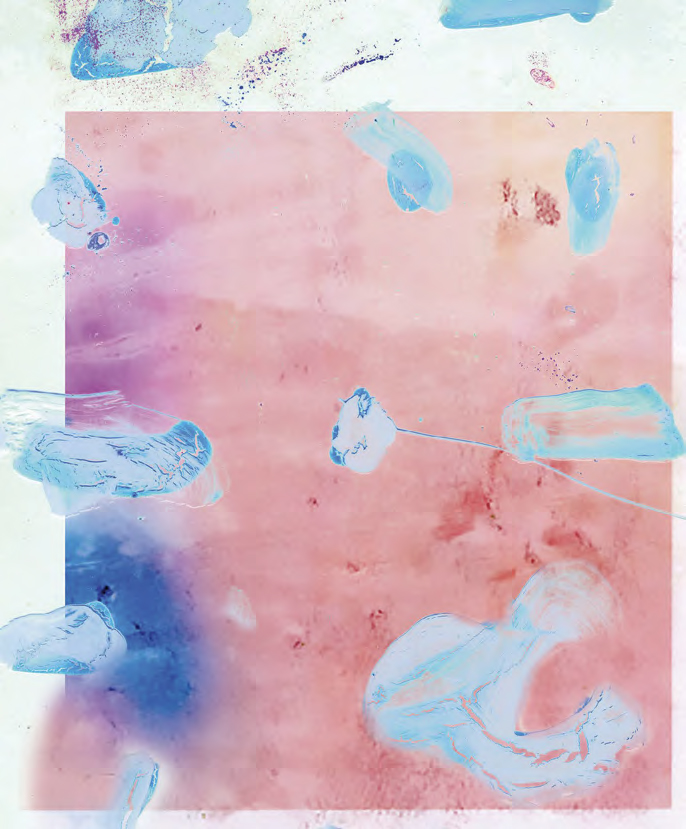 The Eighth Amendment prohibits cruel and unusual punishment, yet many argue that racial and economic disparity within the criminal justice system violates this constitutional amendment. Politics professor Meg Mott organized a series of community discussions on constitutional issues, titled “Debating Our Rights,” at the Putney Public Library over the summer. “As a matter of law, the state cannot engage in arbitrary or extreme punishment,” says Meg. “As a matter of practice, however, states exert all sorts of cruelty, such as solitary confinement and lethal injection. How is it constitutional to punish one class of citizens more severely than another class?”
The Eighth Amendment prohibits cruel and unusual punishment, yet many argue that racial and economic disparity within the criminal justice system violates this constitutional amendment. Politics professor Meg Mott organized a series of community discussions on constitutional issues, titled “Debating Our Rights,” at the Putney Public Library over the summer. “As a matter of law, the state cannot engage in arbitrary or extreme punishment,” says Meg. “As a matter of practice, however, states exert all sorts of cruelty, such as solitary confinement and lethal injection. How is it constitutional to punish one class of citizens more severely than another class?”
In connection with the Brattleboro Museum and Art Center exhibit Shimmering Mirage: Anila Quayyum Agha, art history professor Felicity Ratté presented “The Alhambra in Time: From Nasrid Palace to World Heritage Site” in January. Felicity’s talk looked at the long history of the Alhambra palace in Granada, from its enrichment under the late Nasrid rulers in the second half of the 14th century through its transformation under the auspices of the Spanish kings to its rediscovery in the 19th century. Her talk offered an intimate look at one of the most well preserved examples of an Islamic palace of the medieval period, now a UNESCO world heritage site.
Spanish language and literature professor Rosario de Swanson served on the AP Spanish Literature and Culture Development Committee over the last academic year, playing a critical role in the preparation of the the AP course description and exam for their subject. A unique collaboration between high school and college educators, representing a diversity of knowledge and points of view in their fields, the AP Development Committee is the authority when it comes to making subject-matter decisions in the exam-construction process. Rosario’s work has also been published in a new anthology titled Voces de la hispanidad en Estados Unidos: una antologia.
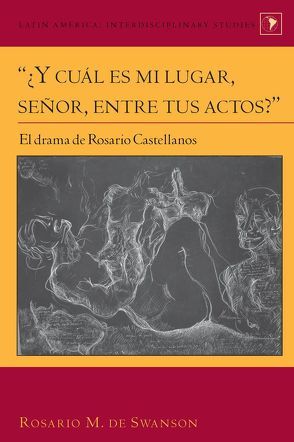 Young managers should respect the expertise of older employees and help enable their success, according to management faculty Cheryl Eaton. She was interviewed for an article in Business Insider, which was cited in the blog post “Simple Tips for Managing Older Employees.” One of the best ways to enable employee success is to ask how you can help them do their jobs better. “Listen rather than assuming you know best,” she says. “When that kind of respect is given, it is received.”
Young managers should respect the expertise of older employees and help enable their success, according to management faculty Cheryl Eaton. She was interviewed for an article in Business Insider, which was cited in the blog post “Simple Tips for Managing Older Employees.” One of the best ways to enable employee success is to ask how you can help them do their jobs better. “Listen rather than assuming you know best,” she says. “When that kind of respect is given, it is received.”
In April, visual arts faculty Cathy Osman, Tim Segar, and John Willis presented “Person to Person: Cambodia and Community,” a slideshow, discussion, and fundraiser at 118 Elliot Street, in Brattleboro. Since 2007, about 30 students have participated in four learning trips to Cambodia, where they have steadily built connections with two nonprofit organizations working for clean water and children’s education. With the help of Buddhist monks at the local pagodas they have sponsored and monitored clean water projects and established a small school. “We are humbled by the incredible determination and resilience we witnessed in the people of Cambodia, particularly the youth, who remain the focus of so much of our work there,” said Cathy.
Theater professor Brenda Foley has had a number of plays performed at theaters around the country recently: Protocol and It’s Not About the Crullers were both performed in Washington, D.C., and Camouflage was selected for the 20th Boston Theater Marathon and also chosen for inclusion in a joint project for the She Speaks Festival in Ontario and Paris. And Brenda’s new full-length play, Portraits, had an excerpt reading in New York City as part of her yearlong playwriting fellowship with Athena Theatre.
“It takes time. It takes effort,” President Kevin says about getting things done through Marlboro’s shared governance system. He was interviewed for an article in The Chronicle of Higher Education titled “A Primer for Nontraditional College Presidents.” Kevin says he has worked to engage and build trust with the faculty, and he has achieved a measure of peace with the governance system in which everyone on campus has a say in how the college operates. “You don’t always get the ideal outcome. I do think the outcome is better for having gone through the process, and it is much more likely to endure.”
 The newest book in management faculty Travis Hellstrom’s 52 Questions series was published last November, following on his 52 Questions for a Happy Friendship and 52 Questions for a Better Relationship. It’s called 52 Questions for Families, and includes a year’s worth of fun, thought-provoking conversation-starters to help readers learn more about their loved ones. “These books are designed to help anyone have a deeper conversation with people they love,” says Travis. “At Marlboro we love questions, so I hope these books help people communicate and enjoy making their interactions even more fun.”
The newest book in management faculty Travis Hellstrom’s 52 Questions series was published last November, following on his 52 Questions for a Happy Friendship and 52 Questions for a Better Relationship. It’s called 52 Questions for Families, and includes a year’s worth of fun, thought-provoking conversation-starters to help readers learn more about their loved ones. “These books are designed to help anyone have a deeper conversation with people they love,” says Travis. “At Marlboro we love questions, so I hope these books help people communicate and enjoy making their interactions even more fun.”
In April and May, religion professor Amer Latif conducted a series of lectures on Rumi for the Osher Lifelong Learning Institute of the University of Vermont. In a series titled Reading the Qur’an with Rumi, Amer discussed how the 13th-century Muslim contemplative, now one of the best-selling poets in America, considered Qur’an a map of the self. “Rumi interprets Qur’anic stories through telling tales of his own,” says Amer. “Using insights into the nature and function of stories from the cognitive and neurosciences, we examined how Rumi’s stories orient readers to take actions that can lead to a life of happiness and flourishing.”
In March, professor of painting Amy Beecher and visiting arts fellow David Eichelberger presented an exhibition of their work in Drury Gallery, as well as an artist’s talk. An interdisciplinary artist, Amy exhibited abstract digital paintings and photographs generated on a large-format ink-jet printer. Ceramist David exhibited recent clay vessels and wall pieces. As their joint exhibit and talk illustrated, both artists share an interest in medium specificity and attention to evolving technologies of expression.
“Teaching students about concepts is usually not adequate,” says TESOL faculty member Josh Kurzweil in a recent blog post about teaching adults English as a second language. “For many students to become more effective learners, they need to see, do, and reflect on the techniques in class. In this way, students can build habits of learning that make sense to them.” Josh has recently done teacher training with professors at the California College of Art as well as labor union instructors with Laborer’s International Union of North America and the Service Employees International Union. Read his blog post on Supporting Science of Learning in the Language Classroom.
“I was one of three men invited to a conference on the theme of The Women in the Buddha’s Life at Harvard in April,” says philosophy professor William Edelglass. In March, William was in India to give several talks and workshops, including a talk titled “That is Why the Buddha Laughs: Apophasis as Practice” at the K.J. Somaiya Centre for Buddhist Studies in Mumbai. While in India he was also able to attend a meeting of the Mind and Life Institute, a weeklong conversation between scientists and the Dalai Lama called Religion and Ritual: The Poetics and Performance of the Ineffable. William recently published a chapter titled “Buddhism, Happiness, and the Science of Meditation” in Meditation, Buddhism, and Science in Context: Humanistic Scholarship and the Scientific Study of Meditation, edited by David L. McMahan and Erik Braun (Oxford University Press). Learn more about the Mind and Life dialogs.
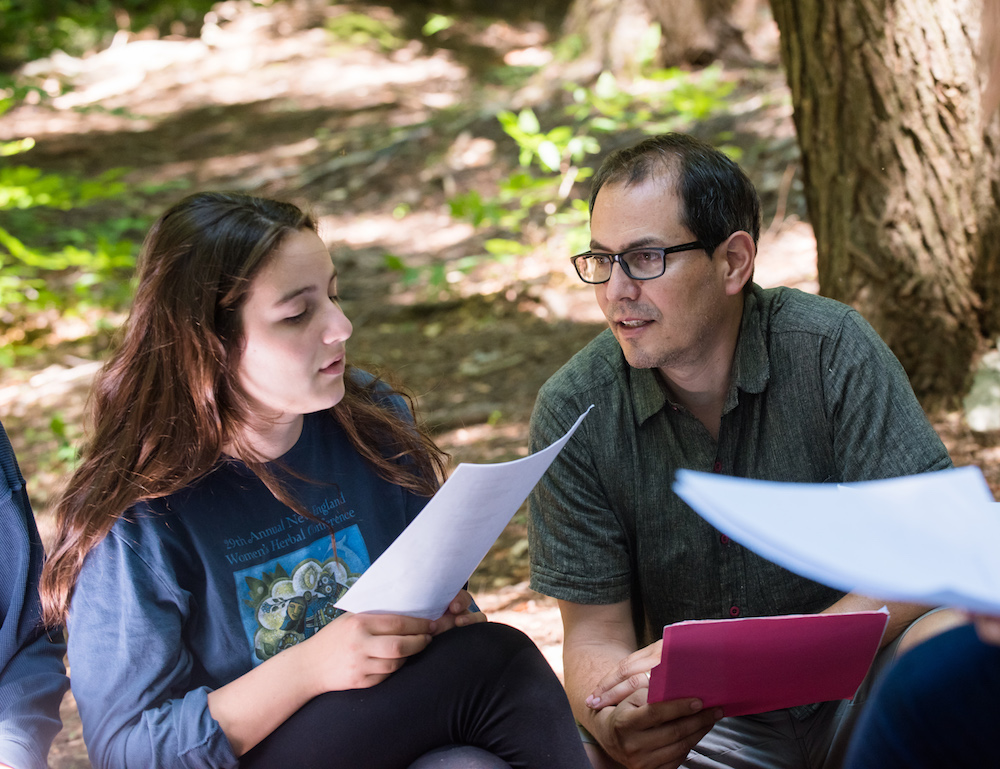 In August, theater professor Jean O’Hara presented on two panels at the Association for Theater in Higher Education conference in Boston. The first was a directing panel titled “Going from Protester to protestee: Who has the right to tell a story?” where Jean shared her experience with directing Didi and Gogo, an original adaptation of Waiting for Godot with two women of color in the lead roles. The second was an LGBT panel titled “Queering self/place/the everyday: Paving a path beyond heteronormativity?” where she shared the Drag: History, Politics, and Performance course that she co-taught with anthropology professor Nelli Sargsyan.
In August, theater professor Jean O’Hara presented on two panels at the Association for Theater in Higher Education conference in Boston. The first was a directing panel titled “Going from Protester to protestee: Who has the right to tell a story?” where Jean shared her experience with directing Didi and Gogo, an original adaptation of Waiting for Godot with two women of color in the lead roles. The second was an LGBT panel titled “Queering self/place/the everyday: Paving a path beyond heteronormativity?” where she shared the Drag: History, Politics, and Performance course that she co-taught with anthropology professor Nelli Sargsyan.
“The Exposures curriculum is now much more about understanding different cultural perspectives, and that ‘normal’ is a cultural construct,” said photography professor John Willis, who once again spent a month this summer with the cross-cultural youth arts program. “We use photography, writing, multimedia, and cross-cultural experience to understand and appreciate diversity.” Now in it’s 16th year, the Exposures program was initially launched by a group of John’s Plan students, and has employed several students and graduates over the years. This will be the first fall that one of the Lakota participants in the program will be enrolled as a new student at Marlboro College.
“The MAT in Teaching with Technology has had a remarkable, 20-year run of exceptional learning for ‘teachers who like to geek and geeks who like to teach,’” said Kate Jellema, dean of graduate and professional studies, reflecting on the discontinuation of that graduate specialization. “As degree chair for half of that run, Caleb Clark brought his love of technological innovation, together with a real gift for teaching and advising, and helped facilitate impressive student outcomes.” See one example of these outcomes on page 44, and many more at marlboro.edu/matgraduates. Marlboro will be honoring Caleb, and celebrating the MAT alumni community, at the Graduate and Professional Studies 20th Anniversary weekend.
2018 Commencement
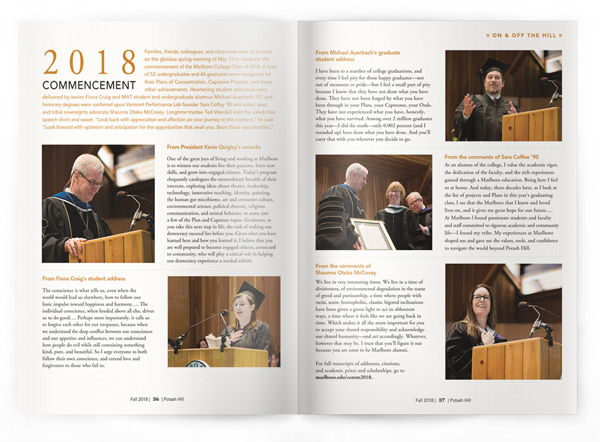
Families, friends, colleagues, and classmates were all present on the glorious spring morning of May 13 to celebrate the commencement of the Marlboro College Class of 2018. A total of 52 undergraduates and 44 graduates were recognized for their Plans of Concentration, Capstone Projects, and many other achievements. Heartening student addresses were delivered by senior Fiona Craig and MAT student and undergraduate alumnus Michael Auerbach ’97, and honorary degrees were conferred upon Vermont Performance Lab founder Sara Coffey ’90 and writer, poet, and tribal sovereignty advocate Shaunna Oteka McCovey. Longtime trustee Ted Wendell kept the valediction speech short and sweet. “Look back with appreciation and affection on your journey to this moment,” he said. “Look forward with optimism and anticipation for the opportunities that await you. Seize those opportunities.”
From President Kevin Quigley’s remarks 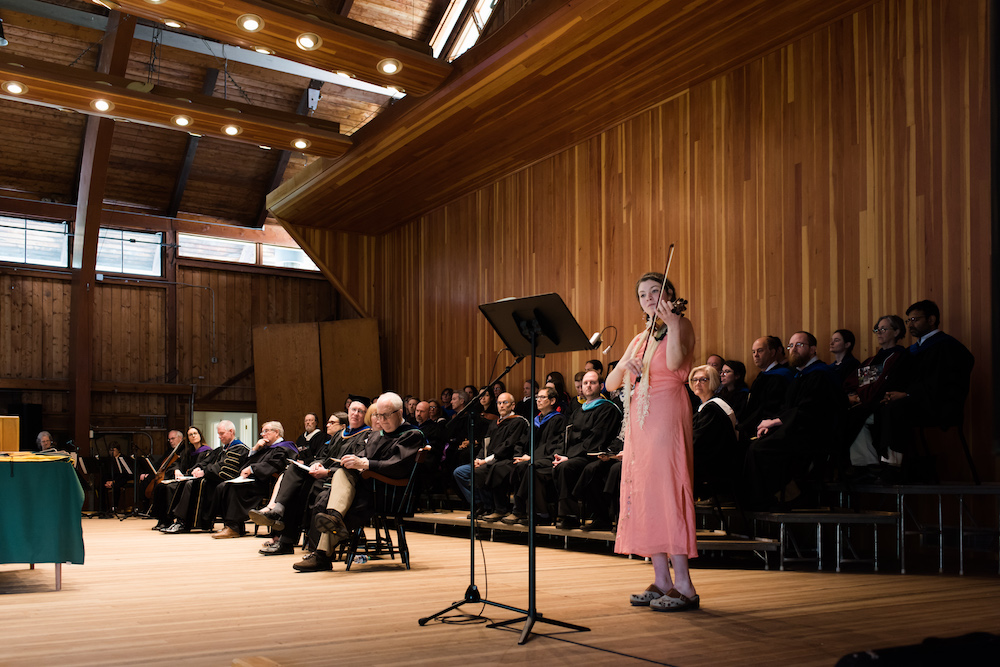 One of the great joys of living and working at Marlboro is to witness our students live their passions, learn new skills, and grow into engaged citizens. Today’s program eloquently catalogues the extraordinary breadth of their interests, exploring ideas about theater, leadership, technology, innovative teaching, identity, painting, the human gut micobiome, art and consumer culture, environmental science, political rhetoric, religious communication, and animal behavior, to name just a few of the Plan and Capstone topics. Graduates, as you take this next step in life, the task of making our democracy succeed lies before you. Given what you have learned here and how you learned it, I believe that you are well prepared to become engaged citizens, connected to community, who will play a critical role in helping our democracy experience a needed rebirth.
One of the great joys of living and working at Marlboro is to witness our students live their passions, learn new skills, and grow into engaged citizens. Today’s program eloquently catalogues the extraordinary breadth of their interests, exploring ideas about theater, leadership, technology, innovative teaching, identity, painting, the human gut micobiome, art and consumer culture, environmental science, political rhetoric, religious communication, and animal behavior, to name just a few of the Plan and Capstone topics. Graduates, as you take this next step in life, the task of making our democracy succeed lies before you. Given what you have learned here and how you learned it, I believe that you are well prepared to become engaged citizens, connected to community, who will play a critical role in helping our democracy experience a needed rebirth.
From Fiona Craig’s student address
The conscience is what tells us, even when the world would lead us elsewhere, how to follow our basic impulse toward happiness and harmony…. The individual conscience, when heeded above all else, drives us to do good…. Perhaps most importantly, it calls us to forgive each other for our trespasses, because when we understand the deep conflict between our consciences and our appetites and influences, we can understand how people do evil while still containing something kind, pure, and beautiful. So I urge everyone to both follow their own conscience, and extend love and forgiveness to those who fail to.
From Michael Auerbach’s graduate student address 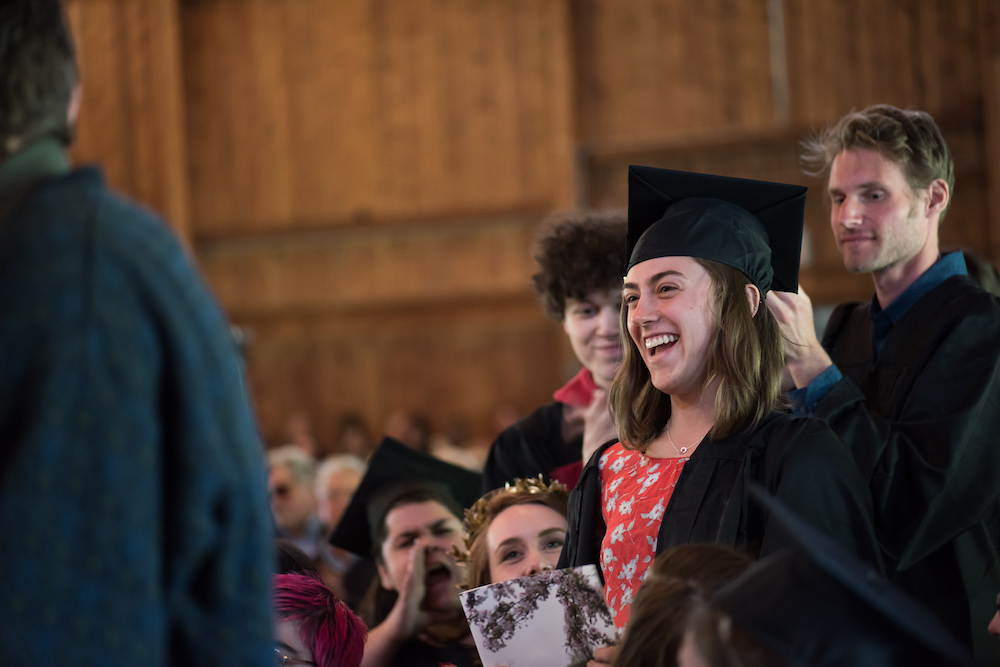 I have been to a number of college graduations, and every time I feel pity for those happy graduates—not out of meanness or pride—but I feel a small part of pity because I know that they have not done what you have done. They have not been forged by what you have been through in your Plans, your Capstones, your Orals. They have not experienced what you have, honestly, what you have survived. Among over 2 million graduates this year—I did the math—only 0.002 percent (and I rounded up) have done what you have done. And you’ll carry that with you wherever you decide to go.
I have been to a number of college graduations, and every time I feel pity for those happy graduates—not out of meanness or pride—but I feel a small part of pity because I know that they have not done what you have done. They have not been forged by what you have been through in your Plans, your Capstones, your Orals. They have not experienced what you have, honestly, what you have survived. Among over 2 million graduates this year—I did the math—only 0.002 percent (and I rounded up) have done what you have done. And you’ll carry that with you wherever you decide to go.
From the comments of Sara Coffee ‘90
As an alumna of the college, I value the academic rigor, the dedication of the faculty, and the rich experiences gained through a Marlboro education. Being here I feel so at home. And today, three decades later, as I look at the list of projects and Plans in this year’s graduating class, I see that the Marlboro that I knew and loved lives on, and it gives me great hope for our future…. At Marlboro l found passionate students and faculty and staff committed to rigorous academic and community life—I found my tribe. My experiences at Marlboro shaped me and gave me the values, tools, and confidence to navigate the world beyond Potash Hill.
From the comments of Shaunna Oteka McCovey 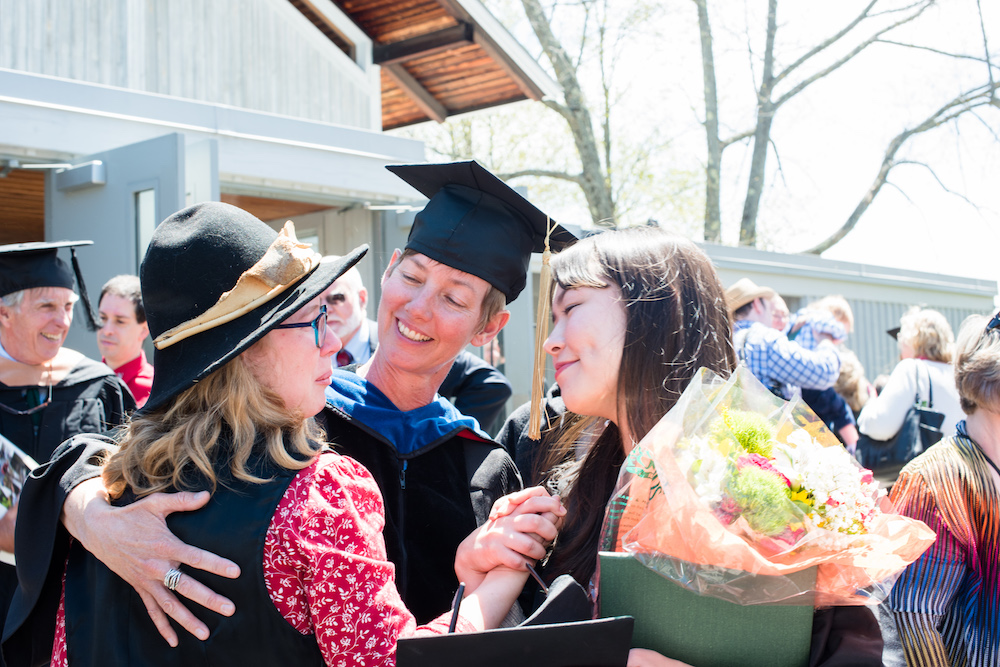 We live in very interesting times. We live in a time of divisiveness, of environmental degradation in the name of greed and partisanship, a time where people with racist, sexist, homophobic, classist, bigoted inclinations have been given a green light to act in abhorrent ways, a time where it feels like we are going back in time. Which makes it all the more important for you to accept your shared responsibility and acknowledge our shared humanity—and act accordingly. Whatever, however that may be. I trust that you’ll figure it out because you are soon to be Marlboro alumni.
We live in very interesting times. We live in a time of divisiveness, of environmental degradation in the name of greed and partisanship, a time where people with racist, sexist, homophobic, classist, bigoted inclinations have been given a green light to act in abhorrent ways, a time where it feels like we are going back in time. Which makes it all the more important for you to accept your shared responsibility and acknowledge our shared humanity—and act accordingly. Whatever, however that may be. I trust that you’ll figure it out because you are soon to be Marlboro alumni.
For full transcripts of addresses, citations, and academic prizes and scholarships, as well as photos, go to marlboro.edu/comm2018.
Alumni News
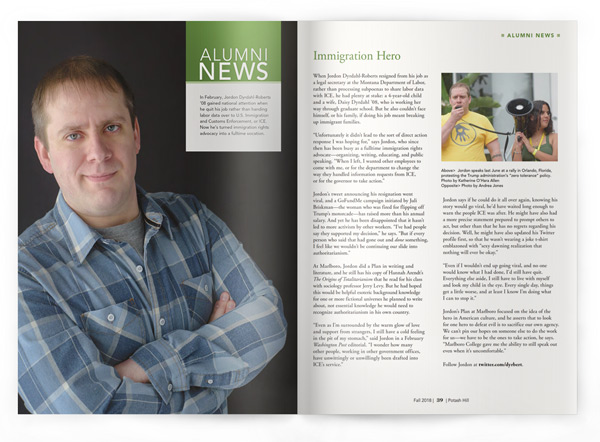
Immigration Hero
In February, Jordon Dyrdahl-Roberts ’08 gained national attention when he quit his job rather than handing labor data over to U.S. Immigration and Customs Enforcement, or ICE. Now he’s turned immigration rights advocacy into a fulltime vocation.
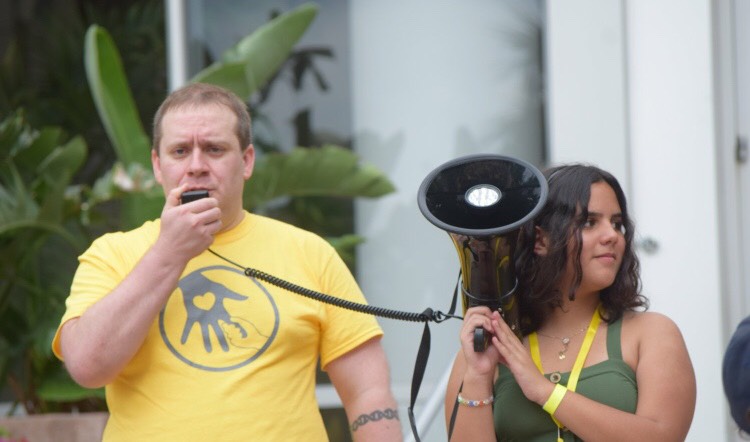 When Jordon Dyrdahl-Roberts resigned from his job as a legal secretary at the Montana Department of Labor, rather than processing subpoenas to share labor data with ICE, he had plenty at stake: a 4-year-old child and a wife, Daisy Dyrdahl ’08, who is working her way through graduate school. But he also couldn’t face himself, or his family, if doing his job meant breaking up immigrant families.
When Jordon Dyrdahl-Roberts resigned from his job as a legal secretary at the Montana Department of Labor, rather than processing subpoenas to share labor data with ICE, he had plenty at stake: a 4-year-old child and a wife, Daisy Dyrdahl ’08, who is working her way through graduate school. But he also couldn’t face himself, or his family, if doing his job meant breaking up immigrant families.
“Unfortunately it didn’t lead to the sort of direct action response I was hoping for,” says Jordon, who since then has been busy as a fulltime immigration rights advocate—organizing, writing, educating, and public speaking. “When I left, I wanted other employees to come with me, or for the department to change the way they handled information requests from ICE, or for the governor to take action.”
Jordon’s tweet announcing his resignation went viral, and a GoFundMe campaign initiated by Juli Briskman—the woman who was fired for flipping off Trump’s motorcade—has raised more than his annual salary. And yet he has been disappointed that it hasn’t led to more activism by other workers. “I’ve had people say they supported my decision,” he says. “But if every person who said that had gone out and done something, I feel like we wouldn’t be continuing our slide into authoritarianism.”
At Marlboro, Jordon did a Plan in writing and literature, and he still has his copy of Hannah Arendt’s The Origins of Totalitarianism that he read for his class with sociology professor Jerry Levy. But he had hoped this would be helpful esoteric background knowledge for one or more fictional universes he planned to write about, not essential knowledge he would need to recognize authoritarianism in his own country.
“Even as I’m surrounded by the warm glow of love and support from strangers, I still have a cold feeling in the pit of my stomach,” said Jordon in a February Washington Post editorial. “I wonder how many other people, working in other government offices, have unwittingly or unwillingly been drafted into ICE’s service.”
Jordon says if he could do it all over again, knowing his story would go viral, he’d have waited long enough to warn the people ICE was after. He might have also had a more precise statement prepared to prompt others to act, but other than that he has no regrets regarding his decision. Well, he might have also updated his Twitter profile first, so that he wasn’t wearing a joke t-shirt emblazoned with “sexy dawning realization that nothing will ever be okay.”
“Even if I wouldn’t end up going viral, and no one would know what I had done, I’d still have quit. Everything else aside, I still have to live with myself and look my child in the eye. Every single day, things get a little worse, and at least I know I’m doing what I can to stop it.”
Jordon’s Plan at Marlboro focused on the idea of the hero in American culture, and he asserts that to look for one hero to defeat evil is to sacrifice our own agency. We can’t pin our hopes on someone else to do the work for us—we have to be the ones to take action, he says. “Marlboro College gave me the ability to still speak out even when it’s uncomfortable.”
Follow Jordon at twitter.com/dyrbert.
Class Notes
Class notes are listed by year and include both graduates and nongraduates; the latter are listed under the class with which they are associated.
’63
“Going to finish my work as a ‘lec 3’ at University of Maine at Rockland this fall,” says JONATHON POTTER. “I’ll miss being with the students.”
’65
JAVED CHAUDHRI shared an audio interview with Munson Hicks, who once taught theater at Marlboro. His father, Halsey Hicks, was professor of forestry and his aunt taught English literature, French, and Spanish. “A slice of Marlboro history,” writes Javed. Hear the interview.
’68
“People need a place to live and find it affordable and convenient to get to work,” said BOB JOHNSON in a Brattleboro Reformer article about his housing development, known as Delta Campus, for his employees at Omega Optical. The project, which is planned to include energy-efficient units powered by solar energy and heated by heat pump systems, was being reviewed by the Development Review Board. Read more.
’72 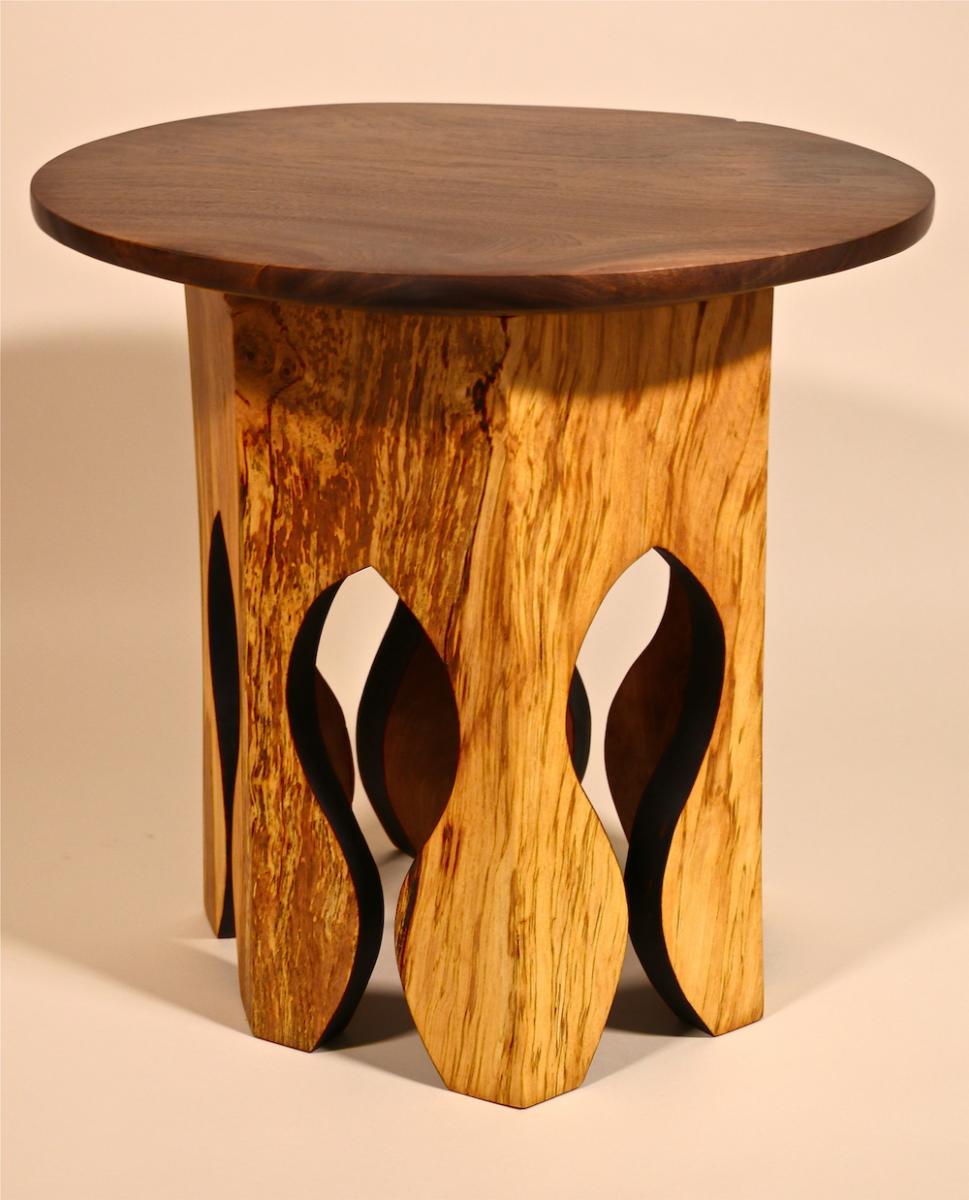 “Sailing, acting, feeding a bunch of farm animals smarter than me,” writes GORDON BAIRD. “New grandchild, old dogs, same old 1946 Farmall tractor— still runs great! So do I!”
“Sailing, acting, feeding a bunch of farm animals smarter than me,” writes GORDON BAIRD. “New grandchild, old dogs, same old 1946 Farmall tractor— still runs great! So do I!”
“Though hardly considered Pioneers, those of us in the class of ’72 are surprised to realize it’s been 46 years since our graduation,” writes GAIL HENRY. “I’m still in my family home in Salisbury, New Hamphire, and about to retire from my most recent 18-year career as a volunteer. I’ve served on the board of Sterling College, thanks to its former president, my Marlboro classmate WILL WOOTTON, plus numerous boards and committees in my hometown and area. My swan song is chairing the Sestercentennial (250 years) of the incorporation of Salisbury. When that ends December 31, I’m done with good-deed-doing. I plan to do more traveling while I’m still able. To those of you whom I haven’t seen in many years, consider this fair warning.”
’74
“Marlboro is a special place, and I find myself telling many people what a wonderful atmosphere the school has, and about special classes and teachers I remember,” writes SHAYLOR LINDSAY. “I know small colleges are struggling these days, and I really hope Marlboro can keep being a haven of humanity, curiosity, and creativity for many years to come.”
’76
CHERRIE COREY led a bird walk for the local community at the Hogback Mountain Conservation Area. Cherrie recently moved back to Marlboro, after retiring from Harvard’s Museum of Natural History.
“Hi to all Marlboro friends,” writes MARY COUGHLAN. “Please look me up when in the DC area. My business as an elder care companion/chef continues to fulfill me in many ways. Daughters Chloe, arts undergrad at Virginia Commonwealth University, and Kelsey, clinical researcher at UCSF Hospital, are thriving. Swimming laps outdoors is my current bliss!”
’82
DANIEL PICKER writes, “My fictional short stories have appeared in The Abington Review, Kelsey Review, and 67th Street Scribe. My non-fiction travel essays and reviews have recently appeared in the Philadelphia Inquirer, The Sewanee Review, Rain Taxi Review of Books, and Harvard Review.”
’85
In June, JOHN VON WODTKE road a 100-mile bike ride to benefit the Boys & Girls Club of Brattleboro in solidarity with Bruce Springsteen, who played an Asbury Park Concert to benefit the local Boys & Girls Club. “It takes a village to raise a child, so please consider giving to this great resource and help me outride the Boss,” wrote John.
’86
“I continue to work for NOAA Fisheries in Seattle, WA, where I work on seabirdfisheries interactions and other conservation conundrums, while raising fledgling naturalists and footballers (global, not American),” writes TOM GOOD. “I enjoy the sport vicariously now through Porter (10) and Hadley (7), who know I ‘played soccer in college’ (never had before, but hey, anyone who wanted to play did, of course). I fondly remember fall days on the pitch with an eclectic crew—LEOPOLDO and JORGE BATLLE (’88), PIET VAN LOON (’88), BERNIE MCDONNELL (’87), EVAN BEND, and DAVE ROSS (’88), among others.”
Tom Good ’86: Science for Sound Policy At a time when the significance of science is challenged at every turn, Tom Good is doing original research and collaborating with others to turn good science into sound policy. A research fishery biologist for the US National Oceanic and Atmospheric Association (NOAA), Tom works on seabird-fishery interactions including incidental seabird mortality and seabird predation of fish stocks.
“I still love going into the field and doing biology,” says Tom, who works at NOAA’s Northwest Fisheries Science Center in Seattle. “A big reason I became a field biologist was the time I spent in the field at Marlboro—trips with Bob Engel and John Hayes to the Everglades, the Yucatan Peninsula, the desert southwest, and central Mexico.”
Tom says that tutorials with Bob were instrumental in designing the field research for his Plan, and gave him a leg up when he went to graduate school. As one of the early participants in Branch Out, he also feels like this new online platform will be another valuable resource for new graduates (see page 22).
“I like the groups, where you can join or solicit group membership based upon Marlboro experiences or professional commonalities. I also like seeing regional happenings,” Tom says. “I’m hoping Branch Out serves as both a touchstone for alumni to past and present students and a platform for helping spread the word to the ‘outside world’ about the opportunity Marlboro still represents for scholars of all stripes.”
’88
Jet Airways, India’s premier international full service carrier, announced in May that it has appointed ATHAR KHAN as its vice president for Americas. Athar joins Jet Airways after having spent over two successful decades with leading international carriers such as Delta Air Lines, Qatar Airways, and American Airlines.
SCOTT CALLAGHAN writes, “Living in San Francisco’s Noe Valley neighborhood, raising my 11-year-old daughter, working as an RN, and surfing Ocean Beach every chance I get.”
’90
In May, SARA COFFEY kicked off her campaign for the Vermont House of Representatives, Windham-1 District, with a crowd of residents from Guilford and Vernon. “We’ve got something special and rare here in our small rural towns,” she said in a press release. “We have such a strong sense of community, but we are dealing with some challenging issues in our state and I believe that we need someone who can put aside party politics and bring people together to find common ground and creative solutions to some of the challenges that we are facing here in our small Vermont communities.” Learn more at saracoffeyvt.com.
’92  Celebrating the culmination of PETER BLANCHETTE’s tenure as the musical director for Happy Valley Guitar Orchestra, the orchestra performed the world premier of his Concerto for Guitar Orchestra in May. According to the program, this three-movement piece is the first concerto ever written for guitar orchestra, and is a mosaic of musical fragments, remembered from the composer’s earliest musical awakenings. Peter uses sounds as diverse as the opening chords from the Rolling Stones’ “Brown Sugar”, to flamenco dances, to snapshots of Bach’s Well-Tempered Clavier to create a mesmerizing musical pilgrimage.
Celebrating the culmination of PETER BLANCHETTE’s tenure as the musical director for Happy Valley Guitar Orchestra, the orchestra performed the world premier of his Concerto for Guitar Orchestra in May. According to the program, this three-movement piece is the first concerto ever written for guitar orchestra, and is a mosaic of musical fragments, remembered from the composer’s earliest musical awakenings. Peter uses sounds as diverse as the opening chords from the Rolling Stones’ “Brown Sugar”, to flamenco dances, to snapshots of Bach’s Well-Tempered Clavier to create a mesmerizing musical pilgrimage.
’93
“When not producing work for the paying gigs, DAVID SNYDER spends a lot of time mentoring and recording local musicians—many of them students— supporting the early careers of the region’s gifted artists.” So says a photo essay about David’s Guilford Sound, published in April on createinvermont.com. Learn more.
’94
In March, RANDY KNAGGS joined more than 300 other advocates in Washington, D.C., on a march to meet with members of congress and share stories of the personal impact Parkinson’s disease has made on their lives and the lives of their loved ones. Delegates educated lawmakers about the need for federal funding for research toward a cure for Parkinson’s, and policy support for those living with the disease. “The chance to come together with hundreds of people like me, share our journey and show our nation’s leaders what it means to live with Parkinson’s disease is powerful,” says Randy.
’97
“It has been a huge deal in my life, a huge transformation, being able to accept and acknowledge myself as Warren Zevon’s daughter and a singer-songwriter on my own,” said ARIEL ZEVON in a January article about her new album, The Detangler. The theme of the album, according to the article, “is strength in solitude, or sometimes the search for strength in solitude.” Read more.
’98 DAVID WILLIAMSON writes, “I completed my doctorate on June 19, 2018, at Temple University’s Fox School of Business, where I studied management with a focus on organizational behavior and leadership.”
’00
“As I kick-off my campaign for State Representative in Brattleboro, I’ve been thinking of my long-ago time on the hill,” said EMILIE KORNHEISER in April. “My campaign slogan is Committing to Community, and I learned about community for the first time at Marlboro— both the possibility and the skills to realize it—in Town Meeting, in the classroom, and on the steps of the dining hall.” Learn about her campaign at emiliekornheiser.org.
’04
BRAD MORITH accepted admission to Texas A&M’s PhD in history program. “I am truly excited!” he writes. “I have five years of funding, including a full tuition scholarship, TA position, travel research startup account, and fifth-year graduate lectureship to teach at that university. For my research area in late Cold War history, this is an ideal place to study, with a number of first-rate scholars in 20th-century American diplomatic history and the George H. W. Bush Presidential Library on campus. To get here, Marlboro College was instrumental, and I am truly grateful for my experience on Potash Hill.” Brad’s MA thesis at LaSalle University was “George Shultz and Eduard Shevardnadze: Collaborating diplomats who helped end the Cold War.”
After 12 years building community and career in Portland, CHOYA ADKISON-STEVENS is quitting her organizer job, getting married (in the spiritual, not state, sense of the word), and departing the U.S. with her beloved wife at the end of summer for indefinite international travels. If you have connections abroad (pretty much anywhere, we are looking at a lot of prospective destinations) that you want to share, please be in touch!
’05
ELIZABETH ESCO CRAIN writes, “I’m in my sixth year of running Leafhopper Farm in Duvall, Washington. Check out my blog: leafhopperfarm.com. Loving an outdoor life in the Pacific Northwest.”
’07 “I am in the process of starting a new lab for seed health testing,” writes JORDAN HENDRICKSON. “The lab I work for, Ag-Biotech, does mostly molecular markers and is focused on the agricultural market, so they wanted to start providing seed pathogen testing as well, so here I am. I mostly test commercial vegetable seed, so tomatoes, peppers, brassicas, etc. Our clients can range from giant agricultural companies like Monsanto to organic heirloom seed companies like Johnny’s. It’s actually pretty fun because it’s a nice mix of super traditional seed wash assays, pathogenicity tests, reading of bacterial colonies on agar, and molecular techniques. It also of course means that I work with a lot of plants, which as a commercial scientist I’m pretty thrilled about.”
LYDIA BOROWICZ writes, “I’ll be starting a PhD program in the fall, and I appreciate the academic foundation Marlboro College provided for me.”
’08
RENATA CHRISTEN lives in Amsterdam, the Netherlands, where she works as a research analyst. Her career has focused on agriculture and sustainable development, with an emphasis on agrobiodiversity. In her spare time, she moonlights as a copywriter for Dutch organizations and companies. Funding contingent, she plans to start either a seed company or PhD over the next few years.
’09
“In the fall I was on campus filming the Bridges trips with my partner Melissa,” writes PATRICK KENNEDY. “I cut a rough version for myself in October to test the rig I was using.” See the video.
“I am nearly into my fourth year working as a therapist for a community mental health agency,” writes TALIA JACKSON. “I am focusing a lot on trauma work and trying to maintain a goal of healing in a system that is overloaded.”
’10
“I’m a natural-born collaborator,” says AMBER SCHAEFER, in an article in Shoot Magazine about her new position as comedy director for Los Angeles–based More Media. “That’s why I prefer improv over stand-up, because you’re creating these worlds together. More Media feels like the perfect place to continue doing that work.” Learn more.
Olivia Sanders ’10: Teen Identity and Wellness 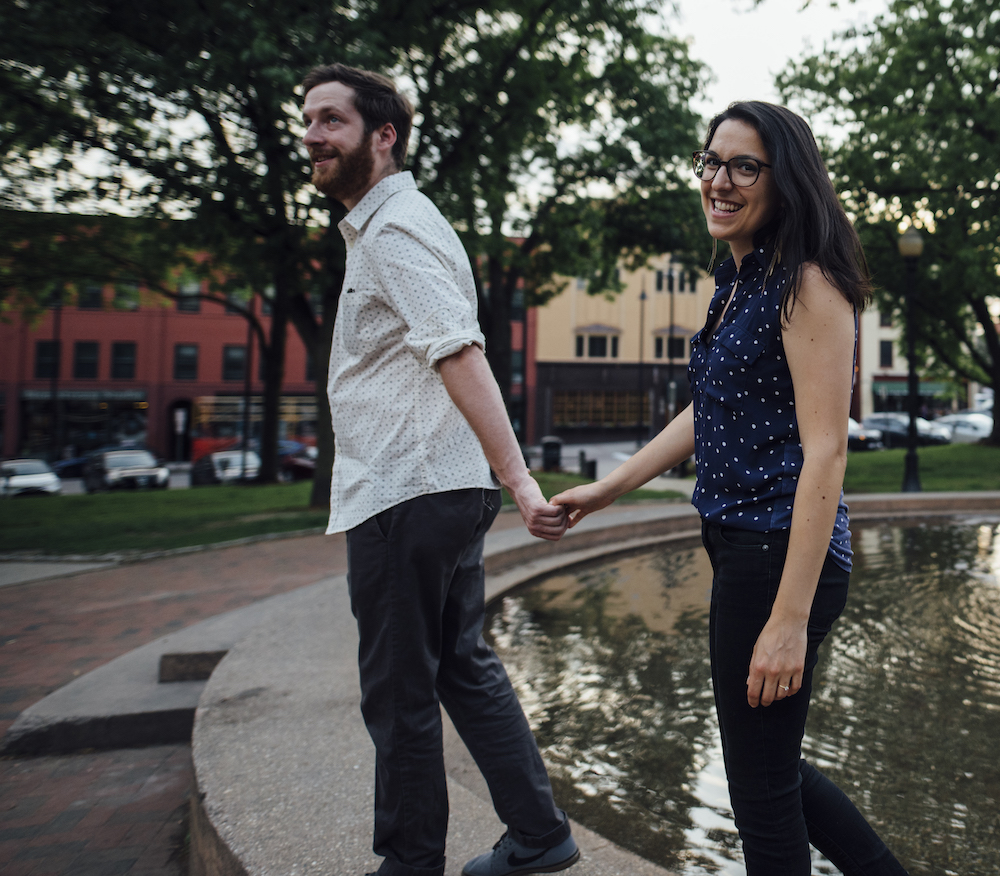 “One of the best things about being a counselor for teens is getting to witness and help with my clients’ identity development process,” says Olivia Sanders, who works at a community mental health center in Burlington, Vermont. “I love helping young folks to gain awareness of themselves, their values, and who they want to be in the world, as well as find communities where they feel loved and supported.”
“One of the best things about being a counselor for teens is getting to witness and help with my clients’ identity development process,” says Olivia Sanders, who works at a community mental health center in Burlington, Vermont. “I love helping young folks to gain awareness of themselves, their values, and who they want to be in the world, as well as find communities where they feel loved and supported.”
Olivia’s Plan of Concentration focused on adolescent identity development and gender studies, and continues to directly and positively relate to her work. “My Plan not only influences my daily clinical practice, but set me up with an in-depth and complex foundation in psychology that exceeded other undergraduate programs,” says Olivia. After completing a graduate degree at University of Vermont’s clinical mental health counseling program, she was immediately hired for her current position.
“I primarily work with young people who are struggling with trauma, substance abuse, depression, anxiety, and/or navigating identity development,” says Olivia. “I have a particular interest in bringing sexuality, social justice, and sociocultural aspects of identity development into my work, exploring issues of power and oppression, and making sense of the world my clients live in. This looks like conversations about consent and communication with partners, or having a space to talk about their thoughts and feelings about school shootings or racism in their schools.”
On a more personal note, Olivia and Noah Burke ’10 (pictured above) are still together and getting married in September.
’13
ALEXIA BOGGS writes, “I just got hired as associate attorney for Radiant Solutions, an aerospace corporation that uses remote sensing satellites to provide geospatial intelligence services and products to government agencies and commercial customers.”
In May, Lady Jane (ESPERANZA FRIEL) appeared with House Sparrow in a North Adams, Massachusetts, concert titled “Shut the Folk Up.” Her bio says she is taking her music more seriously and recording songs for an upcoming album called Fish and Foot.
’14
“I just got accepted into the medicinal chemistry/pharmacognosy doctorate program at University of Illinois at Chicago, following the Natural Products Drug Discovery track,” writes DANIEL ZAGAL. “I will be relocating from Brattleboro, where I have lived since I graduated Marlboro, to Chicago for the beginning of the spring semester 2018.”
’15
“There’s nothing wrong with being a cute and casual baker, but my experience with it is as work, and I don’t want to have that trivialized,” says MAYA ROHR in an April interview about her life of baking on the BBC. Maya recently finished an apprenticeship with a Swedish chocolatier and is back in Homer, Alaska, where she is managing and catering at the family bakery, Two Sisters. Learn more.
JAY SAYRE is currently a PhD student at University of California, Berkeley.
’16
“I am currently in rehearsal for the world premiere of Tabula Rasa, my fourth opera,” says FELIX JARRAR in an April interview with Broadway World. “Tabula Rasa is a jazz-opera about 1920’s model Kiki de Montparnasse and her passionate relationship with photographer Man Ray. The main arch centers Kiki’s self-discovery that she is not Man Ray’s object to be destroyed.” His new work premiered as part of the 2018 Opera Fest. Read more.
GRADUATE AND PROFESSIONAL STUDIES
Management 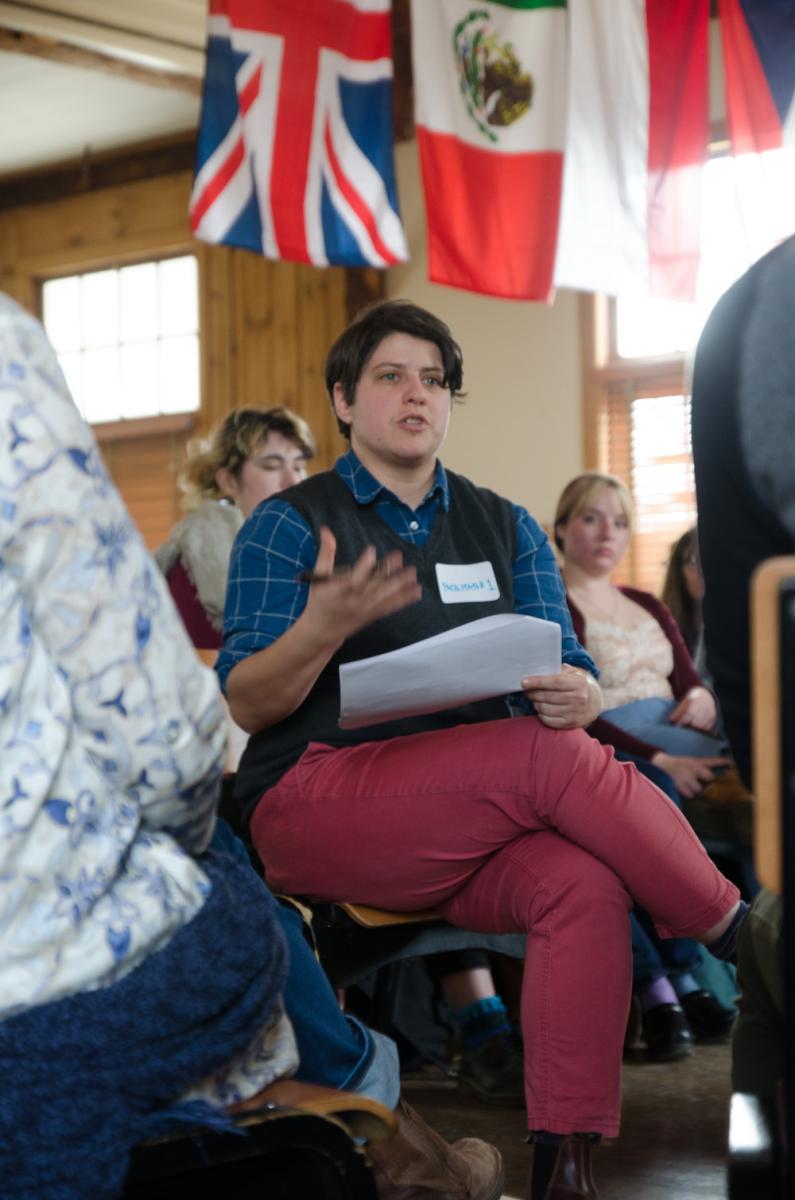 ALLISON GRIPPE MSM ’08 was appointed as hired as director of grant strategy and development at Oakton Community College, outside Chicago, in February. She has worked with community colleges for 11 years, in the areas of resource development, grant writing and management, budget development, and strategic planning, and has served as elected president for the Illinois Community College Resource Development.
ALLISON GRIPPE MSM ’08 was appointed as hired as director of grant strategy and development at Oakton Community College, outside Chicago, in February. She has worked with community colleges for 11 years, in the areas of resource development, grant writing and management, budget development, and strategic planning, and has served as elected president for the Illinois Community College Resource Development.
In January, HILLARY ORSINI MSM ’14 was appointed to the board of trustees for the Howard Center, a Burlington-based nonprofit offering life-saving crisis and counseling services to children and adults. Hillary is a program manager at Vermont Energy Investment Corporation, and serves on the boards of several local nonprofit organizations.
BRADFORD SMITH, who earned a certificate in nonprofit management in 2015, was appointed as the first executive director of the Vermont Learning-Support Initiative in March. This nonprofit organization offers collaborative support to teens with learning and attention challenges who aspire to a college degree. “As a parent of a child with significant learning issues, I have seen firsthand in my family, in Vermont, and elsewhere what it means to learn differently, and how much that affects those who struggle and those around them,” said Smith in an article in Vermont Business Magazine. “I am humbled that the board has granted me this opportunity to guide VLSI as it ramps up its efforts to support learners who, in spite of their challenges, dare to dream big.”
Teaching
ALAN SILVERMAN MAT ’12 was promoted to quality assurance manager at SunSetter Products, a manufacturer of awnings in Malden, Massachusetts. “My ability to understand processes, document them, train people, and continually improve procedures has not gone unnoticed,” Alan writes. “We are reinventing the way Sunsetter builds products, and I am going to be a significant contributor to this process. Many in our factory are Spanish speaking, so that is my next learning curve. I want to create instructions that cross language barriers. Think IKEA. I would love to find an art class that promotes icons and imagery to instruct without words.”
WENDY LEBLANC MAT ’13 was recognized with an Excellence in Education Award at Oakmont Regional High School in Ashburnham, Massachusetts, in June 2017. A business and technology teacher at the high school and career internship coordinator, she is credited with helping “countless students wade into the job market,” according to an article in the Sentinel and Enterprise. Learn more.
Emmanuel Ajanma MAT ’16: Increasing Inclusion with Technology 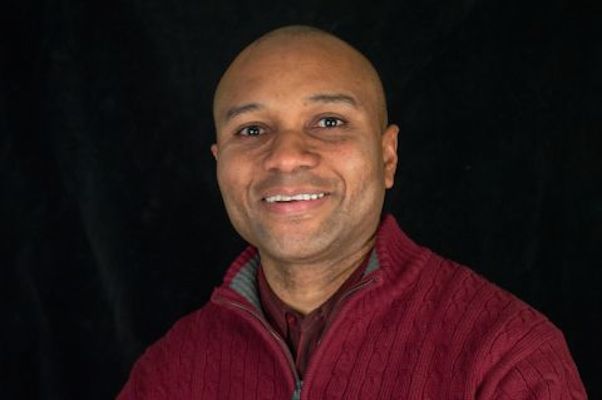 When he completed his Capstone in the Teaching with Technology program, creating training materials on Google collaborative tools for a Nigerian secondary school, Emmanuel Ajanma had no idea it would take him so far, right here in Vermont. Initially the technology integration specialist at Central Vermont Career Center, he recently became the director of technology for all of Barre Supervisory Union.
When he completed his Capstone in the Teaching with Technology program, creating training materials on Google collaborative tools for a Nigerian secondary school, Emmanuel Ajanma had no idea it would take him so far, right here in Vermont. Initially the technology integration specialist at Central Vermont Career Center, he recently became the director of technology for all of Barre Supervisory Union.
“I have expanded on my Capstone, and still use it for training in my district today,” says Emmanuel, who manages technology resources and staff to support the needs of faculty and students in the Barre area. “I love that I get to apply the extensive technology skills that I acquired during my time at Marlboro College. The MAT program was critical in preparing me for this position.”
Emmanuel collaborates with administrators, teachers, parents, students, and school board members, something that he finds very fulfilling and that Marlboro’s tight-knit community helped prepare him for.
“I feel honored using technology to increase equity, inclusion, and digital citizenship practices in our school community,” he says. “I get to make decisions that are student centered, even if those decisions are difficult. I help provide access to devices and information students need to learn, grow, and compete in the world.”
Bookshelf
“Because my colleges were for periods of time under tremendous, even crushing, stress, my career required what was for me an unnatural level of discipline and focus; a grim, sometimes frenetic determination; and a sense of humor equal to the thickness of my skin. Also critical to my longevity was an overwhelming awareness of the irony which enveloped these colleges and their presidents like a gaggle of minor Greek gods—mocking, sympathizing, punishing, rewarding, ignoring.” —Will Wootton, Good Fortune Next Time
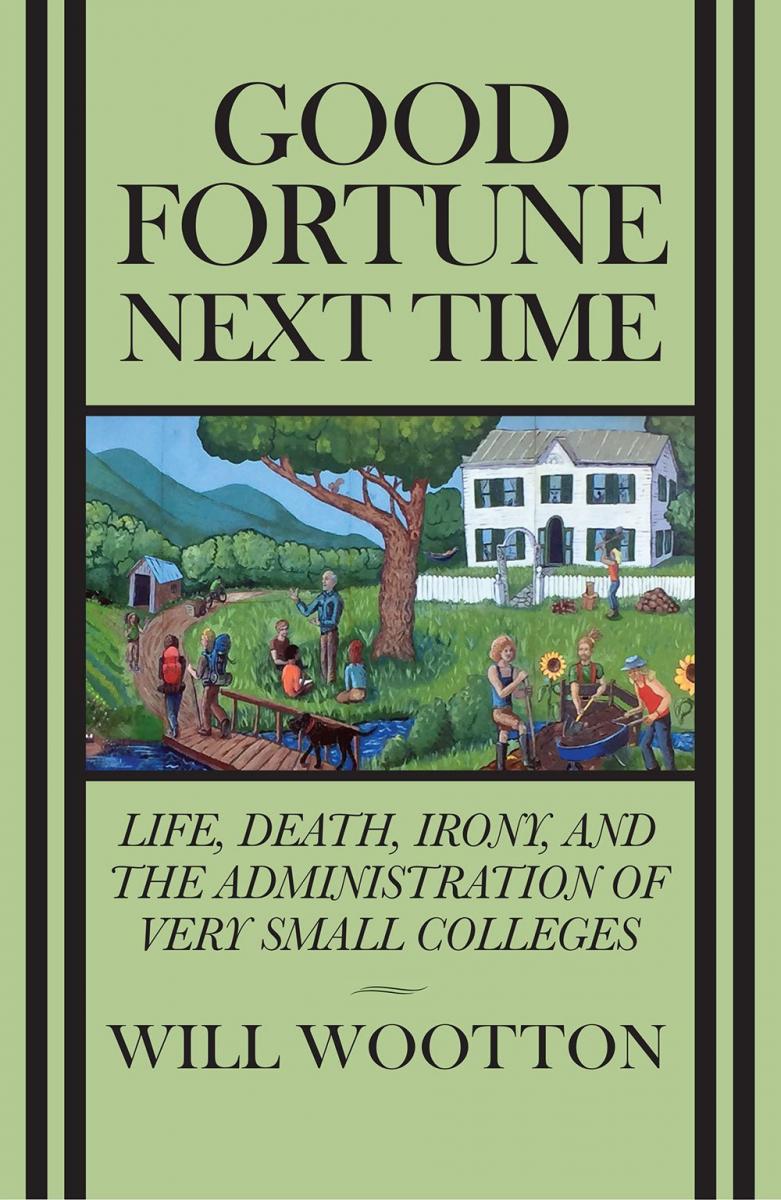 Good Fortune Next Time: Life, Death, Irony, and the Administration of Very Small Colleges (Mandel Vilar Press, 2017), by Will Wootton ’72, is a literary memoir tracking Will’s 29-year odyssey through the halls of academia. His journey takes readers from Marlboro College to Montserrat College of Art, and finally to his six years as president of Sterling College, where he coaxed the small but beloved college back to life.
Good Fortune Next Time: Life, Death, Irony, and the Administration of Very Small Colleges (Mandel Vilar Press, 2017), by Will Wootton ’72, is a literary memoir tracking Will’s 29-year odyssey through the halls of academia. His journey takes readers from Marlboro College to Montserrat College of Art, and finally to his six years as president of Sterling College, where he coaxed the small but beloved college back to life.
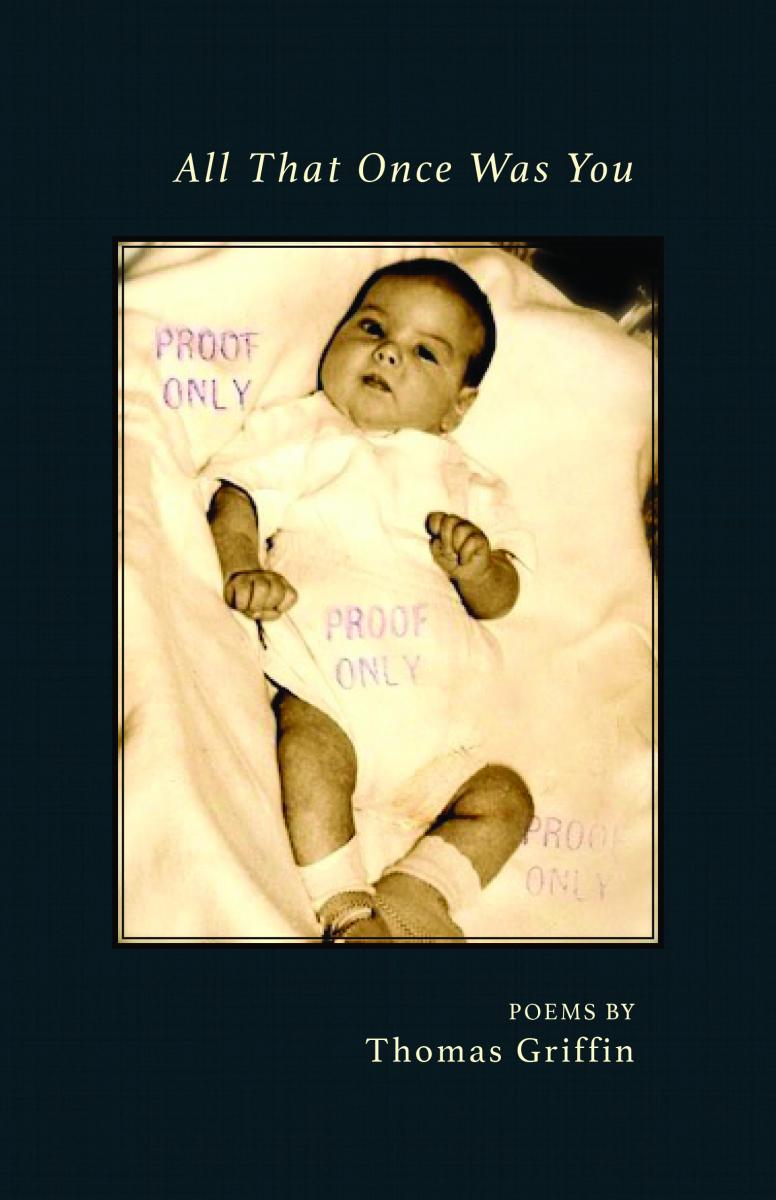 All That Once Was You (Finishing Line Press, 2018) is the first collection of poems from Thomas Griffin ’86, whose work has been nominated for the Pushcart Prize and recognized with an Academy of American Poets Prize. “In poems filled with delicately nuanced music (‘intoxicated moths,’ ‘the puckered lake relaxes,’ ‘every tree’s leaves knuckled down’), Thomas Griffin holds out an almost Keatsian hand to us,” writes poet Kate Gleason.
All That Once Was You (Finishing Line Press, 2018) is the first collection of poems from Thomas Griffin ’86, whose work has been nominated for the Pushcart Prize and recognized with an Academy of American Poets Prize. “In poems filled with delicately nuanced music (‘intoxicated moths,’ ‘the puckered lake relaxes,’ ‘every tree’s leaves knuckled down’), Thomas Griffin holds out an almost Keatsian hand to us,” writes poet Kate Gleason.
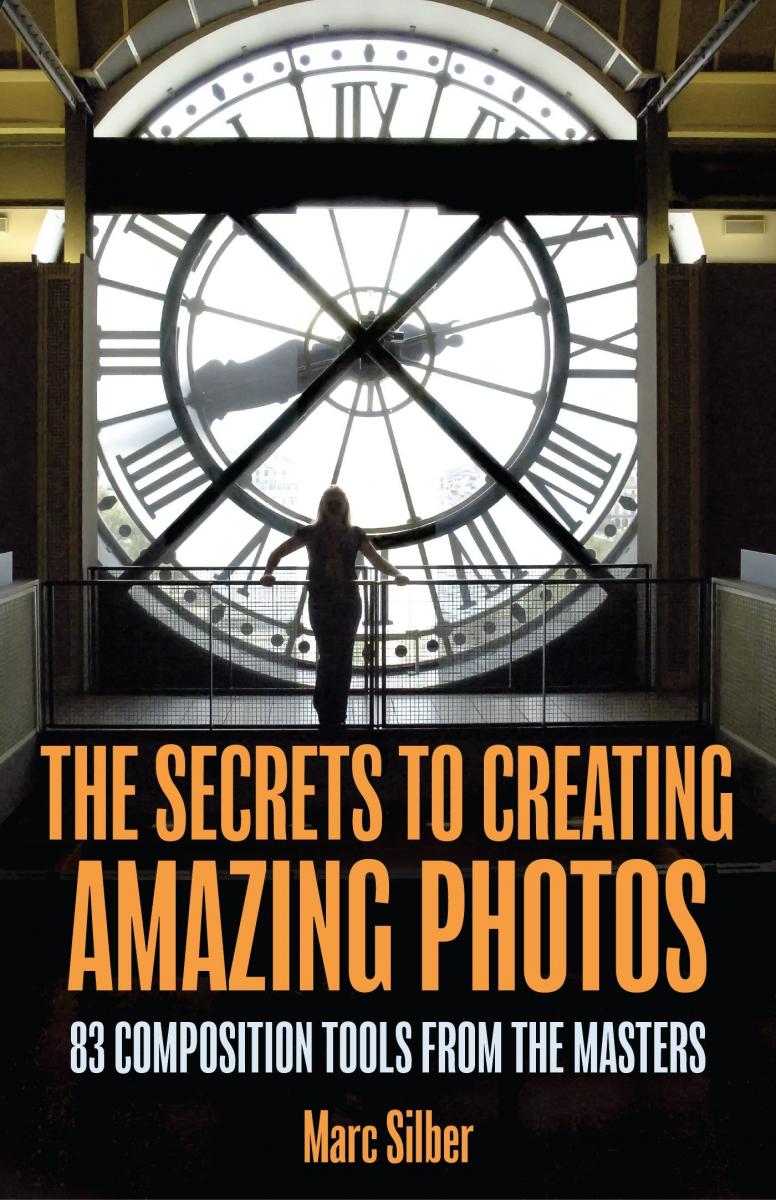 The Secrets to Creating Amazing Photos (Mango Press, 2018), by Marc Silber ’73, offers easy-to-follow composition recipes based on Marc’s years of study and interviews with master photographers. “This is the book we’ve all been waiting for—a concise and compact guide covering a full spectrum of composition tools, just the size you can bring with you for inspiration in the field,” writes Brian Taylor, Center for Photographic Arts.
The Secrets to Creating Amazing Photos (Mango Press, 2018), by Marc Silber ’73, offers easy-to-follow composition recipes based on Marc’s years of study and interviews with master photographers. “This is the book we’ve all been waiting for—a concise and compact guide covering a full spectrum of composition tools, just the size you can bring with you for inspiration in the field,” writes Brian Taylor, Center for Photographic Arts.
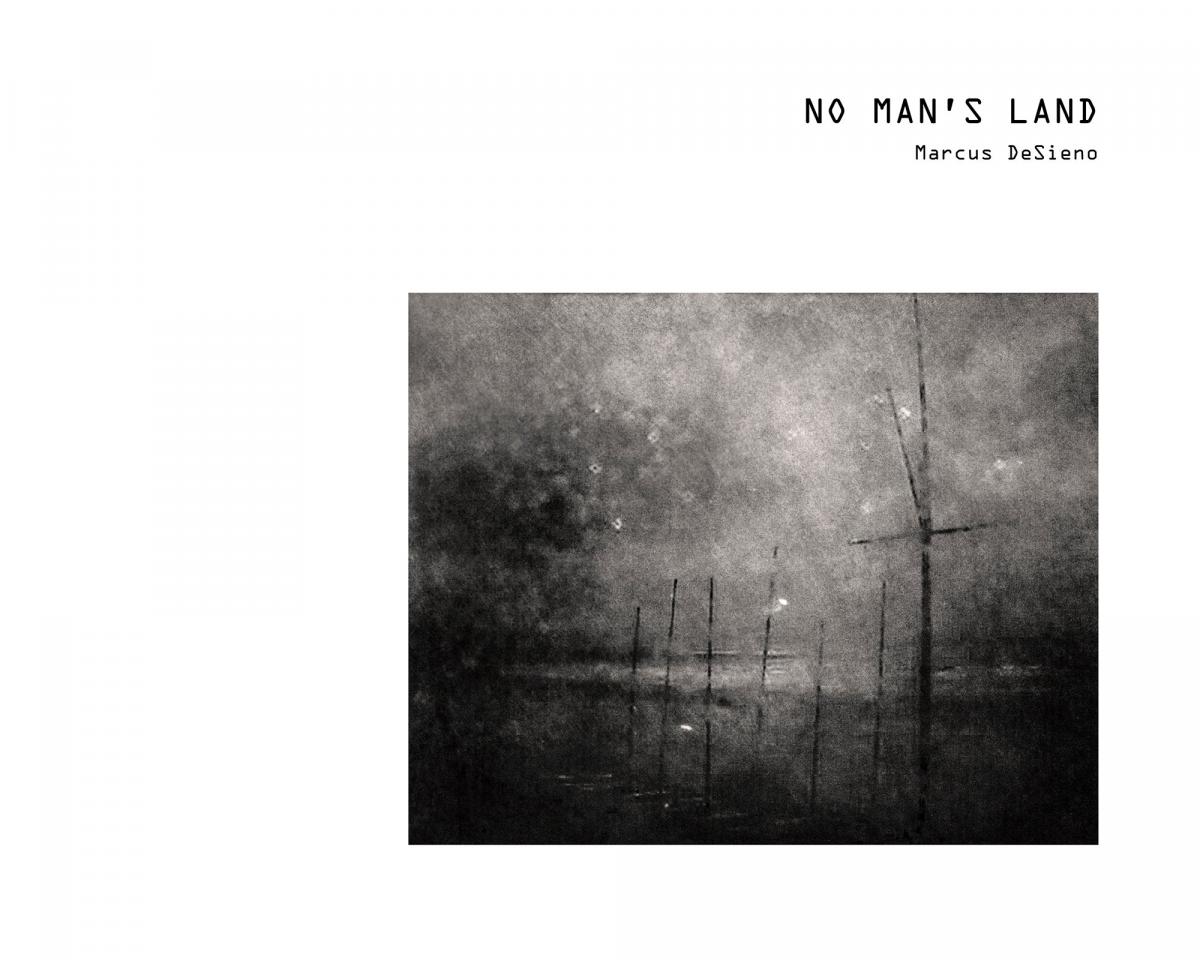 No Man’s Land: Views from a Surveillance State (Daylight Press, 2018), by Marcus DeSieno ’10, is a beguiling collection of landscapes pulled from hours of security camera feeds, reminding us that we are never truly alone. “By effectively rescuing the unvalued landscapes caught up in the digital surveillance of humans acting badly, DeSieno asks us to think about what these places are without us,” writes historian Martha Sandweiss in an accompanying essay.
No Man’s Land: Views from a Surveillance State (Daylight Press, 2018), by Marcus DeSieno ’10, is a beguiling collection of landscapes pulled from hours of security camera feeds, reminding us that we are never truly alone. “By effectively rescuing the unvalued landscapes caught up in the digital surveillance of humans acting badly, DeSieno asks us to think about what these places are without us,” writes historian Martha Sandweiss in an accompanying essay.
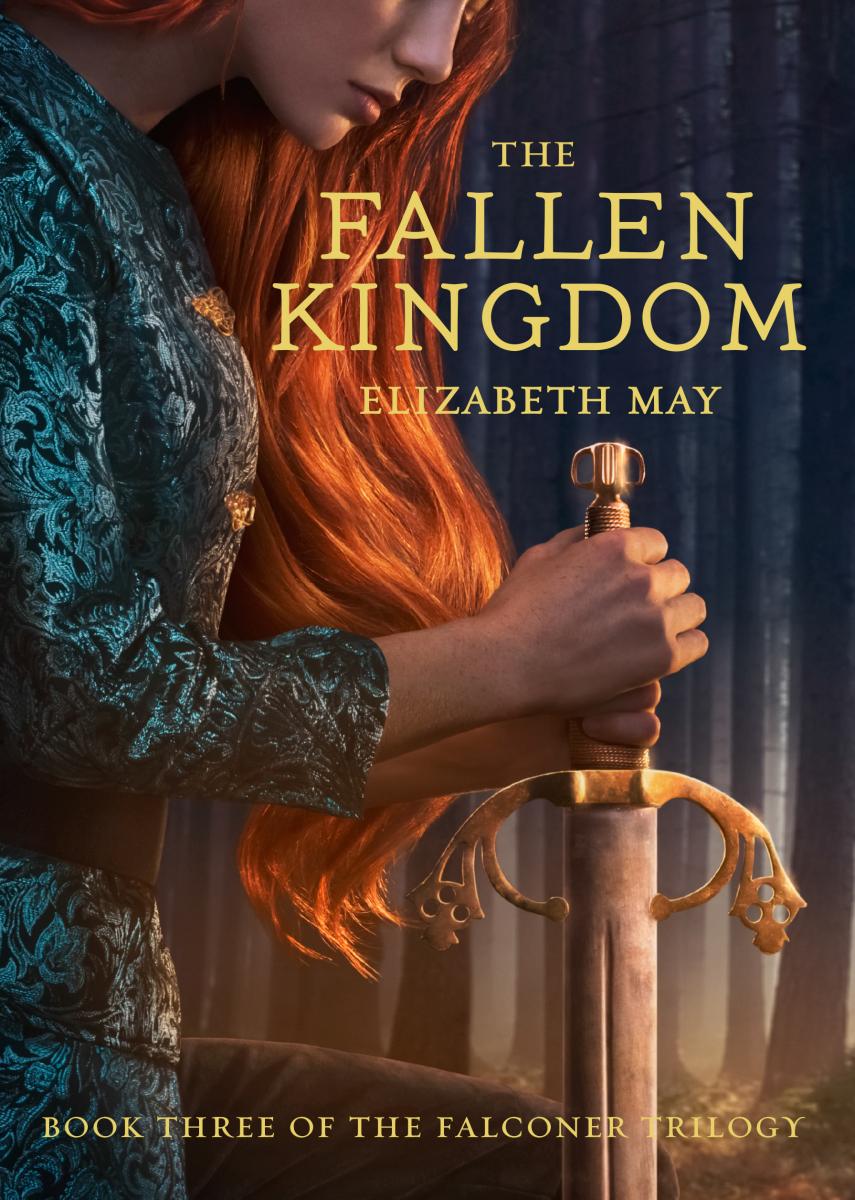 The Fallen Kingdom (Chronicle Books, 2017), by Elizabeth May (Holzhauser) ’08, is the final book in her Falconer trilogy for young adults. Resurrected by ancient magic, the heroine Aileana returns to the world she once knew with no memory of her past and with dangerous powers. To save the world and the people she loves, she must learn to harness these powers even as they are slowly destroying her.
The Fallen Kingdom (Chronicle Books, 2017), by Elizabeth May (Holzhauser) ’08, is the final book in her Falconer trilogy for young adults. Resurrected by ancient magic, the heroine Aileana returns to the world she once knew with no memory of her past and with dangerous powers. To save the world and the people she loves, she must learn to harness these powers even as they are slowly destroying her.
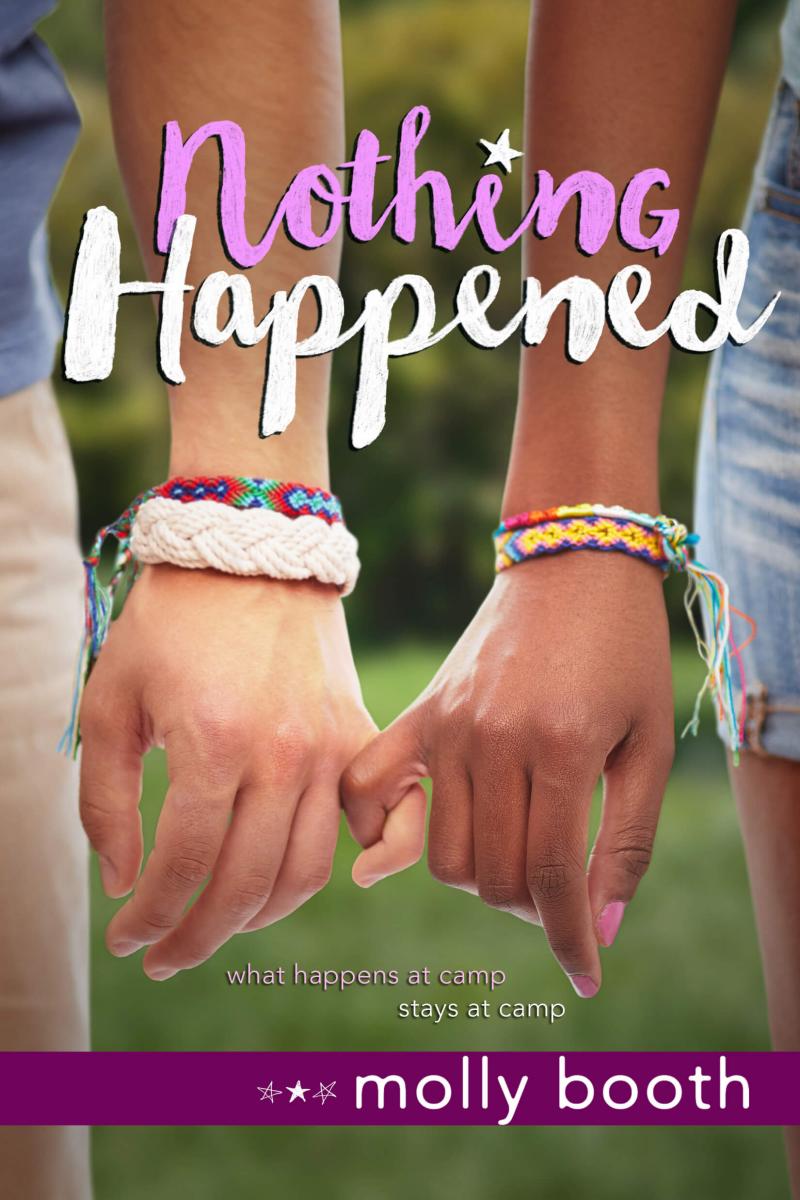 Nothing Happened (Disney-Hyperion, 2018), is the second young adult novel from Molly Booth ’14. A modern-day retelling of Shakespeare’s Much Ado About Nothing, Molly’s Nothing takes place at an idyllic summer camp where counselors find the improv stage isn’t the only place for drama. “With its vibrant, diverse cast and respectful depiction of mental health issues, this playful adaption of Much Ado About Nothing isn’t just for Shakespeare lovers,” said Booklist.
Nothing Happened (Disney-Hyperion, 2018), is the second young adult novel from Molly Booth ’14. A modern-day retelling of Shakespeare’s Much Ado About Nothing, Molly’s Nothing takes place at an idyllic summer camp where counselors find the improv stage isn’t the only place for drama. “With its vibrant, diverse cast and respectful depiction of mental health issues, this playful adaption of Much Ado About Nothing isn’t just for Shakespeare lovers,” said Booklist.
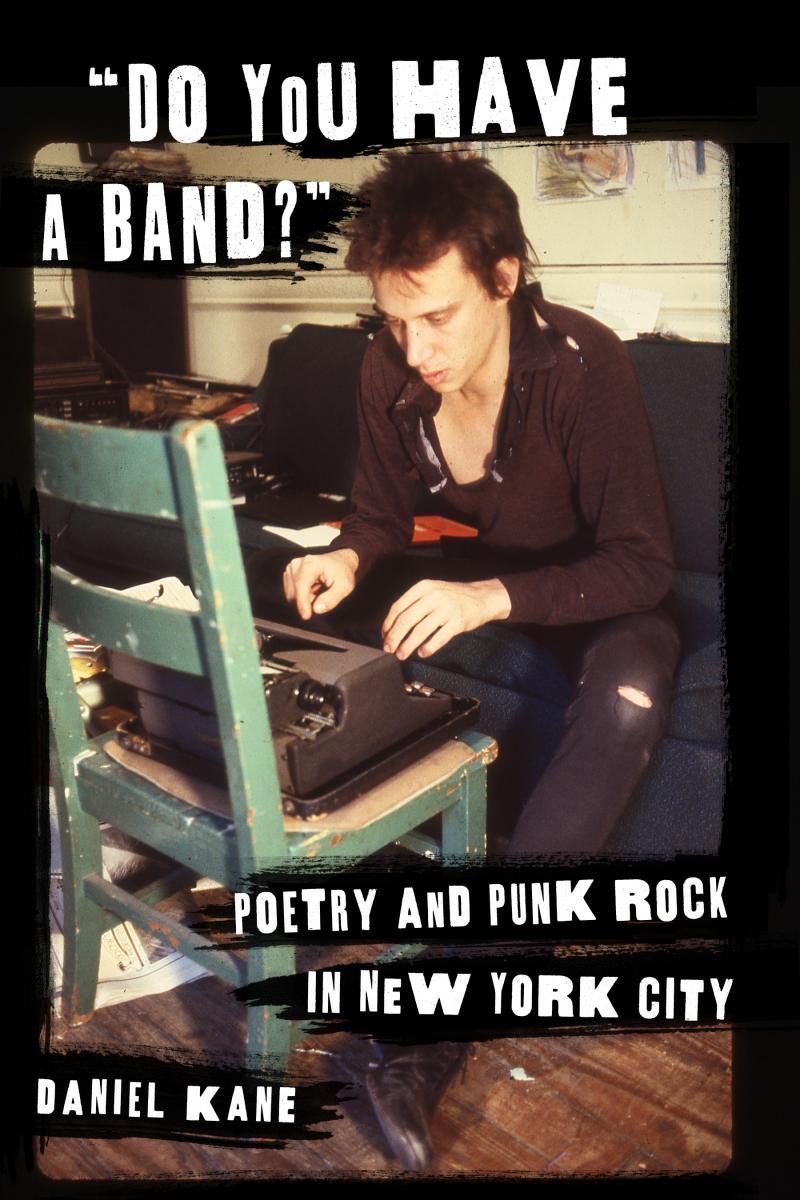 “Do You Have a Band?”: Poetry and Punk Rock in New York City (Columbia University Press, 2017), by Daniel Kane ’90, captures a compelling exchange between poets and musicians and its challenge to the lines between lyric and poem. “Do You Have a Band? is a formidably researched and galvanizing cultural history of the poetry–punk rock connection, with its lofty aspirations, history, gossip, and genius,” writes author Anne Waldman.
“Do You Have a Band?”: Poetry and Punk Rock in New York City (Columbia University Press, 2017), by Daniel Kane ’90, captures a compelling exchange between poets and musicians and its challenge to the lines between lyric and poem. “Do You Have a Band? is a formidably researched and galvanizing cultural history of the poetry–punk rock connection, with its lofty aspirations, history, gossip, and genius,” writes author Anne Waldman.
In Memoriam
Bob Engel, natural world scholar
by John Hayes
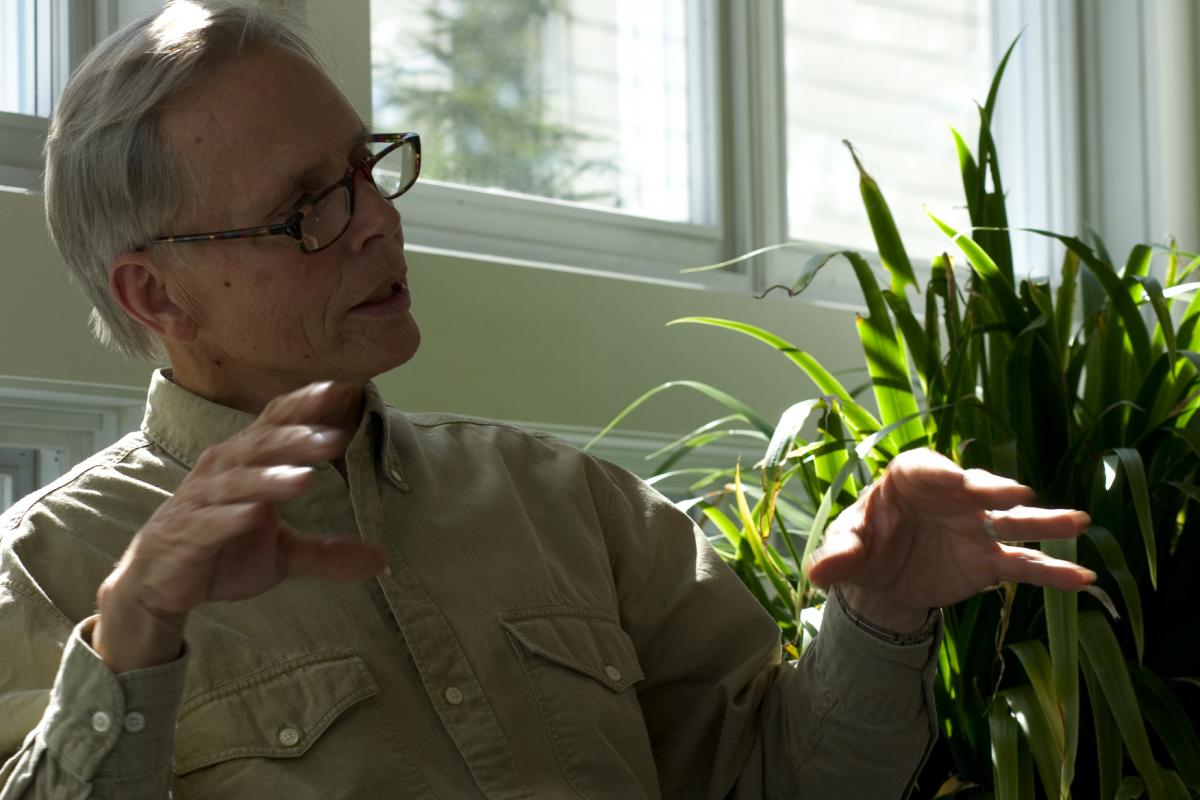 Bob Engel, mentor to hundreds of students, friend to countless others, died on January 22 of a brain tumor that was diagnosed in July 2017, just shortly after his wife, Mallory, died. As T. Wilson said, “Throughout Bob’s last months, he remained deeply appreciative of the physicians and nurses who dealt with him. He knew much more about the complexity of what they do than most patients and always told them how impressive they were, even when they had just told him that the prognosis now was ‘weeks, not months.’”
Bob Engel, mentor to hundreds of students, friend to countless others, died on January 22 of a brain tumor that was diagnosed in July 2017, just shortly after his wife, Mallory, died. As T. Wilson said, “Throughout Bob’s last months, he remained deeply appreciative of the physicians and nurses who dealt with him. He knew much more about the complexity of what they do than most patients and always told them how impressive they were, even when they had just told him that the prognosis now was ‘weeks, not months.’”
Bob cared about people, but he cared about the natural world more. When we were walking through head-high grass on the African savannah looking for a white rhino, he asked our guide what he planned to do with that rifle. The guide said, “If a rhino charges, I’ll shoot it.” Bob said, “No way. If a rhino charges, shoot me instead.” Bob would have much preferred going that way, rather than have his mind ravaged by a brain tumor.
Besides his brilliant mind, Bob had a well-developed, irreverent, scatological sense of humor. His leukemia, his hepatitis C, and Mallory’s cancer were more than anyone should have to endure, but Bob found a way to put all that in perspective. Many of us were shocked when he told us that he had gotten a tattoo, but it made sense when we found out that it was an image of a scarab, a dung beetle, Li’l Sisyphus, as he said, “rolling a ball of shit uphill.”
When he arrived in fall 1975 as Marlboro’s sole biologist, Bob’s biggest fear was feeling incompetent. He arrived directly from his PhD program at UC Santa Barbara in his VW bus, B-hole, along with his parrots, Dulce and Harold, and Popcorn the dog. His professors had recommended him as someone who knew more about various biology fields than anyone else they knew.
But Bob’s knowing a lot also led him to understand how much he didn’t know. He often related the story of one of his first Plan students, an exasperated Nanda Fleming ’76, marching into his office, hands on hips, after not getting any solid answers on previous visits, asking Bob, “And what is it exactly that you do know?”
Bob’s self-deprecating sense of humor belied the depth of his biological knowledge. He continually astounded us with how much he knew, especially those who had the great good fortune to traipse around the globe with him. He used to sit down during the summer with a state’s “flora”—a thick, dense tome, no pictures, just line drawings—and learn every one of that state’s plants. As many have said, you could set him down anyplace on the planet, and he would do a quick 360 and know exactly where he was.
He never seemed happier than when he was engaged in discussions with people, students or not, about biology or motorcycles or whatever. Despite his astounding repertoire, he would always look you in the eye and want to hear your thoughts. He clearly cared about you. And that attention to you personally, more than any other reason, is why legions of students and others were so profoundly influenced by Bob.
John Hayes is former professor of chemistry and dean of faculty at Marlboro, and retired dean of the College of Arts and Sciences at Pacific University. Read more tributes to Bob, and join John, emeritus faculty member T. Wilson, and biology professor Jenny Ramstetter in contributing to Marlboro College in Bob’s memory.
Andrew Hilton, former trustee
A longtime friend of the college and former trustee and board chair, Andrew Hilton died in May. Andy grew up in Jackson, Mississippi, and joined the air force at age 17. After military service he received his bachelor’s degree from the University of Maryland, and then his PhD in industrial psychology at Case Western Reserve. Andy had an illustrious career at the Psychological Corporation, Raytheon, ITT, and eventually at Colt Industries, where he worked until his retirement as vice chairman in 1993. He was very proud of his six-month service with the Job Corps in 1965, and was an avid reader, traveler, theater lover, and tennis player.
Larry Smith ’51
A lifelong resident of Winchester, Massachusetts, Lawrence Smith died in April. Larry was a graduate of Winchester High School, and served in the army before being honorably discharged. He studied international affairs and economics at Marlboro, and said in an alumni survey that the “broadened knowledge and social consciousness acquired from the ‘Marlboro Experience’ led me to a happy and productive life.” He served as financial officer for the Massachusetts Law Reform Institute until his retirement. Larry enjoyed participating in local theater productions and was an avid tennis player. He gave years of service to the town of Winchester culminating in his position as chairman of the board of selectman in 1976.
Jonathan Glasby ’55
A resident of Elmhurst, Illinois, Jonathan Glasby III died in January. Jonathan served in the US Army Air Force before he came to Marlboro College, where he studied geology and was the last of several World War II veterans to graduate. He was fond of saying he graduated sixth in his class, of whom there were six. He was employed for many years as a geologist for the United States Geological Survey. In 1999 Jonathan asked biology professor Bob Engel and Allison Turner MS ’99 about acquiring one of the old microscopes used in the 1950s, and was gratified that they turned one up, still in its mahogany case.
Sumner Bennett ’61
A resident of Amherst, New Hampshire, formerly of Cambridge, Massachusetts, Sumner Bennett died in June. Born in New York City, Sumner graduated from Chauncey Hall School, in Boston, and served in the army for two years. At Marlboro he studied science and the history of science and met his future bride, Bridget Gorton ’59, daughter of longtime faculty member Audrey Gorton ’55. He worked for many years as the director of marketing for Allison Acoustics, a consumer electronics manufacturer, and then went on to real estate. In an alumni survey Sumner said his leisure time activities included “whitewater boating, walking, cutting wood, running, and dog brushing.”
Stuart Cawley ’83
Thanks to notification from a fellow alumnus, we learned that Stuart Cawley, a resident of Little Compton, Rhode Island, died in April 2013. Stuart attended Newark Academy, New Jersey, before coming to Marlboro College, where he studied theater and acted in several productions. He went on to work as a talent agent in New York, with clients including Carrol O’Connor, Glenda Jackson, and Stacy Keach. In the 1990s Stuart studied culinary arts at Johnson and Wales University and catering at the Culinary Institute of America, then worked in the restaurant and catering business, including owning the Beachcomber Pub in Westport, Massachusetts.
Markus Brakhan ’86
A resident of Germany, Markus Brakhan passed away in May. Markus grew up in Wilton, Connecticut, and graduated from Marlboro with a Plan in political science and history focused on the concept of “legitimate power” in early modern political thought. Markus earned a JD from Franklin Pierce Law Center, and went on to practice law in Burlington, Vermont, and Jackson Hole, Wyoming, before immigrating to Germany. He authored six books, including Too Cubed Unauthorized Vols I-IV. Markus loved skiing, mountain biking, concert going, and swimming, and always had a very green thumb. He is remembered by his closest friends and family for his loyalty, humor, intelligence, passion, and intensity.
Geoffrey Hendricks, friend
The son of founder Walter Hendricks and longtime friend of the college, Geoffrey Hendricks died in his home in New York City, in May. Geoffrey attended the Putney School and received a bachelor’s degree from Amherst College and an art certificate from Cooper Union. He taught art at Rutgers University and received his master’s at Columbia University. A performance artist and member of the Fluxus movement, Geoffrey was known for experimental works ranging from The Flux Divorce to his signature headstands performed all over the world. He was instrumental in the recent establishment of the Poet’s Garden, a contemplative space in the woods behind campus dedicated to his parents.
Magnanimity Cum Laude
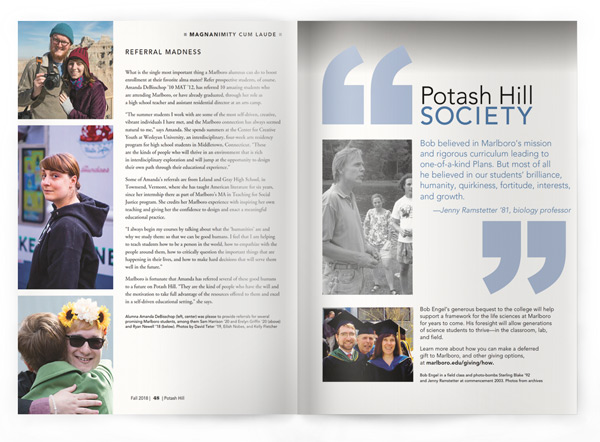
Referral Madness
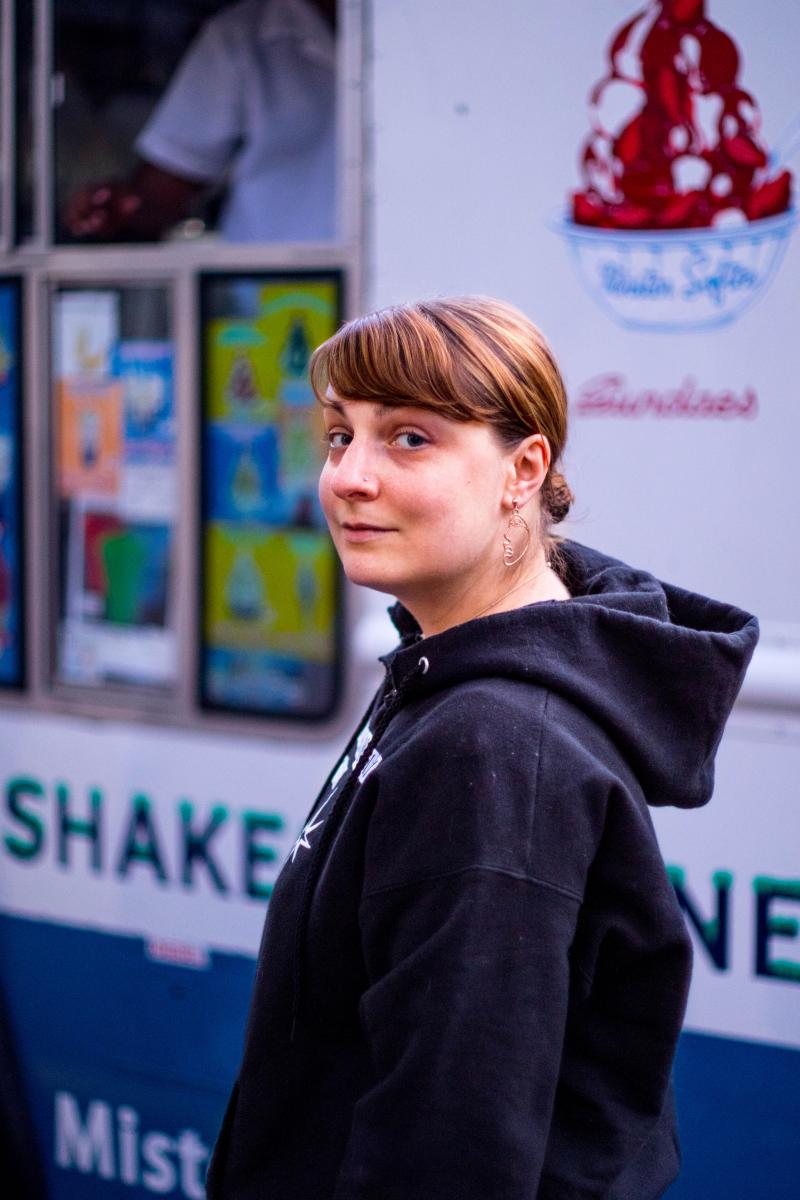 What is the single most important thing a Marlboro alumnus can do to boost enrollment at their favorite alma mater? Refer prospective students, of course. Amanda DeBisschop ’10 MAT ’12, has referred 10 amazing students who are attending Marlboro, or have already graduated, through her role as a high school teacher and assistant residential director at an arts camp.
What is the single most important thing a Marlboro alumnus can do to boost enrollment at their favorite alma mater? Refer prospective students, of course. Amanda DeBisschop ’10 MAT ’12, has referred 10 amazing students who are attending Marlboro, or have already graduated, through her role as a high school teacher and assistant residential director at an arts camp.
“The summer students I work with are some of the most self-driven, creative, vibrant individuals I have met, and the Marlboro connection has always seemed natural to me,” says Amanda. She spends summers at the Center for Creative Youth at Wesleyan University, an interdisciplinary, four-week arts residency program for high school students in Middletown, Connecticut. “These are the kinds of people who will thrive in an environment that is rich in interdisciplinary exploration and will jump at the opportunity to design their own path through their educational experience.”
Some of Amanda’s referrals are from Leland and Gray High School, in Townsend, Vermont, where she has taught American literature for six years, since her internship there as part of Marlboro’s MA in Teaching for Social Justice program. She credits her Marlboro experience with inspiring her own teaching and giving her the confidence to design and enact a meaningful educational practice.
“I always begin my courses by talking about what the ‘humanities’ are and why we study them: so that we can be good humans. I feel that I am helping to teach students how to be a person in the world, how to empathize with the people around them, how to critically question the important things that are happening in their lives, and how to make hard decisions that will serve them well in the future.”
Marlboro is fortunate that Amanda has referred several of these good humans to a future on Potash Hill. “They are the kind of people who have the will and the motivation to take full advantage of the resources offered to them and excel in a self-driven educational setting,” she says.
Potash Hill Society
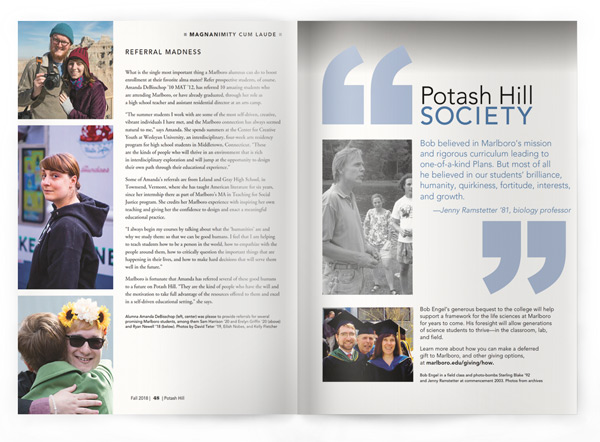
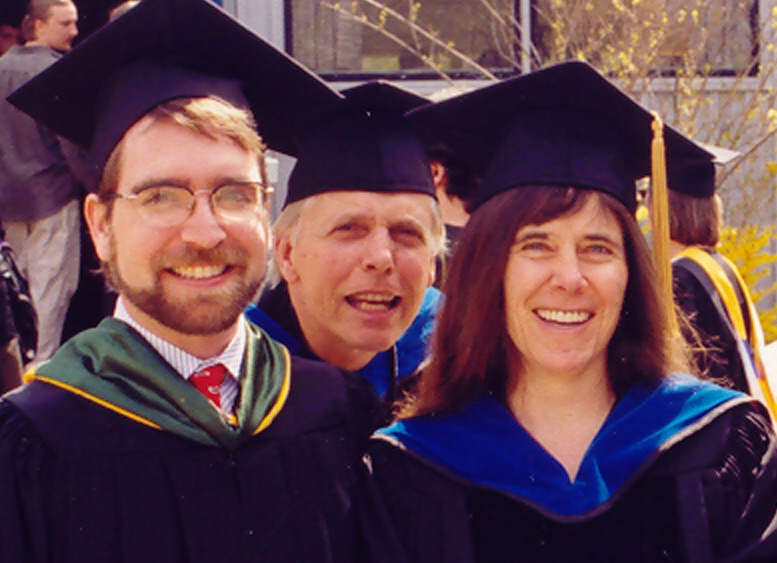 “Bob believed in Marlboro’s mission and rigorous curriculum leading to one-of-a-kind Plans. But most of all he believed in our students’ brilliance, humanity, quirkiness, fortitude, interests, and growth.”
“Bob believed in Marlboro’s mission and rigorous curriculum leading to one-of-a-kind Plans. But most of all he believed in our students’ brilliance, humanity, quirkiness, fortitude, interests, and growth.”
—Jenny Ramstetter ’81, biology professor
Bob Engel’s generous bequest to the college will help support a framework for the life sciences at Marlboro for years to come. His foresight will allow generations of science students to thrive—in the classroom, lab, and field. Learn more about how you can make a deferred gift to Marlboro, and other giving options, at marlboro.edu/giving/how.
Special Web Features
Math as a Living Subject: An interview with Matt Ollis
In May, Hannah Noblewolf ’18 sat down with math professor Matt Ollis to talk about math—obviously—game theory, student research, and sustainability.
Hannah: Remind me, how long have you been at Marlboro?
Matt: I arrived in 2003, so I’m just finishing my 14th year. My first year was as the math fellow.
H: So, very few people actually enjoy math to a degree where they’d spend most of their lives doing it. What about math appeals to you so much?
M: Hmm, I don’t know. At school and high school I didn’t particularly love it. I enjoyed it well enough and was good enough at it that I kept going in that direction. Then when I was an undergrad I did a “research experience for undergrads” in the UK. That was the first time where I realized what it was actually like to do math, rather than just understanding the recipe in the book to follow—given this problem you do these steps and get this number and you put a red circle around it and everyone is happy. It’s much more, “Okay, here’s a problem that no one knows the answer to, you’ve got a batch of tools you can use, and you can try and invent new ones: try and come up with something. And we came up with some new little advance in math that no one else knew about and admittedly very few people cared about it. [laughter]
H: But if you cared about it, then...
M: It was a very different feeling, sort of like advancing knowledge in a way that math had never been to me, before that. It was fun to work on, very similar in vibe to solving puzzles. Like, if you enjoying doing Sudoku puzzles it’s the same sort of feeling of not knowing how to do something, figuring out how to work it all out, putting it all together and a feeling of success when you do it. I’ve found that doing math, upper-level math, has much more of that feeling to it than high school math does, or at least did for me. I got hooked at that point, sort of late in the process. I went from “math is what I seem to be best at, I’ll keep on doing it” to actually wanting to do it.
H: Where did you do that research experience?
M: I was at Queen Mary in the University of London, and then the research was in Keele, which is a small university that’s basically in this very small town, so the whole town is this small university.
H: Kind of like Marlboro? [laughter]
M: Except it’s much bigger than Marlboro. [laughter]
H: Yeah…
M: There were many thousands of students. Obviously at University of London, it’s embedded in London. Like it’s a small part of a huge city. Keele’s a very different vibe, and still a big place, but out in the countryside in the middle of England.
H: Do you see a utility for math no matter what your goals are? Do you think everyone should do math to some extent?
M: Sort of, but only in the way that I think everyone should do languages, and poetry, and like a hundred other things that no one actually has the time to do all of. I’m certainly against having a math requirement at Marlboro. I really like the sort of structure where people work out what it is they want to do and need to do, and are able to do that. So I try and make the math curriculum accessible in that sense, so that anyone who realizes that they want to add some math in can do so. What I’d really like is for everyone to think that they want to do some math. [laughter]
H: That’s funny.
M: I think most people would think that they’d want to do ceramics for example, because ceramics seems fun. And they don’t all get to actually go and do ceramics, but it seems vaguely appealing to most people and many people actually follow through on it. The bit that I’d like to change, if I had the power to change anything, is that sense of “yes I would like to do it.” I’d like everyone who leaves Marlboro to at least have the attitude that they could’ve done some math if it had fit together, and it would have been a valuable thing to do. There are all sorts of reasons why you might do that, ranging from it’s a beautiful thing to study and it’s fun to do, to you want to go and build bridges and you don’t want them to fall down. [laughter]
H: Ha, makes sense.
M: I’d like people to appreciate that more, and see how it might fit in with what they’re doing, even if they don’t end up doing it that same way. When you think about languages, perhaps, whatever you’re studying there’s probably something in another language that will help. And while you may not learn that language, you’d recognize it as something that you’d want to do given infinite time. I don’t think people feel that about math in the way that they do other subjects, which is a shame.
H: It is. What could we do to attract more people?
M: Every semester we try and offer a class, between me and the math fellow, that’s really inviting to different sections of the community.
H: I know that people always get really excited about the Theory of Game class.
M: Yeah. That is a class we’ve offered a few times, sort of like a “what’s going on” with board games. It’s certainly less than half math in that class, but there’s a bit of probability—sort of understanding dice—and then there’s traditional game theory—‘which is both math and economics, people interacting, making decisions—and also design features—like art components. People in that class can take whatever they’re most interested with in relation to games and run with it. The final project is usually either to design a small game or a component that adds on to an existing game, and changes it in some way. People have done some really creative things with that.
H: I know you offered that my first year and everyone was so excited.
M: Yeah, I think it’s run twice now. Maybe three times? Actually the first class came out of a Plan. There was a student who wanted to do game studies and did a brilliant Plan in a mix of economics, history, and math—all of those tools being brought to bear on games. There’s so much you can do with that.
H: Who was that?
M: Ian Mahoney (’12). Since then we’ve had a couple more people. For Martin Cahill (’10), we got an outside evaluator from Hasbro, which was cool. He was a game designer. It was really funny. Martin’s final project was a space-based combat game, and the guy from Hasbro was actually working on a space-based combat game at the time, which he couldn’t tell us about because he was under a non-disclosure agreement. [laughter]
H: What happened?
M: He said yes, Martin had been wrestling with some of the same sort of problems: how to make it feel like a game that’s set in space—other than just having spaceship encounters. What is it about being in space that you want to convey, and what’s different? That was a really really good orals, and it went well. It also means I got to be second reader on Plans that have got nothing to do with math at all. Paul Vorvick (’10) did one in sociology and theater, and he was really interested in the storytelling aspect of games and role playing, which I sort of tend not to be interested in as a general rule. But it was really fun to work with Paul and be able to look at these things and think about them.
H: So are you currently doing any sort of research outside of Marlboro?
M: Yes, but in many ways it’s not outside of Marlboro. I’ve tried with varying levels of success to maintain a research program—n the last few years it’s gotten increasingly more systematic. I’ve involved students here in research and there’s various ways to do that. If they’ve any interest in my subfield of math, then they can often incorporate that in their Plan and we can collaborate on that. Ambrose Sterr (’07) was probably one of the first. Our research was part of his Plan, we co-wrote a paper together, and that was great. I’ve since done it with a few other students.
H: That’s so great.
M: More recently, I’ve been getting money from the faculty professional development fund to employ a student research assistant over the summer, and that’s been really productive both for me and for the student. We’ve had a few papers come out of that as well. I’ve done that with Devin Willmott (’11), who’s now a grad student at the University of Kentucky, and Gage Martin (’16) who’s now a grad student at Boston College. And this year, (writing professor) Bronwyn Tate started this thing in November for NaNoWriMo, or National Novel Writing Month. And so for that I set up something I called MaMaReMo, or Marlboro Math Research Month [laughter]. I tried to do a little bit every day, and I’ve done that a couple times since, with Bronwyn and some others. The whole thing is accountability, so I’ve sort of told them what I’d done.
H: Cool.
M: Actually, one of the papers that I’ve worked on with Gage when she was a research assistant, we got stuck at one point. We were dealing with infinite objects and I usually play around with finite objects, so we didn’t quite have all the tools that we need. But (math fellow) Kaethe Minden plays with infinite stuff all the time. Usually different types of infinite stuff, but she was able to un-stick us, and we’re in the final stages of the three of us collaborating on a paper that we’re hoping to submit when we finish writing it. [laughter] It’ll probably be this summer. So that’s been really good.
H: So all of your research is in collaboration with Marlboro students?
M: I really have embedded it in Marlboro, and collaborate with Marlboro people a lot. There’s one project I’ve been working on for a while that’s almost finished as well, with John Schmitt from Middlebury College—he’s a mathematician there. Working on that with him has been fun. That's been a long, slow-ish one, but that’s almost done too.
H: How does your research tie in with teaching math at Marlboro?
M: I think it’s good to have an active research component to what I do as well. I think it helps the teaching here, as well as the sort of direct “hey here's an open problem that no one knows the answer to that you could work on and I can help you” with Plan students. Even in classes, having an active mathematician there, having that transition to thinking of math as a thing that people do and are still doing, as a living subject and there are problems that people still want to know the answer to. I think having someone who can embody that is different from having someone say, “here are the cookbook recipes, when you see this problem do these things.” Even if that’s the point of the course, and you’re just learning some Calculus to be able to apply these skills, I still think getting an appreciation for what math is is an important part of being in a math class.
H: What has been your role in encouraging sustainability monitoring at Marlboro?
M: I’ve been involved in various environmental committees, almost since I’ve been here. I’ve been on the EAC—the Environmental Advisory Committee—I had a break recently but I’m back on it now and I think I was the chair of it for six years, something like that. I’ve also been on the EQC (Environmental Quality Committee) and the Farm Committee, and as part of those roles I’ve tried to generally increase awareness about sustainability and change our practices—and also do various monitoring things.
H: What kinds of monitoring?
M: One of the things, when I was on the EAC last time around, was to introduce an annual energy report that looked at all the different buildings on campus, how much heating oil they used, how much electricity they used, and how those changed over time. It was a way to identify places where things seemed to be out of proportion, so we could do some work that would reduce the energy use. There are still problems, I’m actually going to be on the EQC next year, which is sort of the hands-on community action committee, about changing practices, whereas the EAC is much more structural and big picture. One of the big successes of the energy report, I think, was identifying the admissions building as one that was using a lot of energy for its size. So that’s where we put a lot of energy into retrofitting, and it cut its heating oil use down to one third of what it was previously, after adjusting for weather and how cold things are. It was a huge savings. There were lots of smaller things we did, other places where we identified that we could make a difference.
H: That was based on a class, right?
M: The energy report was just in the EAC, but then I did a class that was called something like “How Sustainable Is Marlboro College?” and that was looking more broadly. We used a couple of different ways to measure things, and the ecological footprint was one the main ones. That’s a much broader measure of how sustainable we are. How much electricity and fuel oil we use is a big part of it, but also how much trash do we generate, what’s our impact on the world overall, compared with how much the world regenerates—that’s sort of the setup for an ecological footprint. A good definition is how much average earth area would it take to regenerate the ecological systems that we’re using up by burning oil and generating trash. It’s hard to get a good absolute value for that kind of thing, for what it is, but what the real benefit of those things are is that we can track changes. So as long as we use the same methodology each time we do it, we get a comparison and we can say okay, we’ve tried to reduce our trash contribution to the regular waste stream and we can see: have we cut it in half, have we knocked ten percent off of it? Once we get these benchmarks in place we can try and improve in comparison, which I think is often a more useful internal tool than knowing just the total number.
H: What would you say is your favorite thing about teaching at Marlboro?
M: I think the close working relationship with students, and the collaboration, and how I decide what to teach based on what students want to do. They teach me new things, and I have to learn new things based on the direction that they’re interested in, where I was previously handed a syllabus and told here’s the syllabus, here’s exactly what you need to teach. Any changes had to go through committees, and it would very much be top-down, students’ interests wouldn’t have much of a say. Whereas here, even within an individual class, even a fairly standard one like Calc 2, I can say here are the things we definitely need to cover in Calc 2, so you know the sort of things that you should know, but then there’s still plenty of flexibility within that and as the students see what they’re interested in and what they enjoy most and what would be most useful to them we can adjust. And the classes are small enough that they can either split up and do their own thing and report back, or they can agree that they’re interested in the same direction and do that so that’s a really good feature. It works really well in classes and it works even more so in tutorials. That’s a really great process, having students so much in control of what they learn, and why they learn it, and making the choices about what they’re going to study.
H: Is it ever overwhelming? It must be sort of a double-edged sword, in a way, that you’re responsible for the whole math curriculum.
M: It can be, but mostly in a good way. It sort of comes back to the lack of math-focused students here, so I don’t have years where I’ve got eight students, all seniors, all pulling me in different directions. I quite often have to teach lots of classes because lots of students need some basic math skills to go and do other things, while other students needing fairly advanced math, so that they can do physics. There’s usually only the one or two students a year who are pulling me in new directions. So there’s usually something new I’m learning, while in the process of teaching, but it’s usually only one or two things at a time rather than ten.
H: Do you have any insider information on when our professor of coloring, Molly Ollis, will return from sabbatical?
[laughter]
M: She’s quite annoyed that someone else has taken over her office and she’s looking forward to reclaiming it this summer. She’s got a good attitude to teaching, she does it over the summer when the students aren’t here, and it’s much easier that way.
[laughter]
Remembering Bob: Stories about Bob Engel, biology professor emeritus
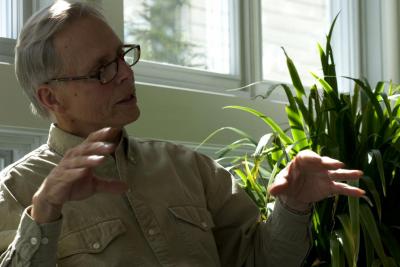
Nicknames
By John Hayes
Nicknames
Bob put his enormous vocabulary to use in surprising ways, often as euphemisms. Mixed grill referred to southern Vermont’s all-too-frequent mixture of snow, sleet, and freezing rain, which he hated. Free-flowing and sanitary referred ironically to the state of one’s digestive tract, particularly in regard to the aftermath of tropical biology field trips. Itzcuintlis (eats-queent’-lees), shortened version of the Mexican hairless dog name Xoloitzcuintli (which we corrupted to ess-quint’-las), referred to students’ parents.
He also liberally handed out nicknames, most of them less than flattering, except for those Bob held in deep respect, such as John MacArthur, who became Pa Pa (with the accent on the second Pa). Maybe others will share theirs on this website. Mine evolved in about 1980 on a spring break Florida ornithology field trip.
Just prior to spring break, I traveled to Ohio along with my then-wife, Joanne, and our daughter, Stefanie, to attend a greenhouse conference. The plan was to catch up with the Marlboro field trip already under way at Stephen Foster State Park in the Okefenokee Swamp in Georgia. Unfortunately, along the way we had one of those Saab stories (brakes) and were delayed a day. Bob and the students were nowhere to be found when we arrived at the park. But I knew in those pre-cell phone days that he would leave us a note.
When we didn’t find a note in the campground, we went to the ranger station, but the on-duty ranger couldn’t find a note for John Hayes. So, we went back to the campground to look again. Nothing. Back to the ranger station. Again, no note for John Hayes. After ruminating for a while about the lack of a note, Joanne went back in and said, “Are there any notes at all back there?” The ranger looked around and said, well, just this one, for “Meatloaf, Mrs. Loaf, and Little Burger.” Hah!
We met them the next day at the southern tip of Lake Okeechobee, and I became Loafy from then on.
Field Trip Highlights
By John Hayes
Georgia Karma. In the early days, not having access to a college van, we drove cars on field trips. When we camped at Stephen Foster State Park in the Okefenokee Swamp in Georgia, signs warned about feeding the wildlife. Ignoring those and Bob’s stern lectures about helping wildlife become too used to humans, Dan Brown fed peanut butter out of a half-filled gallon jug from the dining hall to the abundant raccoons. Sometime in the middle of the night, Jon Friedman awoke to find about a dozen raccoons, having climbed in through the open sun roof, inside Dan Brown’s Saab. They had opened the peanut butter container and spread oily tracks all over the cloth seats. It doesn’t seem like Bob could have dreamed up a better “I told you so” moment.
Costa Rica Body Surfing. In January 1981, Bob, John MacArthur, my then-wife Joanne, our daughter Stefanie, and I traveled to Costa Rica. For part of the trip, we camped out on Playa Naranjo in Santa Rosa Park to watch enormous leatherback turtles lumber up the beach to lay eggs while bioluminescent dinoflagellates lit up the surf with each crashing wave and the Southern Cross and other constellations that we can’t see in Vermont lit up the night sky. During the day, we body surfed on gigantic waves that tossed us head over heels up onto the beach. While Bob and I treaded water waiting for the next big wave, all of a sudden Bob took off swimming for the beach. When he got about half way there, he turned and yelled “Shark!” I looked around to see a giant fin out of the water maybe 20 feet away from me. Statistics show that sharks kill only about 5 people each year worldwide. Fortunately for me, I was not one of them. Bob undoubtedly knew about the low probability of attack; otherwise, why would he have taken off for the beach before pointing out the fin?
Red in Tooth and Claw. Students over the years have parodied Bob’s “love for all life forms.” We’ve watched him let mosquitoes bite him rather than squash them. He didn’t reflexively pull away when critters got a hold of him when he held them loosely, not wanting to hurt them. Invariably, some of these led to blood, often lots of it, such as the time a collared lizard clamped down on his finger in a California Joshua tree woodland, or when a garter snake grabbed the back of his hand in Yellowstone Park, or when someone’s or his own parrot bit down on his hand while handling them. No matter how hard most of us try, it’s almost impossible not to jerk one’s hand away when one is about to be or is being bitten. How Bob always held steady is an eternal enigma.
Hernias, B Hole, and Cactuses. While in Oaxaca on a tropical biology field trip, Bob was feeling “puny.” We took him to a clinic where the doctor diagnosed a hernia, which he wanted to operate on immediately. Unsurprisingly, Bob did not want to go under the knife deep in southern Mexico. So, we made a group decision to start out that night and to drive our several vehicles around the clock to McAllen, Texas, about a 20-hour drive, but extended 2 hours by getting split up in Mexico City. (So much for everyone’s advice not to drive at night in Mexico.) Bob wasn’t able to drive, so he tried to sleep in the back of B Hole, his Volkswagen bus, of which he was very protective. If you got above 60 mph, he could tell by engine pitch, and he would shout out to slow down. Of course, we wanted to spend as little time driving as possible, so there would be frequent shout outs. Along the way, we stopped by a field to pee. All of a sudden there was screaming, as Joanne had squatted on a cactus in the dark. Thanks to Kathy Welling and Chuck Hutchinson, Joanne was relieved of the cactus spines. Of course, with all the commotion, Bob roused from the back of the bus. When he found out that it was just a cactus and not a rattlesnake, there were recriminations about too much noise. Off we went again, arriving at the border at dark. At a clinic in Texas, Bob found out that he didn’t have a hernia and that all he needed were some little pills that would cause “some action” a little later. Having risked life and limb and cactus spines driving through the Mexican night, it’s no wonder that later on we came up with some descriptive phrases for Bob’s ailment, such as “Hernia, my ass” and “Bob sure had a shit-eating grin on his face when he came out of that McAllen clinic” and “Next time, we’re going to make sure that Bob drinks the water.”
Beauty and Ecology
By Jenny Ramstetter '81
I thought I might do better today if I started by thinking of someone else’s words instead of my own. In January, I began Robin Wall Kimmerer’s book Braiding Sweetgrass, and then I found Gathering Moss, by the same author, on Bob’s bookshelf.
In her essay, “Asters and Goldenrod,” Kimmerer reflects on her journey as a botany graduate student. She finds brilliant goldenrod in flower growing alongside its perfect counterpart the “full-on royal purple,” New England Aster. She writes, “Purple and gold . . . a regal procession in complementary colors. I just wanted to know why. Why do they stand beside each other when they could grow alone? Why this particular pair? . . . is it only happenstance that this magnificence of purple and gold end up side by side? What is the source of this pattern? Why is the world so beautiful? . . . It seemed like a good question to me. But my adviser said, ‘It’s not science.’” I knew Bob would have had a much more interesting response for a student who asked those questions, and I thought of how Bob shaped my life as a scientist and as a person.
I grew up mostly in Colorado, but my mom and brother and I moved to California for two years. As an 8-year old, I lived two streets away from Bob in Isla Vista as he began grad school at UCSB, though I can’t say if our paths ever crossed. Along the beach, I explored tide pools most every day, and on the bluffs above I made flutes from the non-native bamboo stalks. I watched in amazement as monarchs migrated in an undulating wave along the coast in groves of eucalyptus. On school trips, we went to the Santa Ynez Mountains and, according to my teacher, we saw one of the last California Condors flying free at that time. Back in Colorado, I returned to feeding grasshoppers blades of grass, rescuing baby birds, having garter snakes wrap around my arm, and chasing robins from the worms they were stretching from the soil. From elementary school through high school, I was fascinated by any living critter, but talked myself into the idea that I wasn’t good at science or math, and most of my science teachers did little to dissuade me of that notion. Instead of being a scientist, I would simply love the beauty in nature and leave its study to others. Ten years after my time along the Pacific coast, I headed east to Marlboro sight unseen. On my first day at the college, a VW van parked in front of the dining hall and filled with tropical plants and two parrots and Popcorn the dog piqued my interest. A day later I was on an Amtrak train to Montreal with the owner of that van and others here today so that we could ride our bikes the length of Vermont before starting the semester. On that bike ride from Montreal to Marlboro, we stopped along the road under the shade of trees I didn’t know and Bob picked up an acorn and asked many questions while admiring the acorn. I knew none of the answers, but I wanted to find out, and Bob’s awe and curiosity in a simple acorn were contagious.
These 40 years later, I’ve shared many moments of ecology and appreciation for life’s beauty with Bob including a desert biology field trip that ended in California. We went to the Santa Ynez mountains, and a large Coulter pine cone now lives in the science building from that trip. The last magical days of the field trip were spent on Santa Cruz Island off of the coast of Isla Vista hosted by one of Bob’s graduate school buddies and life-long friends; I thought back to when I stood on the beach as a kid looking out at Santa Cruz and wondering what treasures that island held. As with many of you, Bob was my teacher, mentor, colleague, and friend. I treasure it all, but I suppose I circle back to beauty most of all. A year ago April, my kids were on a Junior High class trip to Costa Rica, and I emailed Bob to tell him that they’d just seen a Resplendent Quetzal in the Monteverde cloud forest. Bob wrote back: “Yikes. I hope they understand what this boils down to: ‘The most spectacular bird in the western hemisphere,’ quoting Roger Tory Peterson.”
Bob saw beauty in spectacular birds and in the acorn. And he saw beauty in all of you and in a sweeping motorcycle ride. We will remain touched in both small and in life-changing ways by Bob. In moments when I might inspire or support family, friends, and students, I know it’s partly because of what I learned from Bob. Though it’s not a word he would use, I am blessed by all of you who knew Bob and cared for him and helped me so much during his illness and death. I am so grateful. I especially thank Brian and Senait and Zinabu who have lived with the burden of my sadness for many days and months now. In the past quarter century, the few times when Brian couldn’t fully comfort me, he would call Bob who would scoot over on his motorcycle, or car if need be. Bob would listen, usually make me laugh, and help me to figure out what to do next.
Now, I turn to all of you who have been touched by Bob, near and far and friends who couldn’t be here today. I know that the beauty of Bob’s life and our bonds together will help us all to care for each other and to care for the beauty of life around us just a bit more.
Toward Sicily
By Joanne McNeil Hayes
For Bob, July 2017
Sicilian heat rises
against red earth
inches toward buff clouds
like birds in open air.
What if passion is insecure,
playful, disheartened by silence?
If so, we turn to sunflowers
and love them in the shade or under water,
and when they dry to scrub and
blow listless in the wind,
we know that lives have passed us by.
We enter through a pastel sleep where
deep red moros hug the sky and
rain turns sunset a cobalt blue.
Poem for 3 Johns and a Bob
To come!
Arizona Visit
By Tim Tibbitts '80
I take some solace from remembering the last time I saw Bob in person. Not too many years ago, he took a solo spring break trip; flew to Phoenix, rented a snazzy motorcycle, and went on a road trip around Arizona. Toward the end of his trip, he spent a few days visiting in the tiny, remote town where I lived. I was amused, trying to reconcile the motorcycle fanatic with the man I first knew decades before. He was semi-retired, and still delving into new things with great passion. He was very happy and relaxed. We went for a few jaunts into the surrounding desert (not on the motorcycle) and spent a lot of time talking, back at the house. The morning he headed back to Phoenix, he rolled out the driveway in his silver motorcycle “moon suit,” waved, and flashed that big grin. 30 years after being his student, I was still—in fact more—impressed with his unique character. He wasn’t just a gifted teacher and brilliant biologist. He was also articulate, learned, and had great integrity, curiosity, humor, discipline, mischief, loyalty, and compassion. He improved the world with his time here.
Eyes for the Natural World
By Janet Humphrey '81
Bob was my professor and lifelong friend. I know I’m one of many whose life he changed in a most profound way, infusing it with his intelligence, spirit, wit and vision. I got to housesit for him one summer while he went out on the desert trip with John Hayes and a group of students, and cared for his menagerie‚dogs, birds, fish, roving turtle (and rubber snake on the greenhouse floor that I initially assumed was an actual pet!). I told him many times that he had given me the eyes with which to see the natural world. He taught me how to look at ecosystems and how to be inquisitive, and I carried that with me wherever I traveled. I’d usually email him for his thoughts on each different environment I visited. In a typical response, Bob said of Ecuador, “I went to the Galapagos with buddies and had a brief stop on the mainland...including a short trip to a nectar feeding reserve at 11.5 K feet. Fuchsias in bloom and saber-billed hummers with bills as long as the body.” He never stopped learning and teaching. I am so grateful to have known him and privileged to have called him my friend.
Naturally Gifted Teacher
By Peter Niewiarowski '84
When I came to Marlboro in 1979, I didn’t even know what Biology was. Then I took a class from Bob Engel, and I never looked back. I heard somebody say recently that Bob was a master teacher. It’s a massive understatement. He was a deeply and naturally gifted teacher. He blended brilliance, passion, empathy, comedy, and curiosity into every meeting, class or otherwise, that I had with him. As a mentor to me during the stages of my plan of concentration, he treated me as a colleague by critiquing my ideas. But he also nurtured me by always displaying his confidence in me and in the notion that I could make a substantive contribution to our knowledge about the world. I saw him do this with all his students, and it is clear he built a legacy on it. Bob and his co-conspirator John Hayes were chief architects (helped by other faculty and student sidekicks) of the academic climate that pervaded the science building. They were at once playful, serious, pranksterish, rigorous, humble, and opinionated. When I left Marlboro, I came to understand that this academic environment was uniquely Marlboro …an environment that Bob built, but one that also built Bob. I feel extraordinarily lucky to have been quite accidentally drawn in to it.
No Sharing
By Tom Good '86
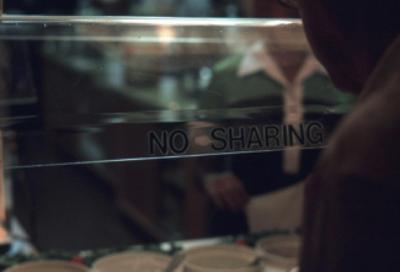 I was fortunate enough to be able to go on several Marlboro field trips, including trips to the desert southwest, the southeastern U.S. (Okefenokee, Everglades, etc.), the Yucatan Peninsula, and interior/central Mexico – a.k.a “the Campsite”). These were formative trips for a budding biologist, and spending time with Bob and John Hayes (and John MacArthur!) was invaluable.
I was fortunate enough to be able to go on several Marlboro field trips, including trips to the desert southwest, the southeastern U.S. (Okefenokee, Everglades, etc.), the Yucatan Peninsula, and interior/central Mexico – a.k.a “the Campsite”). These were formative trips for a budding biologist, and spending time with Bob and John Hayes (and John MacArthur!) was invaluable.
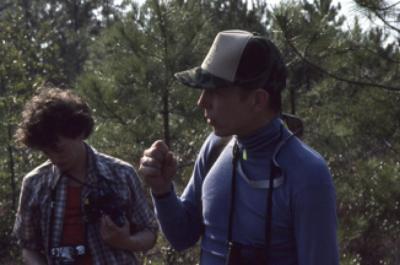 A favorite Bob/trip memory of was on the southeastern U.S. ornithology trip. We would often purchase lunch fixings (tortillas, refried beans, canned chilies, etc.) for our roadside lunches. A joke on the trip was that Bob would fend off others from his lunch supplies during these roadside lunches with a curt “no sharing.” Later in the trip, I snapped a pic (top) of a salad bar at a restaurant dinner stop to share at our traditional post-trip slideshow. Its inclusion was ironic and funny, as Bob was an inveterate sharer of knowledge (right), which in the field as in the classroom, was extensive. I never see a restaurant sign prohibiting sharing without cracking a smile and thinking of Bob. The Mexico trip also produced pics of Bob’s photogenic sides (below).
A favorite Bob/trip memory of was on the southeastern U.S. ornithology trip. We would often purchase lunch fixings (tortillas, refried beans, canned chilies, etc.) for our roadside lunches. A joke on the trip was that Bob would fend off others from his lunch supplies during these roadside lunches with a curt “no sharing.” Later in the trip, I snapped a pic (top) of a salad bar at a restaurant dinner stop to share at our traditional post-trip slideshow. Its inclusion was ironic and funny, as Bob was an inveterate sharer of knowledge (right), which in the field as in the classroom, was extensive. I never see a restaurant sign prohibiting sharing without cracking a smile and thinking of Bob. The Mexico trip also produced pics of Bob’s photogenic sides (below).
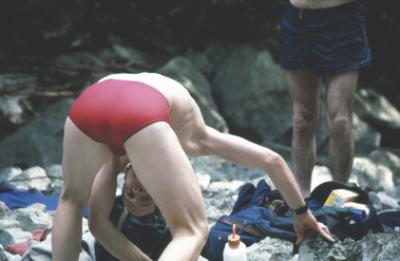
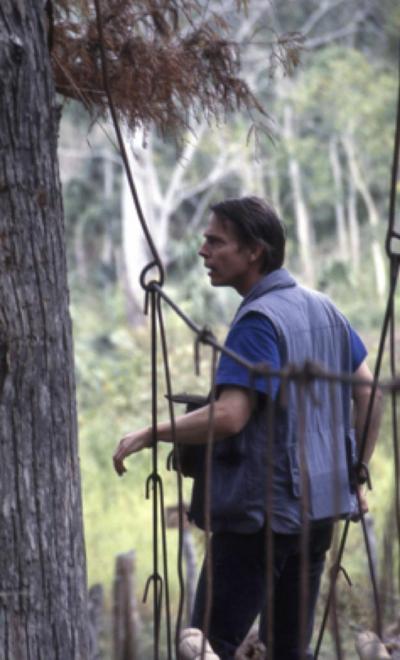
A Really Rare Warbler
By Dianna Noyes '80
When we learned of Mallory’s death and Bob’s diagnosis last summer, I was in Umbria, Italy, for the first time, looking out at a view that could have been one of Mallory’s paintings. When we learned of Bob’s death, we were in the desert on the outskirts of Tucson, Arizona—another new environment for me, but one that Bob knew and loved so well. In the short intervening months, I only saw Bob once, when I took him to a radiation appointment in Keene. We talked of many things, wandering around from subject to subject—mutual friends, birds, Italy, the Catholic Church, pedophiles, age, motorcycles. On the way home, we stopped at the Chelsea Royal for Mayan chocolate ice cream cones. We sat on a bench out back, overlooking the marshy field. It was a stunning late summer day. Red-winged blackbirds chortled on cattails. A little breeze wafted through. I looked at Bob, already diminished, already starting to disappear, and thought, “this may be the last time I see you, spend time alone with you. I’d better try to make you laugh,” for that is one of the things I loved most about Bob—his laugh. So I said something, and here it came, that muffled deep in the chest wave of glee that rose in pitch through his sternum and up his throat to come out his mouth in a little burst of delight and surprise. The thing that I did not say, and wish I had, was “thank you.” Thank you, Bob, for letting me believe in my nascent birding days that the brown creeper I saw in January was really a rare warbler. Thank you for pointing out my first redstart; for confiding in me that you weren't confident about presenting a talk on moss and lichens; for teaching generations of students whether we were in your classes or not; for the love, patience, and attention you bestowed upon us; and for the laugh that I can still hear and will always treasure.
A Uniquely Social Animal
By Tim Tibbitts '80
There are so many memories of Bob, it is hard to pick just a few. The breadth of his knowledge and skills as a biologist and teacher are legendary, and perhaps others have better stories than me. A different aspect on him occurred to me. You and another person or two made comments about Bob’s occasional somewhat antisocial moods. He even admitted as much, in some of his later visits and correspondence with me. But we all change with age, including characteristics like that. My memories of Bob from my time as a student, and for many years later, are that he was a uniquely social animal. He was very comfortable, very adept with making new acquaintances, and putting people at ease. I saw this in both his professional work and his social interactions. Examples:
His classroom technique was typically playful, mischievous and engaging. But absolutely thorough. He made learning an intellectual game. He effectively seduced people into learning and into gaining his passion for biology. When he made demands on students, it was not intimidating, it was encouraging. He could put you at ease at the same time he put you on the spot.
His persona out in the larger world was instructive and set an example for others. I remember visiting a small limestone cavern on private property in Texas (?) on a desert biology field trip. Our “guide” was a youngish woman who clearly was not much educated, nor very sophisticated. It was clear Bob knew a lot more about the geology, hydrology, and biology of limestone caverns in Texas than she did. But he was the epitome of grace and tact in talking with her as he taught us. He put her at ease, complimented her sincerely, and had yet another fan by the time we departed.
There was our stay at the university field station on South Water Caye off the coast of Belize in January 1980. The “university” was a large wood frame field house on an otherwise uninhabited spit of sand and coral rock. Two wonderful matronly Caribbean ladies cooked our meals and maintained the house. I remember lying in my sleeping bag on the wooden deck, trying to get to sleep, and hearing Bob and those ladies laughing it up down in the kitchen for what seemed like hours. Almost every night. They had very little in common with Bob, but there he was, gregarious and socializing and making new friends for himself and us.
In later years, I sometimes joined (or was joined by) Bob and John Hayes as they led subsequent desert biology field trips. I was impressed at how they continually improved their teaching. A lot of that was technical, but a lot was also the evolution and maturing of personalities. With time, Bob seemed even more relaxed and personable with his students and with the people they encountered on such trips. I remember them joining me and some coworkers on projects, and Bob was instantly familiar and casual with my peers. Even more, he drew them into discussions for the group, making them feel like they contributed to the teaching value of the outing. He didn’t have to do that, and he didn’t do it to be politic. He did it because that was his nature.
On one of his last visits with me in AZ, Bob did come alone, completely non-social, just him on his rented motorcycle. I was amused, as he fussed and tinkered with the bike in my carport. I marveled at how the Bob I first knew 30 years earlier (!) had morphed into a motorcycle enthusiast wearing what he called his full-body “moon suit.” He told me about how, several days earlier, he had gone into a small restaurant in rural eastern AZ wearing that moon suit. That is a geographic area I knew to be very suspicious of strangers, and people who “look different.” The story he told was hilarious, self-deprecating, wise and gracious. That was probably the last time I saw him. As always, he still gave off a glow.
Best Evidence Available
By Jim Tober
In 1983, when Bob was facing treatment for his leukemia, he walked me down the hall to his office where he had drawn a couple of lines on the blackboard—one descending and one ascending, with time on the horizontal axis.
What exactly the lines represented, I don’t recall, but clearly this graph summarized for Bob what was the best evidence available in deciding whether and when to undergo a marrow transplant. Waiting long enough but not too long was, I think, the bottom line.
Bob was an uncommonly good naturalist and teacher, clearly explaining complex realities with a personal observation, a succinct account of the most recent scholarship, a humorous story. And, he was a first-rate scientist, committed to rigorous, fact-based analysis, whether applied to to the marine rocky intertidal zone (his Ph.D. subject), proper motorcycle gear (a more recent passion), or his own highly consequential medical decision-making.
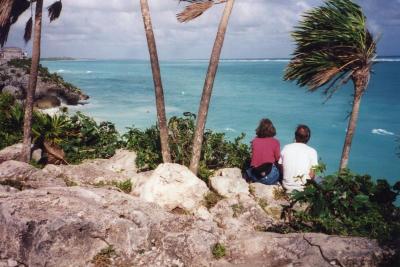 Forward to 1994/95 and the memorable field trip to Mexico and points south. I recently found my photographs from that trip which, true to form, feature too many images of Mayan sites and not enough of my fellow travelers. But, there are Mallory and Bob, sitting together looking out over the ocean near Tulum. I thought at the time I should capture that lovely scene, which is all the more lovely now.
Forward to 1994/95 and the memorable field trip to Mexico and points south. I recently found my photographs from that trip which, true to form, feature too many images of Mayan sites and not enough of my fellow travelers. But, there are Mallory and Bob, sitting together looking out over the ocean near Tulum. I thought at the time I should capture that lovely scene, which is all the more lovely now.
Fence Lizard on Her Face
By Joanne McNeil Hayes
Sceloporus occidentalis, for Bob
Fence lizard sunning on her face
sounds like a worrisome thing
but with sweet pearly eyes and
soft sticky bare feet
it clings to her cheek for a rest.
So there is no need to hide
from a critter dressed in
yellow striped pants
and sparkling blue vest
who stops by for just a brief visit.
Forests with Bob
By John Hayes
Jenny Ramstetter, in teaching Forest Ecology in spring 2018, asked some of us if we had photos of Bob in various forests. Most of us, unfortunately, just had slides from bygone pre-digital days. But that got me thinking about forests and some other habitats I had visited with Bob.
For Bob, the more diversity the better. Perhaps many would recall Bob's hand-typed desert plant lists. On most desert trips, we made it to the Mojave, but on some we didn't. But you can bet we spent more time in the species-rich Sonoran than in the other deserts. Something about those summer monsoons and winter rains.... But Bob was also fascinated by oak diversity in Big Bend National Park, Texas, in the Chihuahuan Desert. Then, when he spent a sabbatical on the Mexican plateau, he worked with a guy who was a reputed expert on oaks. Ultimately, I don't think he was impressed with the guy’s knowledge of the oaks. Bob said that because of hybridization the taxonomy was a mess.
I know that Bob was in awe of the irregularly flowering dipterocarp forest of the Borneo lowlands, as in the Danum Valley conservation area, with its 200 foot-tall trees. I have a slide somewhere of Bob and Kermit standing in front of one of those enormous buttressed trees.
He was also awestruck by the fauna diversity of the African savannah, as we saw in Namibia's Etosha National Park (Jenny was there).
Of course, who wouldn’t be awed by the redwood forests, but on our few field trips in that area, Bob made sure we visited Los Padres National Forest above Santa Barbara to see its incredible plant diversity, especially the manzanitas.
And I know Bob and John MacArthur were intrigued by warbler diversity in the Appalachian forests. Was it really nearly 60 years ago that Robert and John MacArthur published that Ecology article on bird species and foliage-height diversity?
Is there anywhere that didn't intrigue Bob? I think that you could have set him down anywhere on the planet, and he would have known where he was. How could one person know so much about so many plant and animal species?